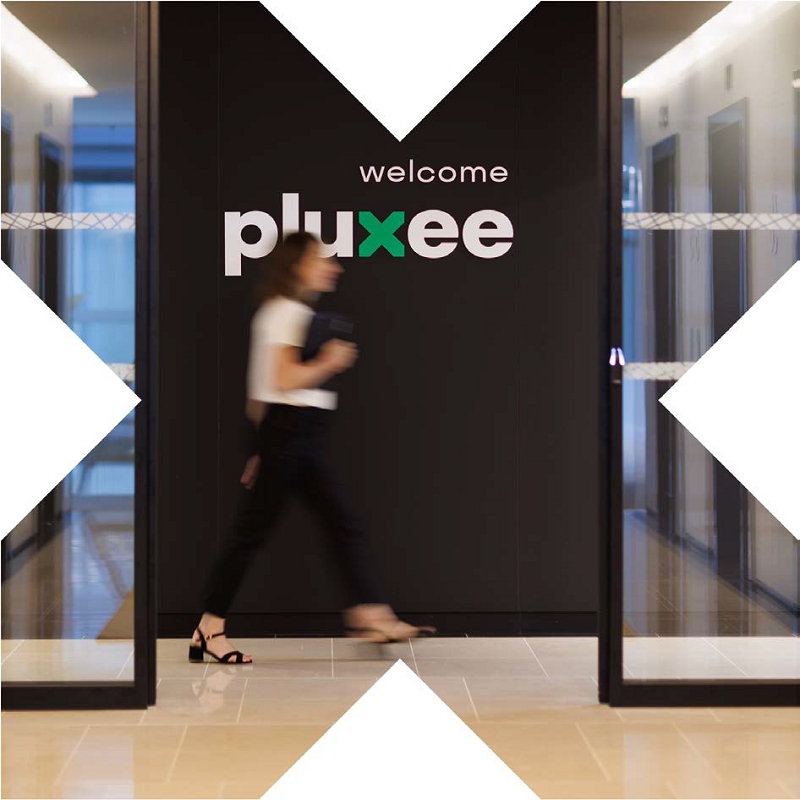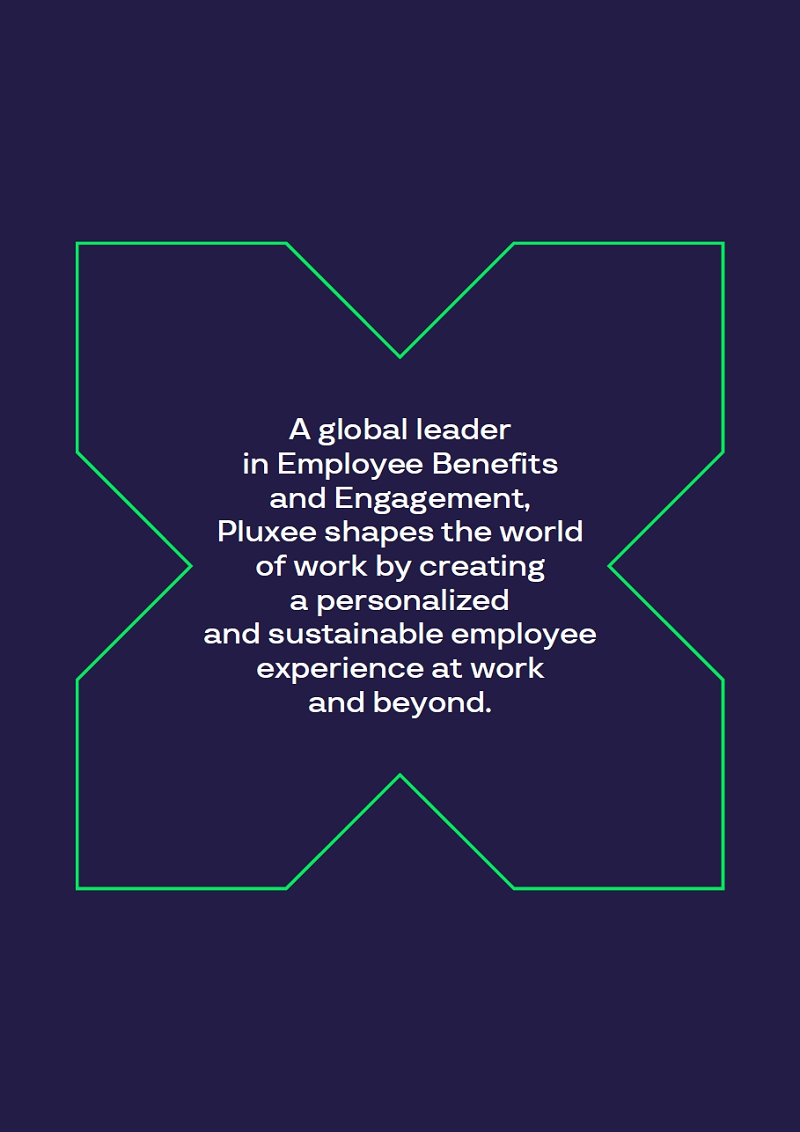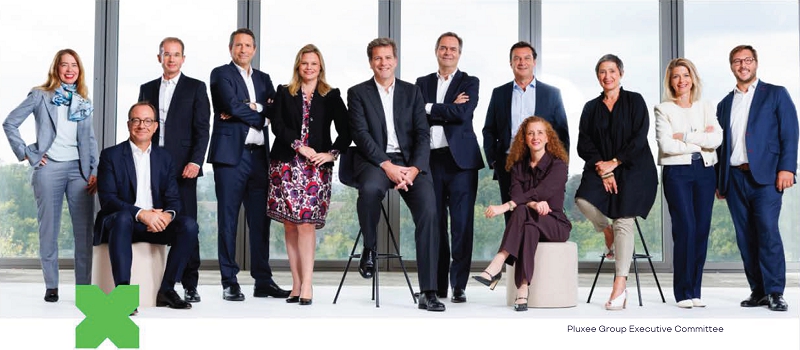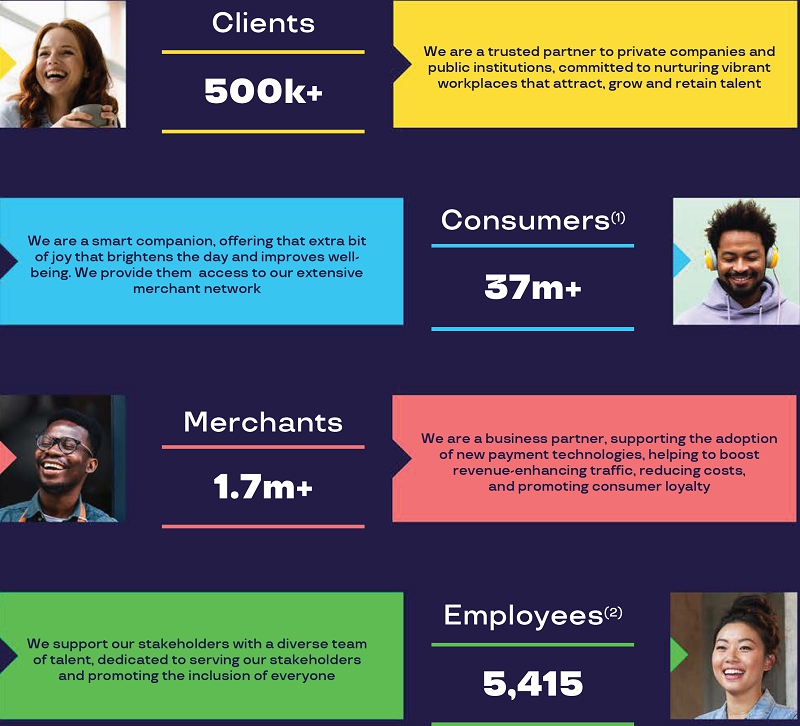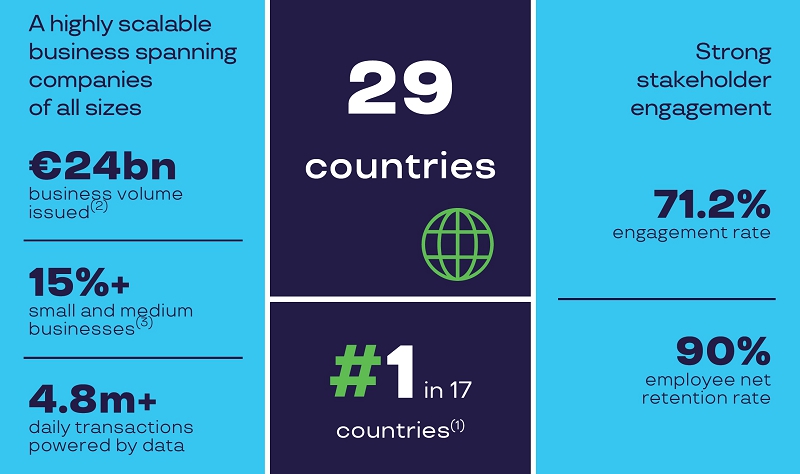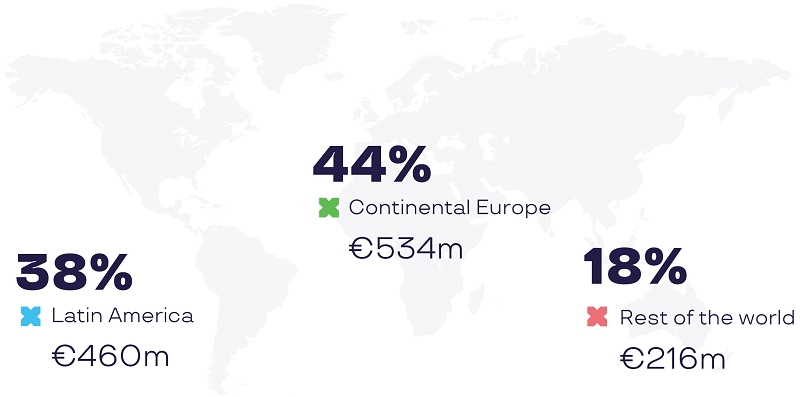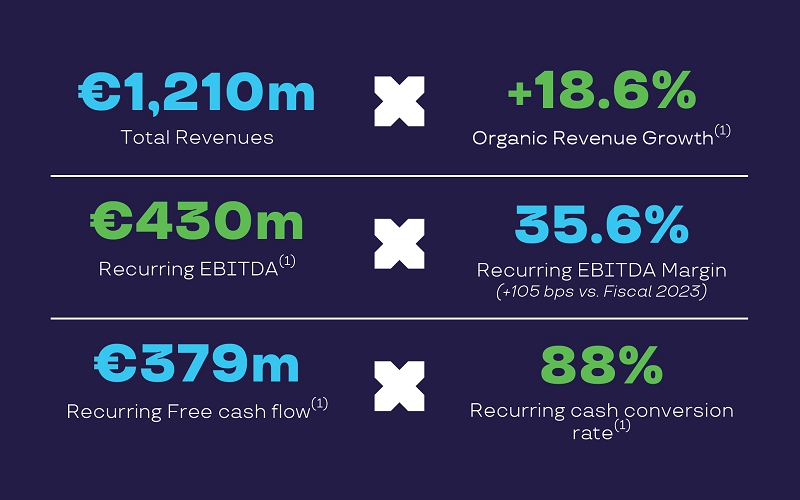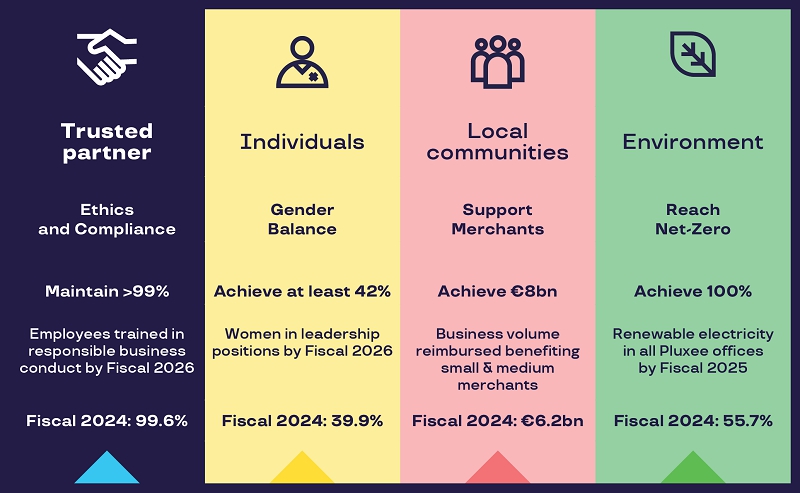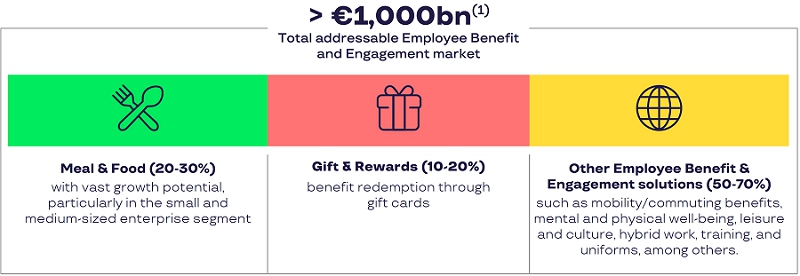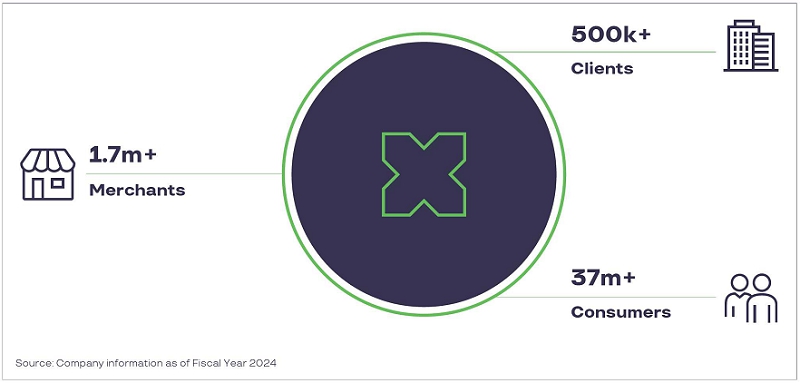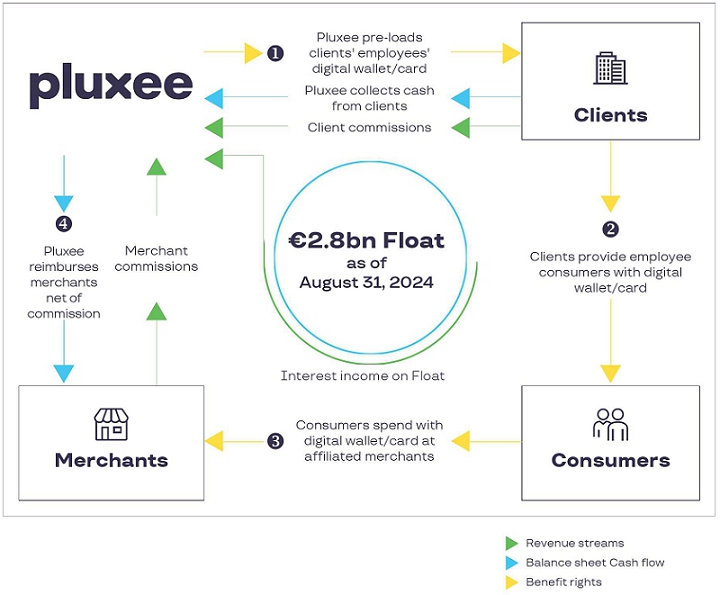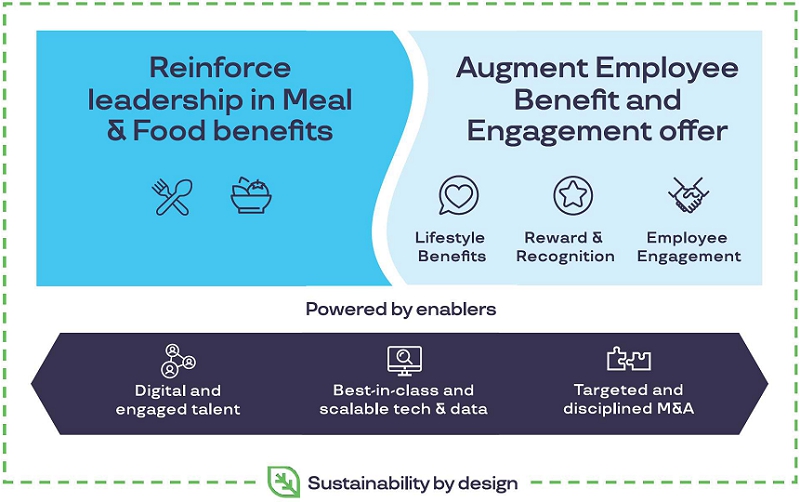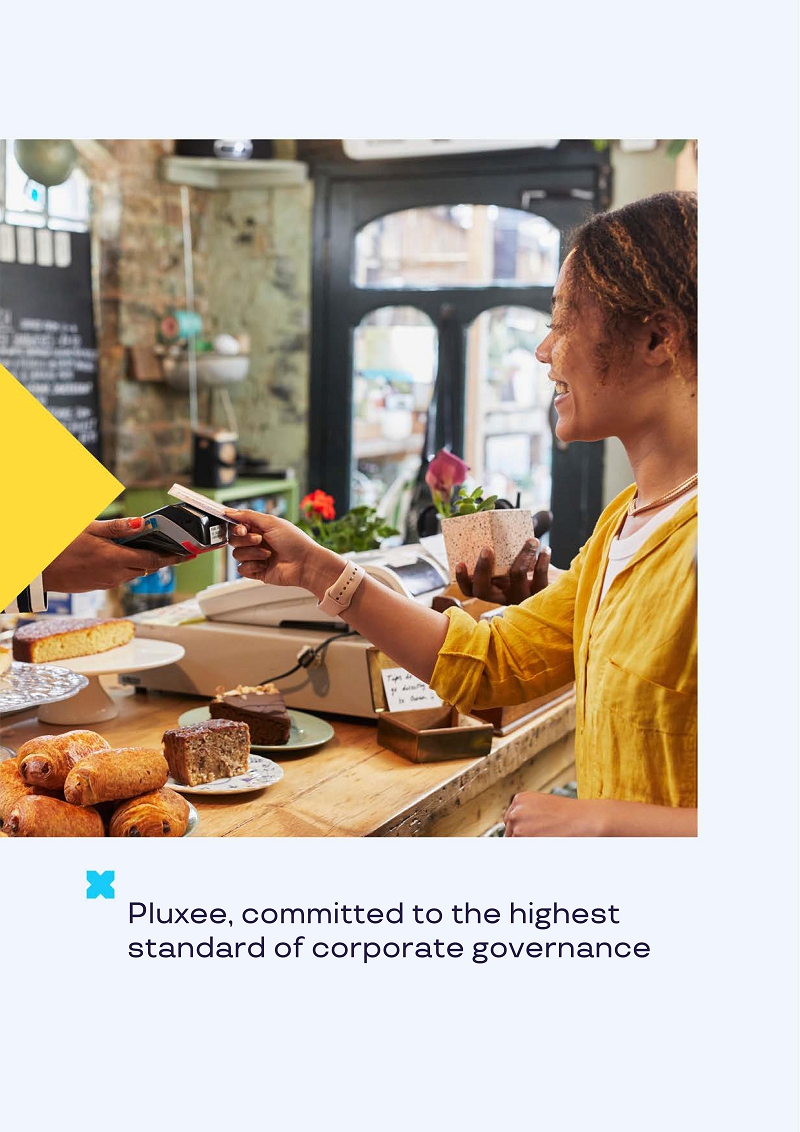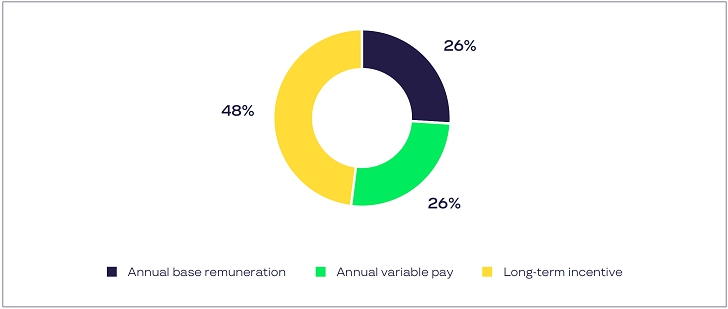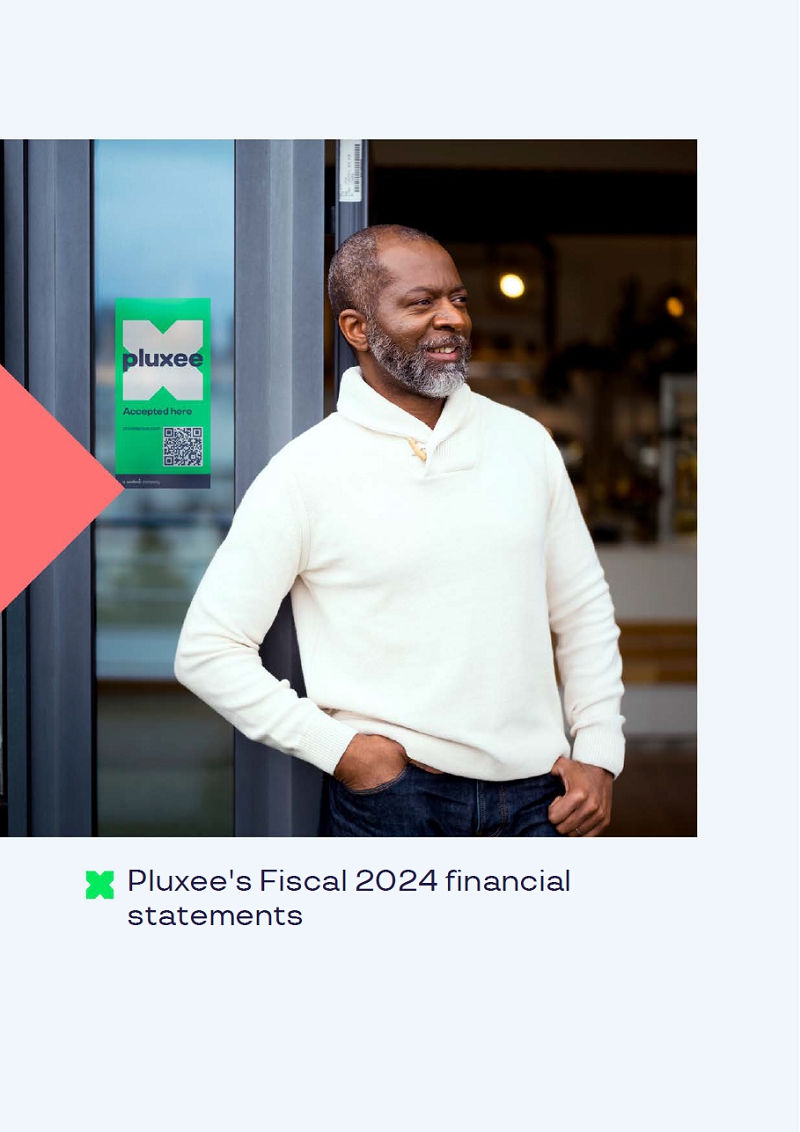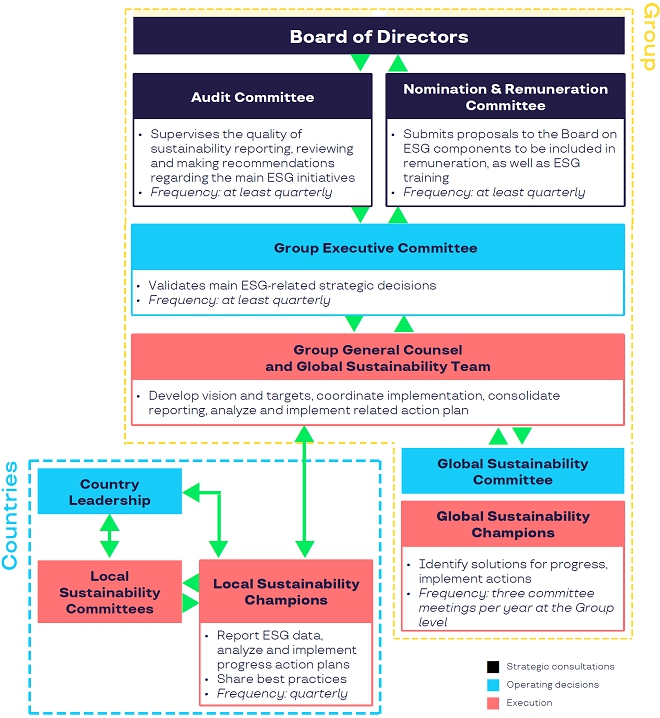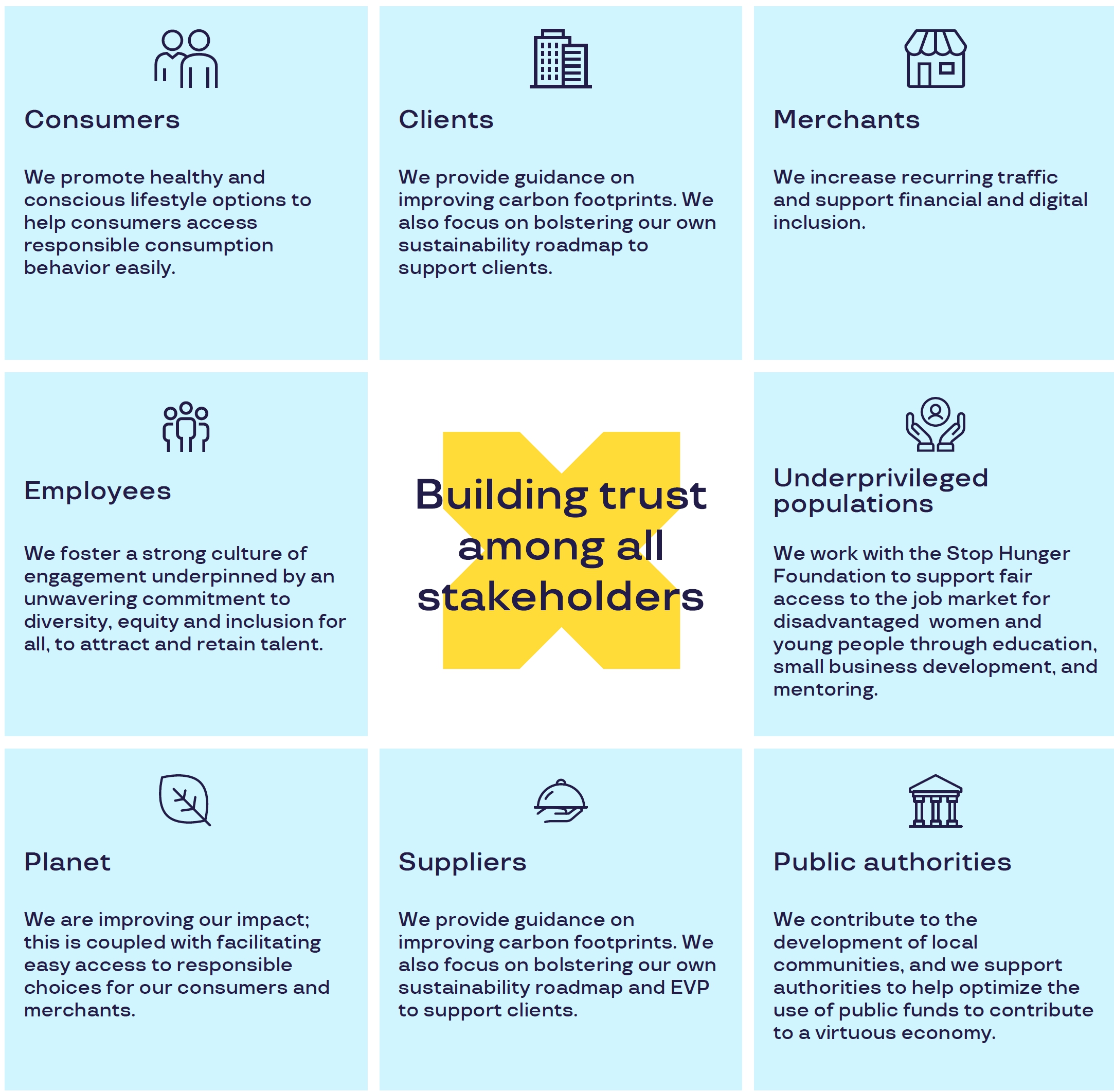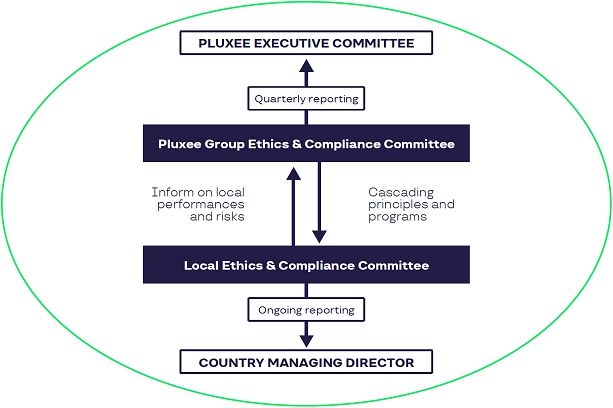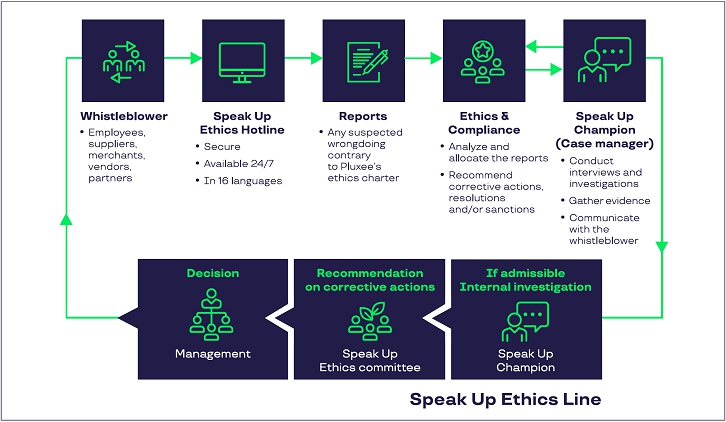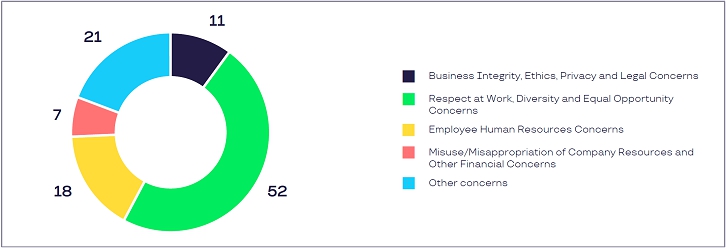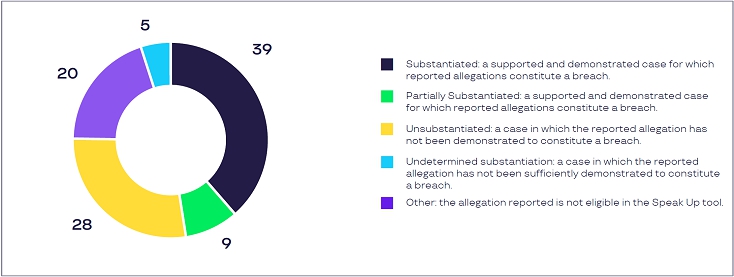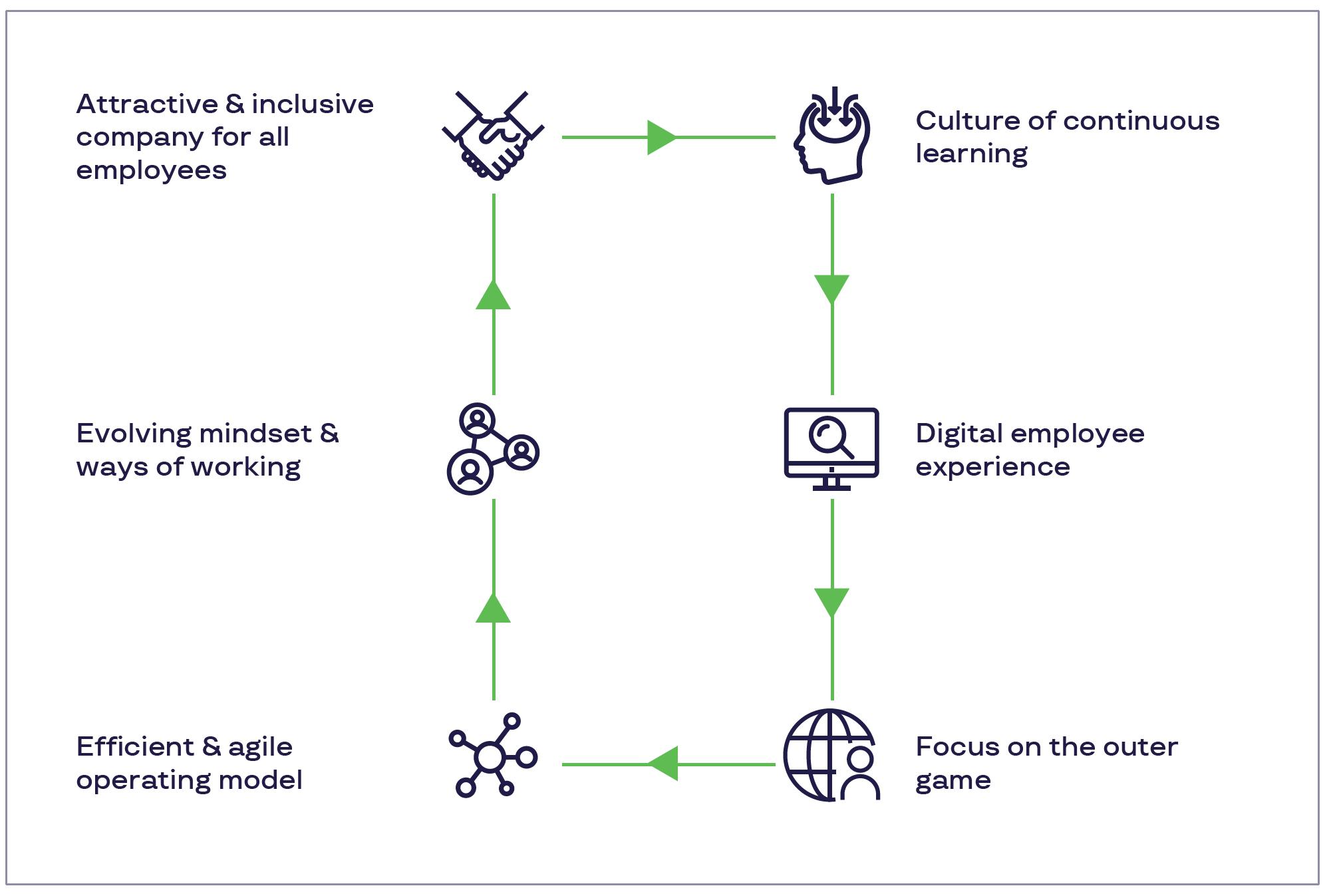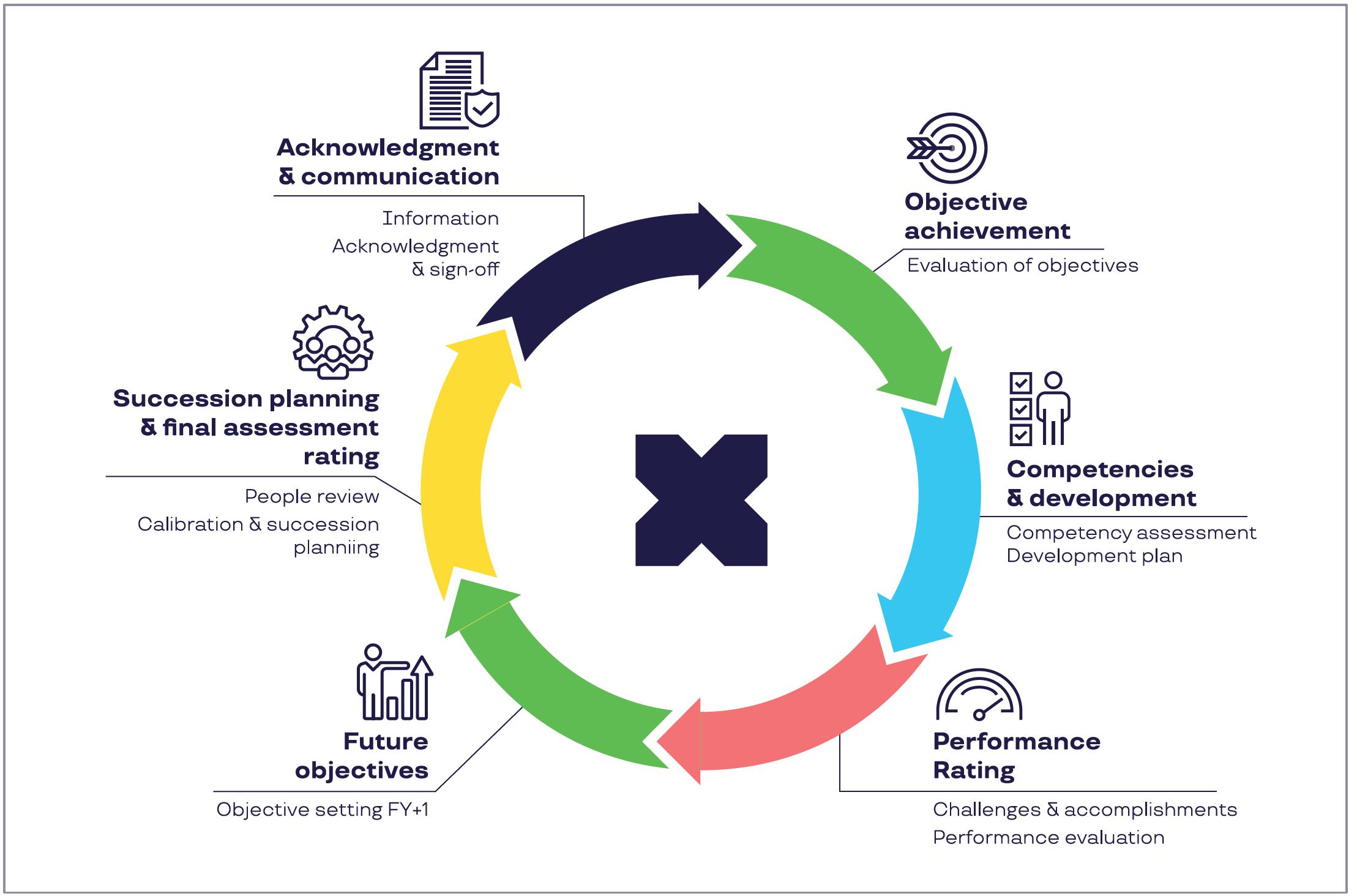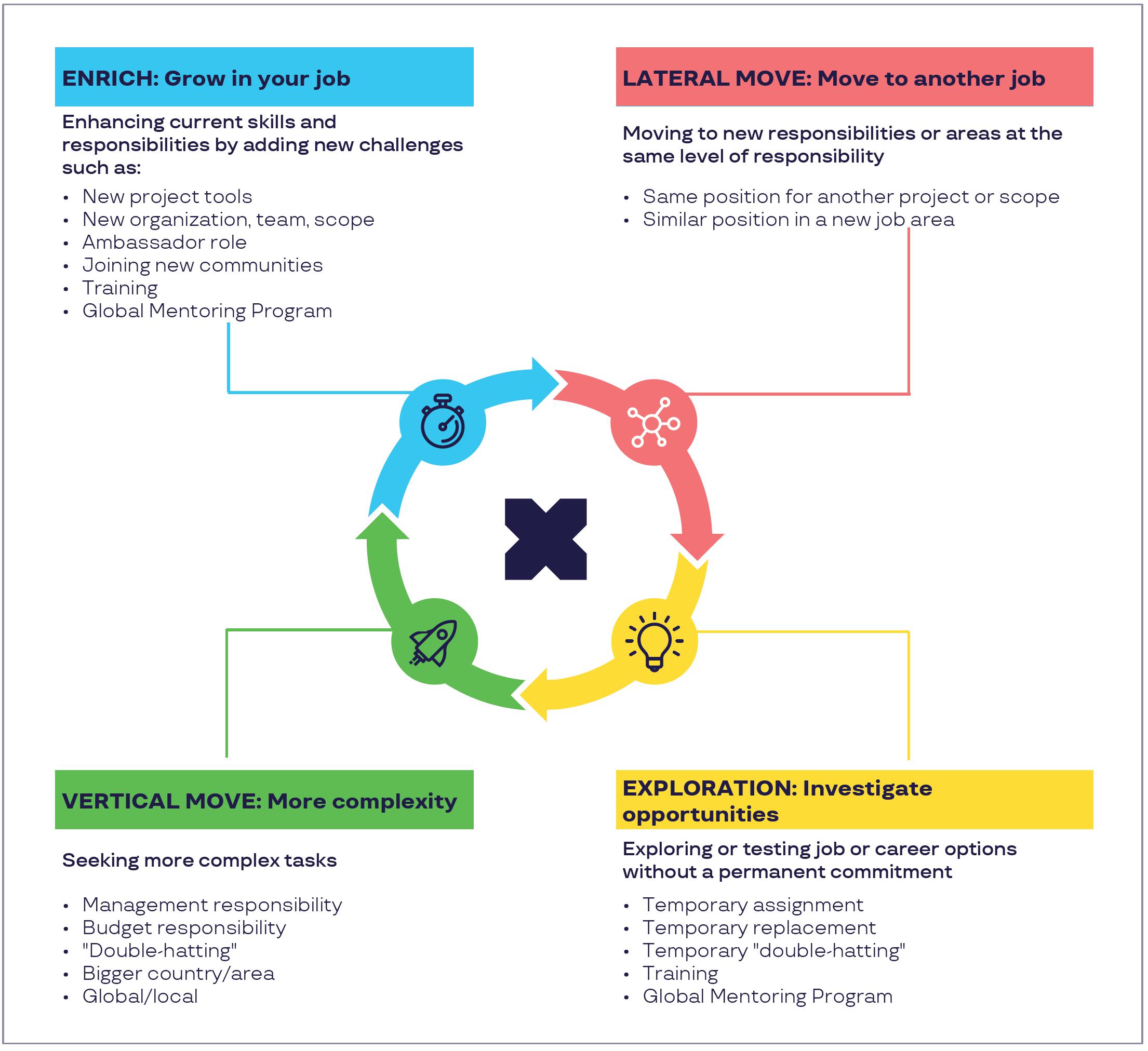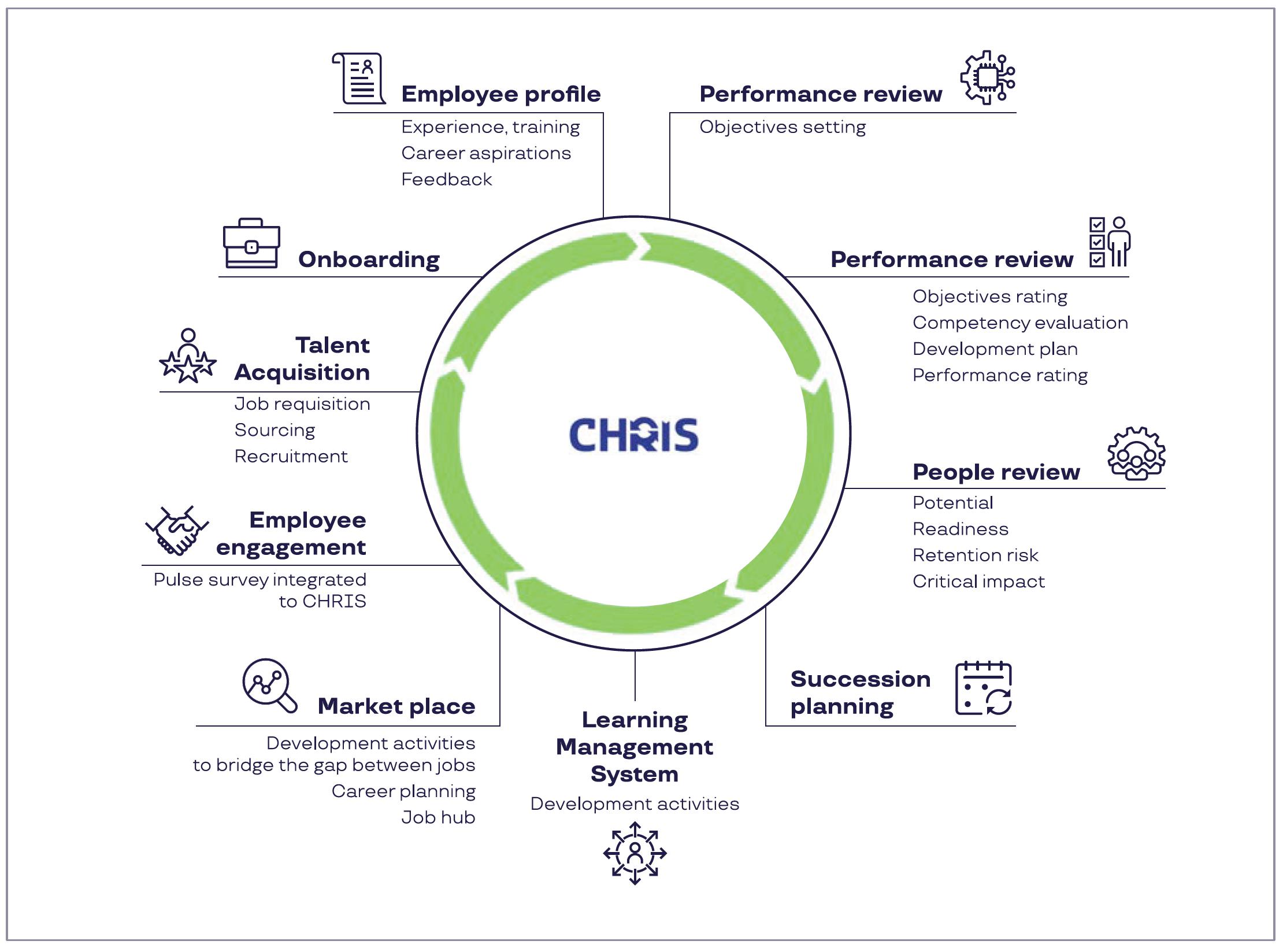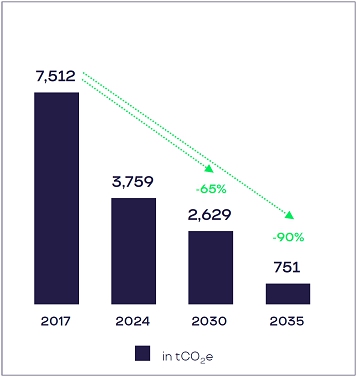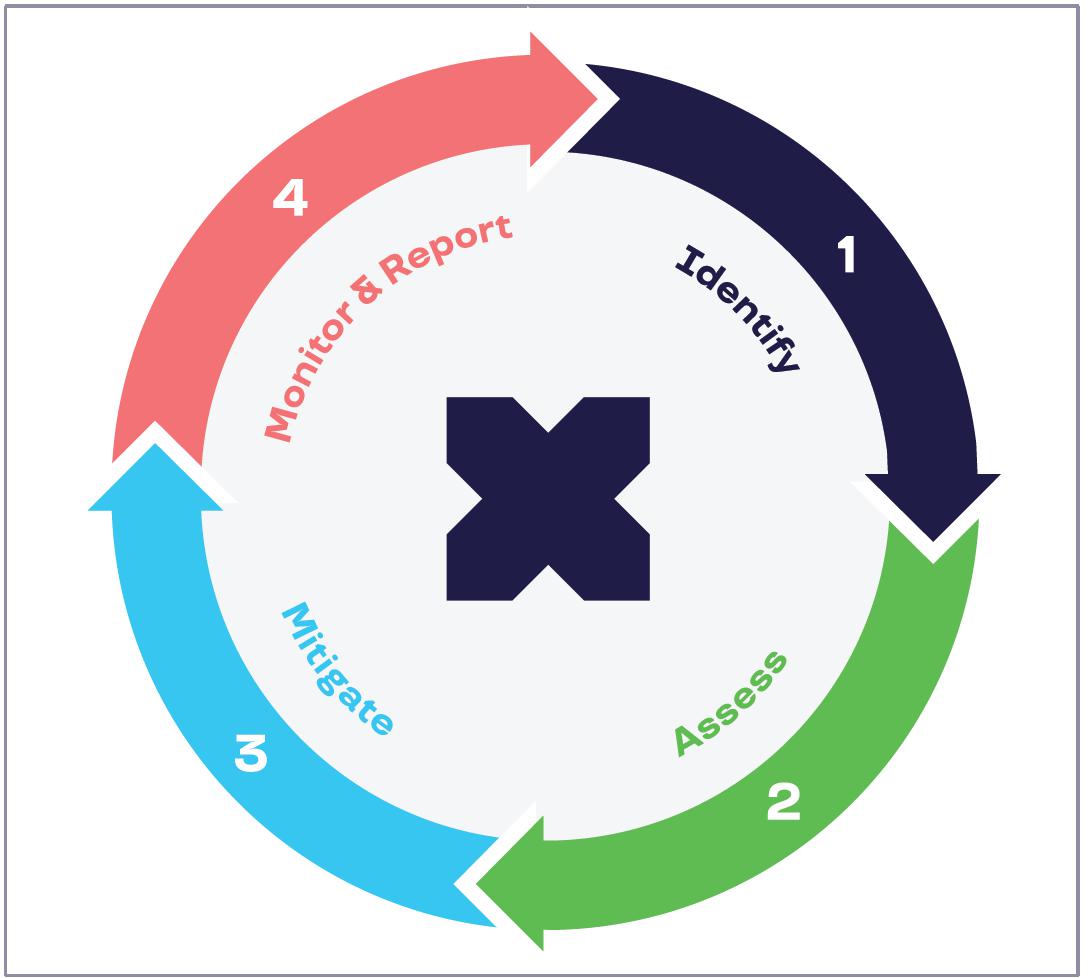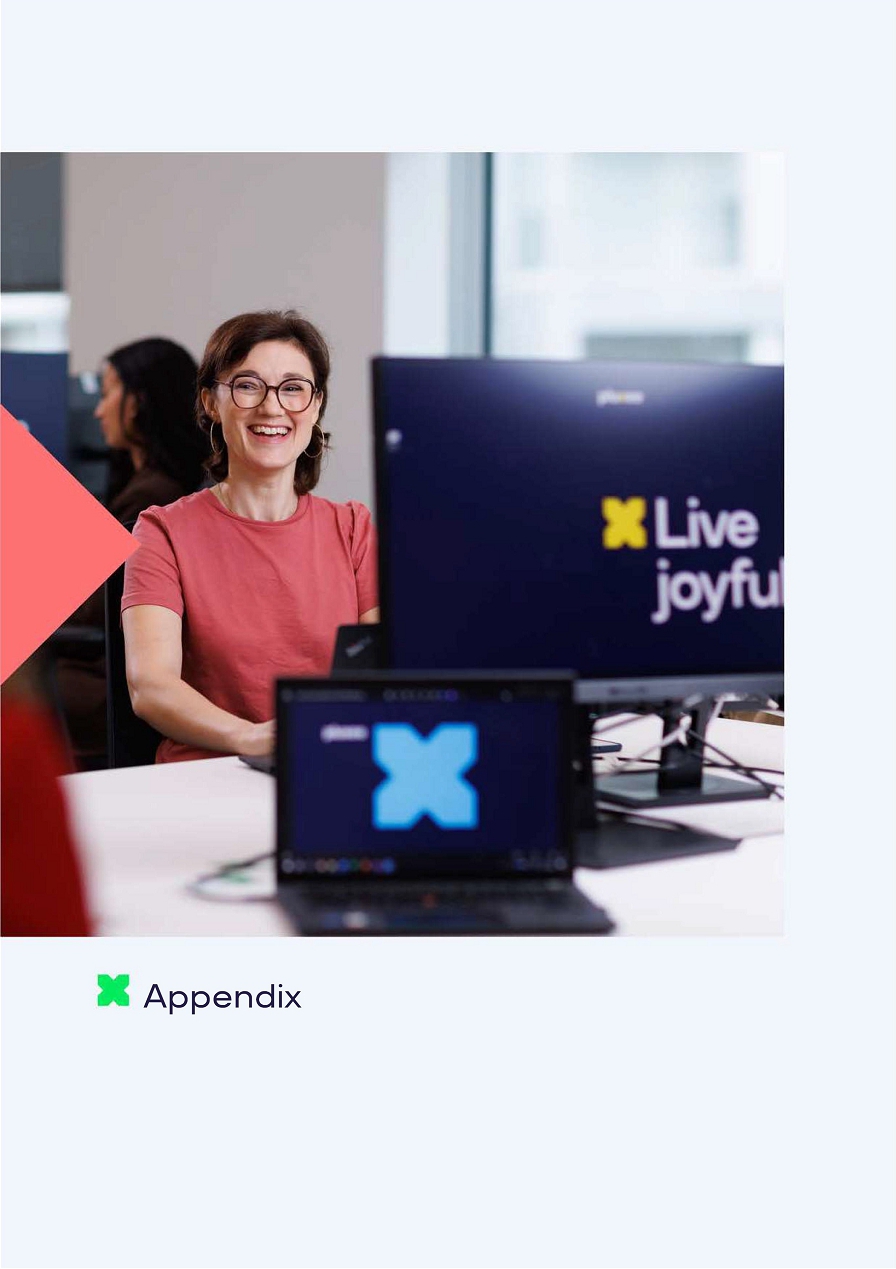Pluxee Annual Report 2024 2024
-
Cover
This copy of the annual financial reporting of Pluxee N.V. for the year ended August 31, 2024 is not presented in the ESEF-format as specified in the Regulatory Technical Standards on ESEF (Delegated Regulation (EU) 2019/815). The ESEF single reporting package is available at: https://www.afm.nl/en/sector/registers.
-
Introduction
“Pluxee has immense scope for growth. The ever-evolving employee engagement market has tremendous potential.”
Publishing our first annual report brings a sense of accomplishment. It marks the beginning of a new endeavor — a moment made possible by the people who laid the groundwork for Pluxee’s remarkable transformation. I especially want to thank our 5,400+ employees around the world, who have worked tirelessly to make this ambitious spin-off project a success. Every single one of them has met this challenge with enthusiasm, rallying around the shared goal of strengthening our position as a global leader in Employee Benefits and Engagement.
It has been an honor for me personally to join Pluxee as Executive Chair of the Board of Directors. My goal was to create a Board comprised of members whose experience spans technology start-ups and major publicly listed companies, individuals with strong expertise in digital technology, data management, cybersecurity, payment, human resources and other areas. I am grateful to all our Board members who bring their enthusiasm to Pluxee because they see its potential. And lastly, I want to recognize what a vote of confidence—and source of stability—it is to have the support of Bellon S.A. for this new chapter at Pluxee. Together, we will oversee the Group as it executes its strategy.
Pluxee has immense scope for growth. Attracting, retaining, and engaging employees is a significant challenge for companies of every size, in every geography, and in every sector. The ever-evolving employee engagement market has tremendous potential.
Meal and Food benefits are where Pluxee got its start, and we’ve remained at the forefront of changing workplace practices for years. Today, through the broad range of our offering, we want to be our clients’ partner for happy, healthy employees both at work and in their every day lives.
To navigate the next phase, Pluxee aims to drive profitable growth by reinforcing our leadership in Meal and Food benefits and augmenting our offer of Employee Benefit and Engagement solutions in targeted markets.
In Fiscal 2024 Pluxee went from success to success, starting with a flawless spin-off and listing on Euronext Paris on February 1. The Group has performed remarkably well, delivering Organic revenue growth of +18.6% up to 1.2 billion euros, and Recurring EBITDA of 430 million euros.
These excellent results demonstrate the soundness of our position as a pure player in Employee Benefits and Engagement. We have proven that we are up to the challenge and are in a strong position to accomplish our goals, continuing to create value for all of Pluxee’s stakeholders. I am delighted to support Pluxee as it delivers on its ambition over the coming year, bringing to life an enriching experience for employees.
1. Pluxee’s spin-off was a major milestone of 2024. What have you taken away from this exciting journey? It has been an exceptional year in every respect. We pulled off a challenging transformation of Pluxee and positioned it at the forefront of the Employee Benefit and Engagement market. We introduced our new brand, which embodies our positioning as a pure player in Employee Benefits and Engagement. We adopted an ambitious strategic plan, finalized our spin-off, successfully listed on the Euronext Paris stock market, and concluded our first M&A deal with the acquisition of Cobee in Spain. These achievements are driven by each of our employees around the world, and I want to highlight their efforts and thank them for all their hard work.
“We all share a common goal: delivering value to our clients, their employees, and our merchant partners, and ensuring their satisfaction.”
• first, we have the long-term support of Bellon S.A., and that’s a significant advantage as we implement our strategic plan; • second, we’ve strengthened our leadership team by appointing highly experienced, international executives to key positions and geographies; • lastly, we accomplished this transformation in a very short period of time, proving our agility and capacity to seize opportunities in a dynamic market. With these solid foundations, we’re well positioned and more determined than ever to begin the next chapter in Pluxee’s history.
2. What do you consider to be some of your most significant achievements in Pluxee’s first months as a standalone company? Pluxee has outperformed all the financial objectives it set for Fiscal 2024. Strong +18.6% Organic revenue growth, driving a significant increase in profitability, with Recurring EBITDA margin of 35.6% up +105 bps compared to Fiscal 2023, at current rates.
These results are partly due to very strong business momentum, with double-digit growth in business volume issued (BVI) in Employee Benefits. This solid performance reflects our ability to identify our clients’ needs and offer them new solutions that help improve the daily lives of their employees.
One of our many achievements is the multi-year agreement we’ve signed with Romania’s Ministry of Education, which is rewarding over 300,000 teachers with an attractive benefits program.
In France, we’re proud to have provided the Pluxee Restaurant Card to the security forces deployed for the Paris 2024 Olympic and Paralympic Games.
In Fiscal 2024, we also ramped up our growth in Brazil—one of our key markets—by completing our strategic partnership with Santander. Pluxee can now leverage this global bank’s 4,000 sales managers—2,500 of whom specialize in small and medium-sized enterprises (SMEs)—and access over 1.4 million Santander clients across Brazil.
These results demonstrate our commitment to executing our strategic plan. Everyone is on board, from the Executive Committee to our teams around the world, and we’re on track to meet our Fiscal 2026 objectives.
Our global operations in 29 countries offer us a nuanced understanding of the trends shaping the world of work, along with the ability to act on them. The Covid crisis disrupted people’s relationship with their work in a fundamental way. Employees now expect their employers to do even more to protect and increase their purchasing power and improve their well-being. Our solutions help companies meet these expectations and are a valuable asset for them. All companies face the same challenge—attracting and retaining employees.
All of which gives us a great opportunity to gain a larger share of a market already worth more than 1,000 billion euros.
Our strategy is based on two complementary pillars: First, we are strengthening our leadership in Meal and Food benefits. There remains significant untapped potential in this market, where only 10% of SMEs offer employee benefit packages. This is a key strategic priority for Pluxee: we aim to have new SME client accounts for more than 30% of our new business volume growth by the end of Fiscal 2026.
Second, we’re adding new benefits to our offer to meet the changing needs of employees. Our multi-benefit range, covering meals, food, gifts, and mental and physical well-being, is currently available in 16 countries and will expand to more than 20 by Fiscal 2026.
This strategy is supported by ongoing investments in our products, technology, data, and digital marketing. We are rapidly advancing in the use of artificial intelligence to provide more customized services and more efficient processes.
Originally, we catered to the desire of companies to offer their employees a nourishing meal and pleasant lunch break. Since then, lunch breaks have become a must in many countries around the world, and employees expect more than just meal vouchers.
Pluxee has reinvented itself to better address evolving expectations at work and beyond. We leverage our 45+ years of experience along with the agility and energy injected by the spin-off, and our new positioning as a pure player in Employee Benefits and Engagement. We operate in 29 countries, are market leaders in at least one vertical in 17 of them, and continuously enrich our extensive range of employee benefits, with 250 products and services.
With our laser focus on Employee Benefits and Engagement, we now also have more clout. We all share a common goal: delivering value to our clients, their employees and our merchant partners, and ensuring their satisfaction. They are all part of an interconnected ecosystem—with Pluxee as its driving force—that represents a business volume of 24 billion euros.
The essence of our business is to help everyone enjoy more of what really matters in their lives. This human dimension is paramount. That’s the spirit that drives Pluxee. Each one of us is motivated by the desire to enhance the employee experience.
To help shape Pluxee’s motivating culture, and define how we work together, we’ve created Life@Pluxee. With input from 1,200 employees, we’ve defined four core principles. Our aim is to:
But we won’t stop there. We’re using cutting edge technology from our partner, The Happiness Index, to measure our employees’ well-being and enthusiasm so we can closely follow their experience. That also means we’ll be able to adapt our HR policies and management style to better meet their needs.
At Pluxee, we believe progress comes from people working together. Today, we are a trusted partner for our clients, our affiliated merchants, and the people who use our services. These relationships are built on our commitment to making a positive impact on society and protecting the environment.
Every year, we support local economic development by generating 6.2 billion euros in business volume for SME merchants. We plan to increase it to 8 billion euros by Fiscal 2026. As a digital company, we also back numerous projects designed to help women enter digital professions, such as “Women in Tech”. Our Social Hub program in Brazil is enabling women running SMEs to develop the digital and management skills they need to grow their businesses.
And we are the first company in our sector to have adopted a Net-Zero trajectory to cut our carbon footprint by 2035. We’re working on every aspect of our operations and value chain to curb emissions.
“The human dimension is paramount. Each one of us is driven by the desire to enhance the employee experience.”
To start, we have optimized space use and electricity consumption and have transitioned to renewable electricity sources across our locations. And, when it comes to clients, we are developing and prioritizing virtual solutions, and increasing the use of alternative materials with a lower carbon footprint.
Pluxee delivered a solid performance in Fiscal 2024, and I’m excited about what the future holds for us. We have a clear goal: to support them as they navigate changes in the working world. We do this by meeting employee expectations on how to improve their purchasing power and well-being, and by making sure our clients, partners and consumers have what they need to make more responsible choices every day.
In a record time of nine months, Pluxee accomplished a successful spin-off while delivering a historically-high financial performance.
We shape the world of employee benefits and engagement by bringing to life a personalized and sustainable employee experience at work and beyond.
For over four decades, we have been contributing to making work not just a place to be, but a place to belong.
Driven by people and enabled by technology, we act as the beating heart of a rich ecosystem of stakeholders.
We are a trusted partner to private and public companies, committed to nurturing vibrant workplaces that attract, grow and retain talent.
We are a smart companion to employees – our clients’ and our own. We continuously evolve our digital and personalized solutions to transcend well-being, helping to build meaningful connections and communities.
We are a reliable ally to local businesses, working hand-in-hand to support their success and better serve their consumers.
Moving forward, our goal is to strengthen our positive impact on the communities of which we are a part. Whether it’s through our own continuous efforts or those of our partners, we are cultivating solidarity, diversity, inclusion and sustainability, in the pursuit of progress for all.
Pluxee delivers more than just benefits; it’s about paving the path toward a more joyful and meaningful life.
At Pluxee, we focus on delivering value to each of our stakeholders. We are constantly evolving our range of solutions to meet the changing needs of our entire ecosystem.
Source: Group information for Fiscal 2024 Total Revenues in million euros and percentage of Total Revenues.
(1) Countries where Pluxee is market leader in at least one vertical. (2) Business volume issued (BVI) corresponds to the cumulative value of benefits issued by the Group on behalf of clients in the form of paper vouchers, cards and digitally delivered services, and in respect of which commissions are charged to clients. (3) Percentage of total BVI accounted for by small and medium-sized businesses. Pluxee’s results as a standalone listed company underscore the progress made toward delivering the Group’s strategic growth plan and financial objectives. Strong business momentum continued in Fiscal 2024, with top-line growth outperforming expectations, and strong improvement in Recurring EBITDA margin.
Source: Group information as of Fiscal 2024. For more information, see section 3 Business Performance.
(1) Financial indicator not defined in IFRS, see section 3.5 Alternative performance measure (APM) definitions At Pluxee, sustainability priorities are embedded in our Strategic Growth plan. As a trusted partner to our stakeholders, we are committed to having a positive impact by driving business in local communities, supporting employee well-being at work, and preserving the planet. Together, we are building a world where sustainability and innovation go hand-in-hand, enabling people to live more joyful and meaningful lives.
-
1.1 Introduction to Pluxee
1.1.1 A global leader in Employee Benefits & Engagement
The Pluxee Group is an Employee Benefit and Engagement solutions pure player with significant Public Benefit activities.
The Group is the second largest provider worldwide of Employee Benefit and Engagement solutions, and the largest player in 17 countries in at least one benefit category locally, according to available public and market sources.
As of August 31, 2024, Pluxee delivers over 250 programs to clients in 291 countries. The Group sells a comprehensive suite of benefits to more than half a million clients across the globe, comprised of public and private companies spanning all sizes and industries, as well as public institutions.
The employee benefits provided by the Group help clients augment their employees’ compensation package in ways that are particularly engaging for employees and efficient for clients. Operating in a B2B2C model, Pluxee reaches 37 million+ consumers through its client base. These consumers have access to Pluxee’s proprietary merchant network comprised of 1.7 million+ partners and 600 delivery and e-commerce platforms (as of August 31, 2024).
Reflecting Pluxee’s mission to “bring to life a personalized and sustainable employee experience at work and beyond”, the Group provides a wide range of benefits through its rich network of merchant partners who offer meal, food, gift, mental and physical well-being services, mobility services, culture, and many other lifestyle benefits.
Pluxee thus contributes to increased purchasing power, healthy lifestyles, work-life balance, and eco-responsibility, reflecting the diverse needs of companies and their employees. The Group also provides reward and recognition programs to encourage behaviors in line with company goals and to recognize performance. All these solutions act as powerful levers to help clients attract, grow, and retain talent.
Driven by people and enabled by technology, Pluxee has developed an advanced and rapidly evolving digital ecosystem integrating three groups of stakeholders: clients, consumers, and merchants. This highly interconnected ecosystem is at the heart of Pluxee’s B2B2C business model.
This ecosystem provides a compelling consumer experience, seamlessly supporting daily, recurrent benefit usage such as meal, food and mobility benefits or more occasional interactions (mental and physical well-being, leisure, etc.). Consumers use pre-paid benefit cards, often fully virtualized, to make purchases at affiliated merchants’ points of sale, both physical and online. With 92% of its total business volume issued (BVI) digitalized on average over Fiscal 2024, Pluxee manages more than 4.8 million transactions daily.
Pluxee also provides digital interfaces and solutions to its clients to optimize their experience at each stage of their journey. These tech-enabled tools provide a smooth experience when onboarding new clients, interacting with existing ones, or assisting them when they consider purchasing new benefits. The Group has developed optimized client journeys for small and medium enterprises to facilitate their access to benefit products. Its digital solutions also enable merchants to go fully digital from affiliation to virtual payment and reimbursement tracking.
Pluxee is a reliable ally to local businesses, generating positive returns for merchants who benefit from access to recurring purchases from consumers, digital interfaces for their daily operations, and value-added services, all of which positively impact their top-line and efficiency.
Additionally, Pluxee leverages its know-how to help local authorities and public institutions reach people in need, facilitating the distribution of social benefits. The Group’s services help public authorities promote the welfare of vulnerable citizens by providing access to food, transport, and other social aid services. The Group also provides efficient means for public authorities to channel specific purpose funds to different groups of citizens to encourage specific spending behaviors (eco-responsible, buying local, etc.). Pluxee thereby enhances the effective distribution of public programs, leading to positive outcomes for a broad range of stakeholders.
The Group’s business model is based on corporate clients, who load funds representing the amount of benefits that their employees will spend, onto a Pluxee account. Funds from this account are paid out to merchants progressively as employees use their benefits in the merchant network. This pre-paid B2B2C model provides revenue sources from clients, merchants, and Float investment. It leads to a platform that initially requires volumes sufficient to amortize fixed costs, and eventually becomes scalable with growth (for more on Pluxee’s cash-generative business model, see section 1.3).
-
1.2 The Employee Benefit & Engagement Market
The Employee Benefit and Engagement market presents a very attractive growth opportunity, fueled by three powerful structural elements:
• Robust, sustained market growth underpinned by macroeconomic tailwinds in key countries, and the continuous growth of the employee population, particularly in developing markets; • The combination of compelling megatrends and supportive regulation in key markets, including an upward trend in the value of authorized tax exemption thresholds. These macroeconomic expectations and global trends lead to an estimated annual growth rate for the Meal and Food Benefit direct captured market in a range of 7 to 9% for Fiscal 2024 to Fiscal 2026.
Specific dynamics within job markets in Pluxee’s countries, and evolving consumer trends also underscore the growth case for the services Pluxee offers:
• the increase in demand for enhanced employee engagement solutions driven by competition for talent among companies; • the growing adoption of employee benefits, driven by increasing penetration of the small and medium-sized enterprise segment; • the positive impact of the shift to more work-from-home, with an evolution toward digital meal benefits or hybrid offers. 1.2.1 A large and underpenetrated market
(1) Total addressable Employee Benefit and Engagement market: Aggregate BV of all companies that are eligible to provide employee benefits, incl. those that do not offer these services to their employees. The size of the global addressable Employee Benefit & Engagement market in Fiscal 2024 was estimated to be more than 1,000 billion euros in business volume. This estimate takes into account the aggregate potential business volume of all companies that are eligible to grant employee benefits (regardless of whether or not they actually offer such benefits to their employees), calculated on the basis of:
• the estimated maximum allowance that could be granted to an employee as a benefit in a given country; • multiplied by the total number of employees that are eligible to receive employee benefits in that country. The markets for both employee benefits and engagement are estimated to be largely underpenetrated and to be growing dynamically and continuously.
Notably in Meal and Food, accounting for 20 to 30% of the total Employee Benefit & Engagement business, the market is estimated to grow on a 7 to 9% CAGR over Fiscal 2024 to Fiscal 2026, with a penetration rate that stands at approximately 25% of the total addressable market. Within Meal and Food, the small and medium-sized enterprise segment has a significantly lower penetration rate than larger companies, and provides a particularly compelling growth opportunity.
-
1.3 Pluxee’s Cash-Generative and Scalable Business Model
• 500,000+ clients, comprised essentially of large, small and medium-sized enterprises, whose human resources departments contract benefit products and services on behalf of their employees; • 37 million+ consumers, comprised of the employees who are granted Pluxee-branded benefits by their employers; • 1.7 million+ merchants sell their products which are redeemed through Pluxee’s various benefit products and solutions. Pluxee operates a prepaid business, collecting cash from clients when they order the Group’s solutions, and then loading the cards and digital wallets of the clients’ employees, the end-consumers. The amount loaded onto cards and digital devices corresponds to the Group’s business volume issued (BVI). The end-users, or consumers, then spend their benefits within the merchant network. Finally, the Group reimburses the merchants (business volume reimbursed, or BVR). This model generates three main sources of revenue:
The Float is made up of the cash collected from clients before employee benefits are issued. It remains on Pluxee’s balance sheet until these funds are reimbursed to the merchants where the end-consumers disbursed their benefits. At August 31, 2024, the Float stood at 2.8 billion euros.
Pluxee thus operates a highly scalable B2B2C business model: in which more business volume leads to revenue growth, which in turn positively impacts Pluxee’s profitability.
-
1.4 A Value Proposition for All Business Stakeholders
1.4.1 A customized value proposition
Pluxee offers a value proposition that fits the needs and requirements of each stakeholder in its B2B2C ecosystem.
 Clients
Clients Merchants
Merchants Consumers
ConsumersPluxee is a tech-enabled partner, providing attractive solutions that can:
• Provide tax-effective, compliant, secure, and flexible benefit solutions for employees
• Increase employee engagement
• Ensure seamless onboarding and excellent customer support
Pluxee is a trusted business partner that can help drive:
• Predictable traffic with access to recurring consumers
• An incremental revenue stream
• Augmented digital presence and local visibility
Pluxee enhances the employee experience by:
• Augmenting purchasing power
• Providing a broad choice of merchant options
• Providing multiple consumption and payment possibilities as well as simplified expense processes
-
1.5 Pluxee’s Profitable Growth Strategy
Pluxee is delivering on the roadmap it published in January 2024 at its Capital Markets Day. The Group’s strategic plan aims to drive ongoing profitable growth by combining global scale and deep local roots to further address a large underpenetrated market with high growth potential. Pluxee’s competitive advantages enable the Group to accelerate the expansion of its Employee Benefit and Engagement products and solutions.
1.5.1 Key pillars and foundational enablers
To consolidate and amplify its strong market position and to continue to drive profitable growth, Pluxee builds the expansion of its business on two key strategic pillars:
-
2.1 Corporate governance
This section of the Annual Report describes relevant elements of Pluxee’s corporate governance practices and provides the information required by the Dutch governmental Decree on Corporate Governance (Besluit inhoud bestuursverslag). This section also includes an explanation of how Pluxee applies the principles and best practices of the Dutch Corporate Governance Code (the “Code”), and the Dutch governmental Decree on article 10 of the Takeover Directive 2004/25 (Besluit artikel 10 overnamerichtlijn). The Code, which was updated on December 20, 2022, is publicly available on the website of the Dutch corporate governance code monitoring committee at www.mccg.nl.
Pluxee N.V. is a public limited liability company (naamloze vennootschap) governed by the laws of the Netherlands (in particular volume 2 of the Dutch civil code), the Code (on a comply or explain basis) and by its articles of association (the “Articles of Association”). The corporate seat of the Company is in Amsterdam, the Netherlands. Since its incorporation the Company has, and intends to continue to have, its place of effective management and sole registered location in France, moved during Fiscal 2024 at the Company’s address, 16 rue du Passeur de Boulogne, 92130 Issy-les-Moulineaux, France. The Articles of Association are publicly available on Pluxee N.V.’s website at www.pluxeegroup.com/board-of-directors.
Pluxee N.V. is subject to various legal provisions of the Dutch financial supervision act (Wet op het financieel toezicht) and of the Dutch financial reporting supervision act (Wet toezicht financiële verslaggeving). In addition, given that its shares trade on the regulated market of Euronext Paris, Pluxee N.V. is also subject to certain French laws and regulations.
2.1.1 Board of Directors
In accordance with its Articles of Association, Pluxee has a one-tier Board of Directors consisting of one Executive Director and nine Non-Executive Directors. The Board of Directors appointed the Executive Director as Executive Chair, as well as a Lead Director from among the independent Non-Executive Directors who serves as the chairperson (voorzitter) of the Board under Dutch law and within the meaning of the Code. The Board did not designate any vice chair. The Company adopted this governance structure on January 31, 2024 in the context of the Spin-off. Prior to that date the Company had a sole managing director.
• define, in cooperation with the Chief Executive Officer, the strategy and propose it to the Board for approval; • demonstrate the highest values of integrity and probity, giving very clear guidance and expectations regarding the Company’s culture and values, and dedicate sufficient time, energy and attention to ensure the diligent performance of its duties; • ensure, in cooperation with the Lead Director, that the Board work and functioning meets the defined standards of corporate governance; • assume all relevant responsibilities defined in the Board Rules; and • supervise and support the Chief Executive Officer. • the Non-Executive Directors have proper contact with the Executive Directors, and the General Meeting; • there is sufficient time for deliberation and decision-making by the Board and that the Directors receive all information that is necessary for the proper performance of their duties in a timely fashion; • the Board and the Committees have a balanced composition and function properly; • the functioning of individual Directors is reviewed at least annually; • the Directors follow their induction program, as well as their education or training program; • the Executive Directors perform activities in respect of corporate culture; • the Board is responsive to signs of misconduct or irregularities from the Company’s business; and • effective communication with the Company’s shareholders is assured. The Board is entrusted with the management of the Company subject to the restrictions contained in the Articles of Association and the law. This includes setting the Company’s policy and strategy. The Board may allocate its duties among the Directors by means of the Board Rules or otherwise in writing, with due observance of any limitations provided for by law or in the Articles of Association. The Board may determine in writing, in or pursuant to the Board Rules or otherwise pursuant to resolutions adopted by the Board, that one or more Directors can validly pass resolutions in respect of matters which fall under his/their duties. In performing their duties, Directors shall be guided by the interests of the Company and of the business connected with it.
The Executive Director, i.e., the Executive Chair, shall be entrusted primarily with the Company’s day-to-day operations and the Non-Executive Directors shall be entrusted primarily with the supervision of the performance of the duties of the Directors as specified in the Articles of Association and the Board Rules. The Non-Executive Directors also perform any duties allocated to them under, or pursuant to, the law and the Articles of Association.
The power to represent the Company vests in the Board of Directors and in the Executive Chair individually. The Board vested the salaried Chief Executive Officer, Aurélien Sonet, with representation powers pursuant to a power of attorney included in the Board Rules. The Chief Executive Officer is supervised by the Executive Chair, who in turn has limitations of authorities from the Board of Directors. These limitations and authorities are reflected in the Board Rules (see section 2.1.1.3).
Pursuant to the Articles of Association, the Board has established Board Rules concerning its organization, decision-making and other internal matters, with due observance of the Articles of Association. In performing their duties, the directors act in compliance with the Board Rules. The Board Rules are available on the Company’s website (www.pluxeegroup.com).
This section deals with the rules included in the Articles of Association and the Board Rules which support and apply to the above-mentioned governance structure of the Company.
The Articles of Association provide that the Board consists of one or more Executive Directors and one or more Non-Executive Directors. The Board shall be composed of individuals. The Board shall determine the number of Executive and Non-Executive Directors. Pursuant to the Board Rules, the Board shall be composed of at least eight Directors, consisting of one or two Executive Directors and, for the remainder, of Non-Executive Directors.
The Board may designate as Chief Executive Officer an Executive Director or any other employee or officer of the Company or Group Companies. The Board may also designate an Executive Director as Executive Chair. The Board shall further designate a Non-Executive Director as the Chair of the Board (voorzitter) for purposes of Dutch law. Such Non-Executive Director will carry the title “Chair”. However, if, and for as long as an Executive Chair is elected, the Chair of the Board (voorzitter) for purposes of Dutch law will carry the title of “Lead Director” instead of the title “Chair”. Certain duties and powers of the Chief Executive Officer, the Executive Chair and the Chair or Lead Director, as applicable, are set out in the Articles of Association and the Board Rules. If and for as long as (i) a Chief Executive Officer has been elected who is not an Executive Director and (ii) an Executive Chair has been elected, the Board’s tasks and responsibilities, as well as its decision-making authority, in respect of the matters that are delegated to the Chief Executive Officer pursuant to the Board Rules are instead delegated to, and shall be resolved upon by, the Executive Chair. The Executive Chair shall then authorize the Chief Executive Officer to implement and effect such matters under the supervision of the Executive Chair and ensure that the appropriate checks and balances are put in place to ensure appropriate oversight over the Chief Executive Officer’s exercise of its authorities set out in the Board Rules. The Board may designate one or more other Non-Executive Directors, other than the Chair or Lead Director, as applicable, as Vice-Chair.
The General Meeting shall appoint the Directors and may at any time suspend or dismiss any Director. Upon the appointment of a person as a Director, the General Meeting shall determine whether that person is appointed as Executive Director or as Non-Executive Director. In addition, the Board may at any time suspend an Executive Director. A resolution of the General Meeting to suspend or dismiss a Director can be passed by simple majority of votes cast representing more than one third of the issued share capital. A second meeting as referred to in article 2:120(3) BW cannot be convened. If a Director is suspended and the General Meeting does not resolve to dismiss him or her within three months from the date of such suspension, the suspension shall lapse.
Pursuant to the Board Rules, a person may be appointed as Executive Director or Non-Executive Director for a term up to the end of the annual General Meeting held in the fourth calendar year after the year of appointment, without limitation on the number of consecutive terms which an Executive Director or Non-Executive Director may serve. The Board drew up a rotation schedule for the Non-Executive Directors which may evolve over time, to achieve a staggered end to terms of office.
Resolutions of the Board shall be passed by a simple majority of votes cast, unless the Board Rules provide otherwise. Each Director entitled to vote may cast one vote in the decision-making of the Board. Where there is a tie in any vote of the Board, the Executive Chair has a casting vote, except for certain resolutions in which the Executive Chair shall not take part as set forth in the Board Rules (§6.15 referring to article 19.6 of the Articles of Association): the determination of the compensation of Executive Directors; and the instruction of an auditor to audit the annual accounts if the General Meeting has not granted such instruction. Otherwise, the relevant resolution shall be rejected.
Under the current set up, the Board shall meet as often as the Lead Director or the Executive Chair or any group of three directors jointly deem(s) necessary or appropriate and at least quarterly. A Board meeting may be convened by, or at the request of, the Lead Director, the Executive Chair or a group of three directors jointly by means of a written notice sent to all directors.
The Board’s meetings may take place virtually or at a physical location, and they are normally held at the Company’s offices in France, or another location in France, with the Executive Directors, the Chair or the Lead Director (as applicable), and a majority of directors physically attending. Meetings may only incidentally take place virtually. In compliance with the above principles, the form and location of the meetings will be determined by the Director convening the meeting as desirable given the circumstances.
Subject to the previous paragraph, Directors entitled to vote shall be given the opportunity to attend the meeting of the Board by telephone, videoconference or electronic communication, provided that (i) all participants can hear each other simultaneously, and (ii) Directors are not physically located in the Netherlands during such meeting unless exceptional circumstances require this. The Lead Director or the Executive Chair determines whether exceptional circumstances apply. Directors attending the meeting by telephone, videoconference or electronic communication are considered present at the meeting.
A Director can be represented by another Director entitled to vote holding a written proxy for the purpose of the deliberations and the decision-making of the Board.
The approval of the General Meeting is required for resolutions of the Board concerning a material change to the identity or the character of the Company or the business, including in any event:
• transferring the business or materially all of the business to a third party; • entering into or terminating a long-lasting alliance of the Company or of a Group Company either with another entity or company, or as a fully liable partner of a limited partnership or general partnership, if this alliance or termination is of significant importance for the Company; and • acquiring or disposing of an interest in the capital of a company by the Company or by a Group Company with a value of at least one third of the value of the assets, according to the balance sheet with explanatory notes or, if the Company prepares a consolidated balance sheet, according to the consolidated balance sheet with explanatory notes in the Company’s most recently adopted Annual Accounts; provided that the absence of approval of the General Meeting shall not affect the powers of representation of the Board or of the Directors.
Pursuant to the Articles of Association and the Board Rules, resolutions of the Board may, instead of at a meeting, be passed in writing, provided that all directors are familiar with the resolution to be passed and none of them, insofar as entitled to vote, objects to this decision-making process.
The Nomination and Remuneration Committee oversees the induction and training programs and provides advice on the annual training provided to Directors. This program covers strategy, governance and legal affairs, financial, social and sustainability reporting by the Company, specific aspects that are unique to the Company and its business, the Company’s culture and the responsibilities of Directors.
• the legal aspects of being a Director of a Dutch company listed on Euronext Paris as well as directors’ duties, corporate bodies functioning and disclosure requirements; • key drivers of the current Company strategy including the description of the competitive landscape and the business components; • preparation of the Group for the CSRD (ESG-related reporting), review of the Group’s activities relating to the Ethics Charter. In addition, each Non-Executive Director will be, as part of the Board annual evaluation, able to identify the aspects on which he or she requires training or education.
The Non-Executive Directors also discussed and received regular updates during Board meetings on commercial developments and the competitive landscape, notably with commercial and financial related KPIs.
On July 3, 2024 the Board of Directors adopted “Share ownership guidelines for members of the Board of Directors” whose purpose is to align the directors’ interests with the long-term interests of the shareholders of Pluxee: each member of the Board is expected to buy and own at least 500 ordinary shares by the end of his/her first year on the Board, and to hold them from that date until the end of the term of his/her office with Pluxee. Each Director shall comply with all legal trading obligations/prohibitions laid down in the “Insider Trading Prevention Policy” as approved by the Board.
-
2.2 Diversity, equity and inclusion
In accordance with the Code, the Company’s Board adopted a diversity, equity and inclusion policy made available on Pluxee’s website (the “DE&I Policy”). The DE&I Policy set specific, appropriate and ambitious targets in order to achieve a satisfactory balance in gender diversity and the other diversity and inclusion aspects of relevance to the Company.
• In respect of the Board’s composition, the gender diversity target for each of (i) the group of Executive Directors, and (ii) the group of Non-Executive Directors separately was set at a minimum of 40% female and a minimum of 40% male, provided that if the group of Executive Directors would be comprised of only one member, this gender diversity target applies to the Board as a whole. • The Board determined in the DE&I Policy the category of employees in managerial positions and the applicable objective: Pluxee shall continue to improve gender diversity in Fiscal 2024 with a focus on increasing the representation of women in Management Positions1 and reaching a ratio of at least 40% women by Fiscal 2026. In addition, end of Fiscal 2026 target on women ratio in Pluxee Leadership2 is 42%. -
2.3 Potential conflicts of interest
Pursuant to Dutch law and the Articles of Association, a Director shall not participate in the deliberations and decision-making of the Board on a matter in relation to which he or she has a direct or indirect personal interest which conflicts with the interests of the Company and of the business connected with it. If, as a result thereof, no resolution can be passed by the Board, the resolution may nevertheless be passed by the Board as if none of the Directors has a conflict of interests as described in the previous sentence. The previous sentence applies mutatis mutandis to the deliberations and decision-making of the Board in respect of related party transactions in which a Director is involved within the meaning of article 2:169(4) BW.
The Board Rules contain provisions on how to identify and address a conflict of interest of a Director, all in accordance with the Dutch civil code and the Code. A Director shall promptly report any actual or potential conflict of interests in a transaction that is of material significance to the Company and/or such Director to the other directors, providing all relevant information relating to such transaction, including the involvement of any Director’s spouse, registered partner or other life companion, foster child or any relative or in-law up to the second degree.
During Fiscal 2024, no transactions were entered into in which there were conflicts of interest with Directors that were of material significance to the Company, and best practice provisions 2.7.3 and 2.7.4 of the Code, which apply to the Company since its listing, have been complied with.
1 Management Positions include employees classified as managers or directors and Pluxee Leadership. 2 Pluxee Leadership includes the Chief Executive Officer, Pluxee’s Executive Committee, the direct reports of the Pluxee Executive Committee members (excluding executive assistants) and the members of Local Leadership. -
2.4 Shareholder rights
2.4.1 Rights attached to shares
The Ordinary Shares are ordinary shares in the issued and outstanding share capital of Pluxee with a nominal value of 0.01 euro each. In accordance with the Articles of Association, they rank pari passu with each other and holders of Ordinary Shares are entitled to dividends and other distributions declared and paid on them, if any. Each Ordinary Share carries dividend rights and entitles its holder to attend and to cast one vote at any General Meeting of the Company’s shareholders. There are no restrictions on voting rights attached to the Ordinary Shares.
Each holder of Ordinary Shares (a “Shareholder”) holding their Ordinary Shares in pure administrative form (nominatif pur) may at any time elect to participate in the loyalty voting structure by requesting that Pluxee register all or some of their Ordinary Shares in the loyalty register of Pluxee (the “Loyalty Share Register”). The registration of Ordinary Shares in the Loyalty Share Register blocks such shares from trading. If such number of Ordinary Shares has been registered in the Loyalty Share Register (and thus blocked from trading) for an uninterrupted period of four years in the name of the same Shareholder, such Shareholder becomes eligible to receive Special Voting Shares in the share capital of Pluxee with a nominal value of 0.01 euro each (“Special Voting Shares”) and the relevant Shareholder will be entitled to receive one Special Voting Share for each such Ordinary Share.
Pursuant to the loyalty voting structure foreseeing a grandfathering system described in the Prospectus, any holder for at least four years in their own name of fully paid-up Sodexo Shares in registered form was entitled to request within 20 trading days following the payment date, i.e. on February 5, 2024 that holding of the Ordinary Shares be deemed to have commenced on the first day of the period for which such Sodexo Grandfathering Ordinary Share was uninterruptedly held by such holder in their own name.
If, at any time, such Ordinary Shares are de-registered from the Loyalty Share Register for whatever reason, the relevant Shareholder will lose their entitlement to hold a corresponding number of Special Voting Shares. Shareholders holding Special Voting Shares are entitled to exercise one vote for each Ordinary Share held and one vote for each Special Voting Share held.
Upon issue of Ordinary Shares or grant of rights to subscribe for Ordinary Shares, each Shareholder shall have a pre-emptive right in proportion to the aggregate nominal amount of their Ordinary Shares. Shareholders do not have pre-emptive rights in respect of the Ordinary Shares issued: (i) to employees of the Company or of a Group Company, (ii) against contribution other than in cash, and (iii) to a person exercising a previously acquired right to subscribe for Ordinary Shares. Pre-emptive rights may be restricted or excluded by a resolution of the General Meeting or another corporate body authorized by the General Meeting for this purpose for a specified period not exceeding five years.
There are no restrictions on the transferability of the Ordinary Shares in the Articles of Association or under Dutch law. However, the transfer of Ordinary Shares to persons located or resident in, or who are citizens of, or who have a registered address in jurisdictions other than the Netherlands, however, may be subject to specific regulations or restrictions according to their securities laws.
The Special Voting Shares are governed by the provisions included in the Articles of Association and the Loyalty Voting Plan. These documents govern the issuance, allocation, acquisition, sale, holding, repurchase and transfer of the Special Voting Shares and certain aspects of the transfer and the registration of the Ordinary Shares in the Loyalty Share Register. These documents provide in particular that:
• Shareholders holding Special Voting Shares are entitled to exercise one vote for each Ordinary Share held and one vote for each Special Voting Share held; • no entitlement to Ordinary Shares’ dividend distributions is attached to Special Voting Shares. However, pursuant to the Articles of Association, holders of Special Voting Shares will be entitled to a minimum dividend, which is allocated to a separate Special Voting Shares dividend reserve (see below). The Company has no intention to propose any distribution from the Special Voting Shares dividend reserve; and • a transfer of Special Voting Shares shall require the prior approval of the Board (see article 15 of the Articles of Association). After the adoption of the Company’s financial statements that show that such distribution is allowed, the profits shown in the Annual Accounts in respect of a financial year shall be appropriated as follows, and in the following order of priority: (i) the Board shall determine which part of the profits shall be added the Company’s reserves, (ii) out of the remaining profits, an amount equal to one percent (1%) of the aggregate nominal value of the issued and outstanding Special Voting Shares, determined at the end of the last day of the previous financial year, shall be added to the Company’s special dividend reserve, provided that such amount shall be reduced, but never below zero, by any amounts added to the special dividend reserve in respect of any interim distribution from profits of the same financial year, and (iii) subject to article 27 of the Articles of Association, the remaining profits shall be at the disposal of the general meeting of shareholders for distribution on the Ordinary Shares. The Board shall determine how a shortfall that is determined by the adoption of the Company’s financial statements shall be accounted for. A loss may be set off against the reserves to be maintained by law only to the extent permitted by applicable law. All reserves maintained by the Company shall be attached exclusively to the Ordinary Shares, except for the special dividend reserve and the special capital reserve maintained for the holders of Special Voting Shares pursuant to the Articles of Association. The special voting capital reserve shall be applied exclusively for facilitating an issue of Special Voting Shares. For this purpose, the Board may allocate any part of the balance of the Company’s share premium reserve to the special capital reserve and vice versa.
If the Company is dissolved or liquidated, the Company’s assets shall be paid to secured creditors, preferential creditors (including tax and social securities authorities) and unsecured creditors, in that order. The balance of the assets of the Company remaining after all liabilities and the costs of liquidation have been paid shall be distributed to the Shareholders in the following order of priority and in accordance with the Articles of association: (i) the amount paid up on the Special Voting Shares shall be repaid on such Special Voting Shares and (ii) any remaining assets shall be distributed to the holders of Ordinary Shares.
-
2.5 Remuneration report
This section represents the remuneration report and was prepared by the Nomination and Remuneration Committee. The remuneration report has been prepared with due observance of the requirements of Dutch law and the Code, and provides an overview of the implementation of the applicable remuneration policy for the Board of Directors in Fiscal 2024.
2.5.1 Main elements of Remuneration Policy for the Board of Directors
Pluxee’s current remuneration policy for the Board of Directors was adopted as disclosed in the Prospectus by the Company’s (pre-listing) shareholder on January 31, 2024 with immediate effect (the “Remuneration Policy”).
The Remuneration Policy’s objective is to establish a competitive remuneration and benefits framework that enables the Company to attract, retain, and motivate Directors who possess the essential leadership qualities, skills, and experience to drive exceptional business performance and promote the sustainable success of the Company.
The Remuneration Policy promotes the achievement of Pluxee’s strategic short and long-term performance objectives contributing to the achievement of Pluxee’s sustainable long-term value creation. Accordingly, the Remuneration Policy and its implementation serve Pluxee’s long-term interests and promote its sustainable success.
The Remuneration Policy establishes a fair, responsible, and transparent remuneration framework, consistent with Pluxee’s identity, mission, and corporate principles.
The Remuneration Policy establishes a remuneration framework that discourages Directors from acting in their personal interest or engaging in risk-taking that is inconsistent with Pluxee’s strategic objectives and corresponding risk appetite.
A summary of the main remuneration and benefit elements for the Executive Director and Non-Executive Directors as applicable as of January 31, 2024, is presented below for information purposes.
The remuneration and benefits awarded to Non-Executive Directors are proportional to their role and responsibilities on the Board and its Committees, as well as the time devoted to their duties and responsibilities.
Non-Executive Directors will be awarded fixed cash, consisting of (i) an annual retainer fee, (ii) an additional annual retainer fee, in respect of the Chair or Lead Director’s (as applicable) additional responsibilities assumed on the Board, and (iii) additional annual fees for their responsibilities assumed as Committee member and/or Committee chairperson.
(1) Committee chairpersons are eligible for both the Committee member fees and the additional Committee chairperson fees. Non-Executive Directors will also be eligible to receive a separate fee for each Board and Committee meeting they attend. These fees are set at a level to provide appropriate compensation for the Non-Executive Director’s time devotion, without encouraging them to organize an excessive number of Board or Committee meetings:
The Non-Executive Directors’ remuneration may be paid out in several installments. The Board determined that from Fiscal 2025 payments of the Non-Executive Directors’ remuneration would take place twice a year, in March and in September following a half of a fiscal year.
The Remuneration Policy provides for certain flexibility and usual other benefits in favor of Non-Executive Directors such as reimbursement of expenses and costs reasonably incurred in connection with the performance of their duties and responsibilities. Non-Executive Directors are not eligible for additional benefits such as retirement or pension plans or benefits related to a removal from office.
Currently, Didier Michaud-Daniel is the only Executive Director of Pluxee, and as such, he is the only Director who is subject to the remuneration framework for Executive Directors outlined in the Remuneration Policy.
In the context of the Spin-off, Didier Michaud-Daniel was appointed Executive Chair with effect from January 31, 2024. The Board of Directors on January 31, 2024 set the remuneration of the Executive Chair in accordance with the Remuneration Policy.
The Executive Chair has signed an employment contract with Bellon S.A., with an unspecified duration, under which he is currently assigned to the position of Executive Chair of Pluxee.
The remuneration of the Executive Chair falls within the limits of the Remuneration Policy applicable to Executive Directors, including severance payment under the circumstances specified in the Remuneration Policy.
• Fixed annual remuneration (base salary): 430,000 euros. • Target annual variable remuneration (cash): 25% of the fixed annual remuneration with a maximum annual variable remuneration set at 150% of the target bonus amount, i.e., 37.5% of the fixed annual remuneration. The annual variable remuneration comprises performance-based remuneration that is linked to the achievement of predetermined performance targets aligned with the Remuneration Policy objectives. The annual variable remuneration promotes the achievement of Pluxee’s strategic short-term performance objectives that contribute to Pluxee’s sustainable long-term value creation. As per the Remuneration Policy, Executive Directors may be eligible for long-term variable remuneration in the form of shares, rights to acquire shares, or share-based remuneration (LTI). Though, the current Executive Chair is not eligible for Pluxee share awards (long-term variable remuneration). The Executive Chair is eligible to receive customary fringe benefits as part of his overall remuneration and benefits package. These fringe benefits may include, but are not limited to, liability insurance, indemnification, collective health and benefit plans, retirement and pension plans, travel allowances, a company car, and other benefits that are considered appropriate taking into account benefits customary for executives in similar roles. The Executive Chair is not subject to any non-compete clause upon the end of his mandate.
In accordance with the service agreement described in the note 14.3 Related party transactions (in the Consolidated financial statements) and the Executive Chair secondment agreement, described in section 7.1.2.3 Relations with Bellon S.A., the Executive Chair’s remuneration (as well as related tax and social security costs) is re-invoiced to Pluxee up to the amount corresponding to the Executive Chair’s remuneration determined by Pluxee’s Board of Directors. This is in line with the Remuneration Policy, which provides for the possibility that the remuneration of an Executive Director is made payable via a third party. The Board of Directors shall approve the re-invoicing of this compensation on an annual basis.
-
2.6 Remuneration of the Chief Executive Officer
In the context of the Spin-off, Mr. Aurélien Sonet was appointed Chief Executive Officer as an employee of Pluxee with effect from February 1, 2024. Consequently, the Executive Chair determines the Chief Executive Officer’s remuneration. The Board is informed of the decisions taken on the Chief Executive Officer’s remuneration.
The principles for the Chief Executive Officer’s remuneration are not part of the Remuneration Policy and thus are not subject to the approval of the shareholders, and there shall be no vote in respect of the Chief Executive Officer’s remuneration, whether on the principles or the way they have been implemented, at the annual General Meeting.
2.6.1 Principles for the Chief Executive Officer’s remuneration
The total remuneration of Pluxee’s Chief Executive Officer is aligned with short-term and long-term key objectives reflecting Pluxee’s strategy.
• annual base remuneration; • annual variable pay with a 100% target compared to annual base pay and a maximum of 150% to reward outperformance; • long-term incentive: award pursuant to a three-year performance-based share plan subject to continuous presence within the Group. • finally, Pluxee’s CEO benefits from a defined benefit pension plan. The Chief Executive Officer is eligible for Pluxee’s long-term incentive awards pursuant to a Group policy aiming to offer competitive awards in view of the market environment. Both short-term and long-term incentives include demanding performance conditions, including ESG conditions, to reflect Pluxee’s strategy.
In Fiscal 2025, short-term incentives to be included in the Chief Executive Officer’s variable remuneration will encompass a free cash flow-related indicator.
-
2.7 Performance shares
2.7.1 Grants of performance shares
Further to the grants under several performance share-based plans in February 2024 the outstanding 1,139,412 rights to performance shares represented 0.8% of Pluxee N.V.’s ordinary share capital as of August 31, 2024.
Pluxee has a clear performance-based compensation philosophy and grants performance shares to approximately 200 employees each year. The eligibility is based on managerial decisions to retain and reward senior leaders and key talent. For Fiscal 2024 onward, the performance conditions are shared by all beneficiaries including quantitative financial and non-financial objectives in line with the Group strategy.
The Fiscal 2024 plan performance period will end on August 31, 2026, with delivery date of March 1, 2027.
Weight Financial performance conditions Organic Revenue Growth rate(1) 40% Recurring Operating Profit Margin rate(2) 30% Non-financial quantitative performance conditions 30% 1. Diversity: achieve target of women within Pluxee Leadership(3) at the end of Fiscal 2026 (15%) 2. Trusted partner: improve NPS client score over the 3 years (15%) (1) See definition in section 3.5 Alternative performance measure (APM) definitions. (2) Pluxee’s Recurring Operating Profit Margin rate corresponds to Recurring Operating Profit divided by Total Revenues, excluding currency effects. (3) Pluxee Leadership includes the Chief Executive Officer, Pluxee’s Executive Committee, the direct reports of the Pluxee Executive Committee members (excluding executive assistants) and the members of Local Leadership. Transitional plans were put in place to maintain past Sodexo long-term incentives for Pluxee employees – including the CEO – who left Sodexo on February 1, 2024 and no longer meet the Sodexo presence condition required by the plan up to the end of the vesting period.
Fiscal 2023 plan: performance period will end on August 31, 2025, with a delivery date March 2, 2026
Weight(1) Financial performance conditions Organic Revenue Growth rate 40% Recurring Operating Profit margin rate 20% Relative performance on Recurring Operating Profit Margin: reach target above competition 20% Non-financial quantitative performance conditions 1. Diversity (10%) 20% 2. Sustainability (10%) (1) Criteria and weighting applicable to Pluxee’s Executive Committee only, including the Chief Executive Officer. Fiscal 2022 plan: performance period will end on August 31, 2024, with delivery date March 3, 2025 (and a subsequent holding period of one year up to March 3, 2026, applicable to beneficiaries working in France only).
(1) Criteria and weighting applicable to the Chief Executive Officer only. (2) Revenue includes the interest income, that is generated on cash not related to the float (classified in financial income in Pluxee’s consolidated financial statements). (3) The Underlying Operating Profit is a financial indicator used by Sodexo. The Underlying Operating Profit, as defined by Sodexo, corresponds to Recurring operating profit (as defined by Pluxee) adjusted (i) to exclude management fees and amortization of intangible assets acquired through business combination and (ii) to include interest income generated on cash not related to the float. Underlying Operating Profit Margin rate corresponds to such Underlying Operating Profit divided by Total Revenues (adjusted to include interest income generated on cash not related to the float, currently classified in Financial income in Pluxee Consolidated Financial Statements). (4) Achievement not available at time of publication of this Annual Report. See definition of TSR in section 8.5.2. -
2.8 Corporate governance statement
2.8.1 Disclosures pursuant the Dutch Decree on article 10 of the Takeover Directive
In accordance with the Dutch Decree on article 10 of the Takeover Directive (Besluit artikel 10 overnamerichtlijn) (the “Takeover Decree”), the Company makes the following disclosures:
a. For information on the capital structure of the Company, the composition of the issued share capital and the existence of the classes of shares, see section 7.1.2 and note 8 to the Company financial statements. For information on the rights attached to the Ordinary Shares and the Special Voting Shares, see section 2.4.1 and the Articles of Association and the Loyalty Voting Plan which can both be found on the Company’s website. At August 31, 2024, the issued share capital of the Company consisted of 147,174,692 ordinary shares, representing 70.01% of the aggregate issued share capital amounting to 2,102,150.55 euros, and 63,040,363 Special Voting Shares, representing 29.99% of the aggregate issued share capital. b. The Articles of Association do not provide for transfer restrictions for Ordinary Shares but do provide for transfer restrictions for Special Voting Shares (see article 15 of the Articles of Association). The Loyalty Voting Plan provides for transfer restrictions for Ordinary Shares included in the Loyalty Share Register and to Special Voting Shares (see articles 9 and 10 of the Loyalty Voting Plan). c. For information on shares in the Company’s capital in respect of which pursuant to sections 5:34, 5:35 and 5:43 of the Dutch financial supervision act (Wet op het financieel toezicht) notification requirements apply, see section 7.1.3.4, which contains an overview of shareholders who declared holdings of 3% or more at the stated date. d. No special control rights accrue to shares in the capital of the Company. e. The Company has not yet launched any employee share participation program in the sense of article 1 sub 1(e) of the Takeover Decree. Pluxee’s employee shares partially result from the past Sodexo employee stock ownership plans. They are held indirectly through a Pluxee mutual fund (fonds commun de placement d’entreprise, “FCPE”) or held in direct shareholding. The FCPE’s unit-holders are current and former employees of Sodexo and Pluxee: three out of six members of the supervisory board of this mutual fund are elected members selected among the unit-holders employed by Pluxee. The supervisory board exercises the voting rights attached to the Ordinary Shares held within the fund based on the choices of these elected members. f. No restrictions apply to voting rights attached to shares in the capital of the Company (see section 2.4). There are not any deadlines for exercising voting rights other than the final registration date for the general meetings of the Company. The Articles of Association allow the Company to cooperate in the issuance of depository receipts for shares in its capital. At August 31, 2024, no depository receipts have been issued for shares in the capital of the Company. g. The Company is not aware of the existence of any agreements with Shareholders which may result in restrictions on the transfer of shares or limitation of voting rights. h. The procedures regarding the appointment and dismissal of Directors are stated in article 17 of the Articles of Association. The procedure for the amendment of the Articles of Association is stated in article 27 of the Articles of Association. For further information on the rules governing the appointment and dismissal of Directors, see sections 2.1.1.4 and 2.1.1.5. For further information on rules regarding amendments of the Articles of Association, see section 2.4.2.4. i. The general meeting of the Company resolved on January 31, 2024 to authorize the Board of Directors to issue Ordinary Shares and to grant rights to subscribe for such Ordinary Shares as well as to restrict or exclude pre-emptive rights accruing to Shareholders in connection with issuances or granting of rights under the aforementioned authorization (for more information see section 7.1.2.1). In addition, the Company has the authority to acquire shares in its own share capital and to cancel such shares (for more information see sections 7.1.3.2 and 7.1.3.3). j. The Company is not a party to any significant agreements which will take effect, be altered or terminated upon a change of control of the Company as a result of a public offer within the meaning of Section 5:70 of the Dutch financial supervision act, provided that some of the loan and guarantee agreements entered into, and some notes issued, by Pluxee contain clauses that, as it is customary for such financial transactions, may require early repayment or termination in the event of a change of control of the guarantor or the borrower. In certain cases, that requirement may only be triggered if the change of control event coincides with other conditions, such as a rating downgrade. k. The Company is not party to any contract with a director or an employee, which provides for a payment on termination of employment in connection with a public offer within the meaning of Article 5:70 of the Dutch financial supervision act. -
3.1 Fiscal 2024 Highlights
3.1.1 Executive Summary
• All business targets achieved - Strong commercial development fueled by continuous investment in Pluxee’s full range of innovative solutions, powerful commercial engine and best-in-class tech capabilities • 1,210 million euros Total Revenues, representing +18.6% Organic revenue growth, well above low double-digit target • 430 million euros Recurring EBITDA, growing +24.8% organically, with a Recurring EBITDA margin at 35.6% reported, i.e. 36.4% on an organic basis implying a +183bps increase, compared to initial objective of stable margin • 379 million euros Recurring free cash flow, i.e. 88% cash conversion rate significantly above 70% target and increased Net financial cash position of 1,054 million euros • Enhanced shareholder distribution policy with 0.35 euro proposed dividend per share, corresponding to a 25% payout based on an expanded basis of Adjusted net profit1 at 203 million euros • Fiscal 2025 and 2026 financial objectives revised upward reflecting the Group’s confidence in structural market growth trends, its proven business model and ability to deliver successfully on its strategic plan: ○ low double-digit Organic revenue growth each year confirmed on a higher Fiscal 2024 base; ○ +75bps Recurring EBITDA margin expansion expected in each of Fiscal 2025 and 20262, leading to delivery of the initial 3-year target of +250bps organic increase one year ahead of plan ○ above 75% Recurring cash conversion rate on average over Fiscal 2024-2026 vs. above 70% previously (in million euros) Fiscal 2024 Fiscal 2023 Organic growth Total Growth Total Revenues 1,210 1,052 18.6% 15.0% Recurring EBITDA 430 363 24.8% 18.5% Recurring EBITDA margin 35.6% 34.5% +183bps +105bps Net profit for the year(3) 133 81 64.2% Recurring free cash flow 379 289(4) 31.1% Recurring cash conversion (%) 88% 80%(4) Net Financial (Debt) / Cash 1,054 859 “As we conclude our first fiscal year, I am proud to announce that we have exceeded all our business and financial objectives. Fiscal 2024 was marked by the significant transformation of the Group as a standalone and listed company and by the delivery of outstanding Organic revenue growth, strong Recurring EBITDA margin expansion and robust cash conversion. Demonstrating our commitment to a clear capital allocation framework, we have made significant strides on our M&A roadmap with the deployment of our partnership with Santander in Brazil and the successful acquisition of Cobee in Spain while pursuing our investments in growth and enhancing our shareholder distribution policy.
These achievements reflect the remarkable efforts and unwavering commitment of all our employees and I would like to thank them for their contribution to this success. As we transition to Fiscal 2025, I am confident that Pluxee is well-positioned to deliver on its objectives going forward, continuing to generate sustainable low double-digit organic growth combined with steady margin expansion and strong cash flow generation. This is underpinned by the disciplined execution of our strategic roadmap, driven by product innovation, a powerful commercial engine, best-in-class tech capabilities and a targeted M&A strategy, creating value for all our shareholders, clients, consumers and merchant partners.”
Aurélien Sonet, Chief Executive Officer of Pluxee
-
3.2 Fiscal 2024 Performance
3.2.1 Consolidated Financial results
(in million euros) Fiscal 2024 Fiscal 2023 Total Growth Total Revenues 1,210 1,052 15.0% Operating expenses (780) (689) 13.2% Recurring EBITDA(1) 430 363 18.5% Depreciation, amortization and impairment (89) (78) 13.7% Recurring operating profit (Recurring EBIT) 341 285 19.8% Other operating income and expenses (92) (150) -38.9% Operating profit (EBIT) 250 135 85.1% Financial income and expenses (20) 28 -170.4% Profit before tax for the year 230 163 41.1% Income tax expense (91) (80) 13.7% Share of net profit of companies accounted for using the equity method (0) — — Net profit for the year 139 83 67.3% Of which: — Attributable to the equity holders of the parent 133 81 64.2% Attributable to non-controlling interests 6 2 177.5% (1) Supplemental non-IFRS financial measure defined in section 3.5 Alternative performance measure (APM) definitions. Total Revenues stood at 1,210 million euros in Fiscal 2024, representing an Organic growth rate of +18.6%, well above the Group’s financial objectives communicated during the Capital Markets Day on January 10, 2024 (i.e. low double digit Organic revenue growth). Currency fluctuations led to a -3.9% impact, mainly due to operations in Türkiye and Brazil, while recording a +0.4% scope effect related to the integration of Santander Brazil’s Employee Benefit activity following the closing of the strategic partnership in June 2024. This strong performance highlights the positive business momentum experienced by the Group and its commitment to disciplined execution.
Over Fiscal 2024, Operating revenue grew +13.3% organically (+10.7% Total Growth) to 1,055 million euros while Float revenue was up +69.0% organically (+56.4% Total Growth) to 155 million euros.
Total Revenues in Continental Europe grew +14.4%, i.e. +14.5% organically, up +68 million euros, to 534 million euros, accounting for 44% of Total Revenues.
Total Revenues in Latin America grew +16.8%, i.e. +17.3% organically, up +66 million euros, to 460 million euros, accounting for 38% of Total Revenues.
Total Revenues in Rest of the world grew +31.0% organically, excluding a -18.2% currency impact, up +24 million euros to 216 million euros, accounting for 18% of Total Revenues.
Operating revenue for Fiscal 2024 increased to 1,055 million euros, up +10.7% compared to Fiscal 2023, including a -2.9% currency effect and a +0.3% positive scope effect related to the integration of Santander Brazil’s Employee Benefit activity since the closing date of the strategic partnership. With +13.3% organic growth delivered over the year, Pluxee continued to present a sustained pace of growth in Operating revenue, driven by the Employee Benefit line of services over Fiscal 2024.
Employee Benefits generated 892 million euros in Operating revenue over Fiscal 2024, growing +16.7% organically, excluding -3.5% negative currency effect. Operating revenue in the Employee Benefits business accounted for 85% of total Operating revenue.
Performance in Employee Benefits was fueled by double-digit growth in business volume issued, supported by a steady increase in the average take-up rate for Fiscal 2024 which grew to 4.95% compared to 4.73% in Fiscal 2023. Such improvement in the take-up rate reflects the Group’s strong commercial focus as well as the positive impact of the change in regulation in Brazil on client commission rates. Substantial growth in business volume resulted from the strong commercial dynamics experienced by the Group across countries and client sizes, leveraging its powerful commercial engine to win both large accounts and small and medium enterprises. Growth was further driven by the continuous efforts deployed to realize the full potential of the client portfolio through further increases in average face value and cross-selling.
Other Products and Services generated Operating revenue of 163 million euros in Fiscal 2024 compared to 167 million euros in Fiscal 2023 representing 15% of total Operating revenue. The performance of Other Products and Services reflected changes in some Public Benefit contracts, including the discontinuation of a Public Benefit contract in Chile (Latin America) and large programs issued in Fiscal 2023 in Continental Europe. The Group continued to rationalize its portfolio in the UK and U.S. in order to focus on the digital Employee Engagement offering. Except in Chile, all significant Public Benefit contracts have been successfully renewed paving the way for a progressive return to growth in that line of service over Fiscal 2025.
The ongoing robust performance in Operating revenue reflected positive business dynamics across countries with all regions delivering double digit organic growth over the fiscal year.
In Continental Europe, Operating revenue grew +11.4%, up +49 million euros to 472 million euros and +11.5% organically. This solid performance is driven by strong commercial momentum in Western European countries such as Belgium and France while facing high comparison bases in Central and Eastern Europe, especially over the second half of Fiscal 2024.
Growth was driven by strong commercial momentum with Pluxee solutions experiencing growing traction, particularly in Belgium and France. As an example, Pluxee was entrusted by the French security forces with meal benefit distribution for the Paris 2024 Olympics. As such, more than 90,000 civil servants and military personnel were equipped with a meal card for the entirety of the games. Positive momentum was also fueled by the continuous increase in average face value to reach the legal face value cap established by Public Authorities, as is the case in Romania. Cross-selling across Pluxee’s product range also contributed significantly to the steady performance delivered over the year in the region. In Belgium, the Group was able to leverage a one-off government measure supporting purchasing power to develop and deploy a non-recurring benefit program to existing and new clients.
In Latin America, Operating revenue reached 405 million euros in Fiscal 2024, growing +13.2% organically, excluding a -5.5% currency impact attributable to Brazil and Mexico, particularly during the fourth quarter.
The solid performance in Latin America resulted from strong new development, driven by the growing penetration of small and medium enterprises. In Brazil and Mexico, small and medium enterprises represented around 35% of business volume growth over the year. Pluxee continued to manage actively its client portfolio, constantly leveraging analytics to advise clients in driving average face value upward.
The performance of the region in the second half of Fiscal 2024 reflected the change in regulation that occurred in Brazil in May 2023, and the discontinuation of a Public benefit contract in Chile. As a result, Operating revenue organic growth in Latin America landed at +6.5% in the second half of Fiscal 2024 and is expected to rebound in the First Half Fiscal 2025.
In Rest of the world, Operating revenue amounted to 178 million euros in Fiscal 2024, showing +18.0% Organic growth excluding a -12.8% currency impact mostly related to the evolution of the Turkish Lira.
Performance was driven in the region by the growing adoption and usage of Pluxee solutions across countries. In Türkiye, the Group has continued to take advantage of the hyperinflationary environment ensuring additional increases in average face value across its client portfolio and further penetrating the meal benefit segment by signing new contracts. Development was also particularly strong in India across the full range of employee benefit products.
Float revenue increased to 155 million euros in Fiscal 2024, growing +69.0% organically. After adjusting for a +1.5% scope effect and a -14.0% currency effect, overall Float revenue growth for the year was +56.4%.
The significant increase in Float revenue was driven by the expansion of the Float in all regions, which was enhanced by continuously increasing business volume as well as the ability of the Group to seize investment opportunities (longer tenor, fixed rate) to secure Float revenue in light of interest rate fluctuations. Interest rates remained at a high level globally over Fiscal 2024, even if a progressive decrease has been observed in Brazil and in Continental Europe. In Türkiye specifically, the depreciation of the Turkish Lira was compensated by an increase in interest rates that fostered Float revenue generation in the country.
Taking into account the forward evolution of interest rates and foreign currency fluctuations, the Group expects to generate a slight organic growth in Float revenue both in Fiscal 2025 and 2026 compared to Fiscal 2024, driven by the expansion of the Float and the optimization of the Group’s investments compensating the expected evolution in interest rates.
Recurring EBITDA increased to 430 million euros in Fiscal 2024, growing by +24.8% organically and +18.5% at current rates including a non-significant scope effect coming from the integration of Santander Brazil’s Employee Benefit activity.
Recurring EBITDA reached 430 million euros in Fiscal 2024, up +18.5% year-on-year and +24.8% organically. It includes a +0.5% scope effect related to the integration of Santander Brazil’s employee benefits activity following the closing of the strategic partnership in June 2024 and a -6.8% currency effect. The Recurring EBITDA margin increased by +183bps to 36.4% on an organic basis, absorbing standalone costs, and well above the Group’s financial objective of at least stable at 34.5% at constant rates, announced in January 2024 at Capital Markets Day and subsequently increased to at least 35%. On a reported basis, Recurring EBITDA margin stood at 35.6%, representing a +105bps increase including currency impacts.
The increase in Recurring EBITDA, absorbing the new standalone costs, was driven by steady growth in business volumes and substantial increase in Operating revenue in all regions, a positive contribution of Float revenue as well as operating leverage and progressive cost optimization. The operating EBITDA margin expansion in Fiscal 2024 was back-end loaded, as the First Half reflected one-off effects related to the spin-off such as management fees still invoiced by Sodexo. All the regions contributed to this substantial increase in Recurring EBITDA.
Operating profit (EBIT) amounted to 250 million euros in Fiscal 2024 compared to 135 million euros for Fiscal 2023.
Other operating income and expenses amounted to -92 million euros, as a result of one-off charges related to (i) the Spin-off and listing that took place on February 1, 2024, including the rebranding that introduced the new identity of the Group, for a total amount of -62 million euros, (ii) the write-off of specific digital assets related to the Zeta platform narrowed down to two countries for -16 million euros, (iii) restructuring and rationalization costs of -8 million euros as well as (iv) M&A costs related to business combinations for -7 million euros. Other operating income encompassed a capital gain on disposal of investments in equity-accounted companies.
Financial income and expenses stood at -20 million euros in Fiscal 2024, compared to 28 million euros for Fiscal 2023. This variation of -47 million euros results mainly from the increase of -32 million euros in Gross borrowing cost that occurred in Fiscal 2024 as a result of the refinancing of the Group in connection with its new capital structure as part of the Spin-off.
Gross borrowing cost was made up of (i) interest on loans with Sodexo S.A. (including the vendor loan) amounting to -17 million euros, (ii) costs related to the bridge loan amounting to -11 million euros (of which -7 million euros of interest) and (iii) interest and expenses related to the bond issuance completed on March 4, 2024, as well as fees related to external debt (such as a Revolving Credit Facility set-up), totaling -22 million euros.
Interest income generated on non-Float related cash and cash equivalents amounted to 44 million euros, partially offsetting the gross borrowing cost.
Other financial income and expenses mainly consisted of the impact of hyperinflation in Türkiye amounting to -6 million euros and the net foreign exchange gains and losses amounting to -3 million euros.
Profit before tax amounted to 230 million euros for Fiscal 2024 compared to 163 million euros for Fiscal 2023.
Income tax expense amounted to -91 million euros for Fiscal 2024 compared to -80 million euros for Fiscal 2023.
The Effective tax rate went from 49.1% in Fiscal 2023 including the impacts of the litigation with the French competition authority, down to 39.5% in Fiscal 2024, reflecting the one-off costs related to the Spin-off.
Net profit for the year increased by +67.3%, up +56 million euros, to 139 million euros for Fiscal 2024 from 83 million euros for Fiscal 2023. It was driven by significant increase in Total revenues and enhanced Recurring EBITDA margin, while reflecting the new capital structure of the Group and the Other operating expenses as well as the income tax expense specifically related to Fiscal 2024.
(in million euros) Fiscal 2024 Fiscal 2023 Net profit for the year - Attributable to the equity holders of the parent 133 81 Other operating income and expenses 92 150 Tax impact on Other operating income and expenses (20) (6) Neutralization of Other income and expenses (net of tax) attributable to non-controlling interests (1) — Adjusted net profit for the year - Attributable to the equity holders of the parent 203 225 Adjusted net profit (Attributable to the equity holders of the parent) was 203 million euros for Fiscal 2024 compared to 225 million euros for Fiscal 2023.
Attributable to the equity holders of the parent Fiscal 2024 Fiscal 2023 Basic weighted average number of shares(1) 146,517,613 146,348,321 Average dilutive effect of free share plans 606,517 364,024 Diluted weighted average number of shares(1) 147,124,130 146,712,345 Net profit for the year (in million euros) 133 81 Basic earnings per share (in euro) 0.91 0.55 Diluted earnings per share (in euro) 0.90 0.55 Adjusted net profit for the year (in million euros) 203 225 Adjusted basic earnings per share (in euro) 1.39 1.54 Adjusted diluted earnings per share (in euro) 1.38 1.53 -
3.3 Outlook
During its Capital Markets Day, the Group set out medium-term financial objectives focusing on delivering sustainable Organic revenue growth, improving Recurring EBITDA margin and maintaining strong Recurring cash conversion.
Based on the strong financial performance delivered in Fiscal 2024, Pluxee has increased its financial objectives for Fiscal 2025 and Fiscal 2026:
• Low double-digit Organic revenue growth confirmed for both Fiscal 2025 and 2026, based on a higher Fiscal 2024 revenue base; • +75bps Recurring EBITDA margin expansion expected in each of Fiscal 2025 and 2026, leading to delivery of the initial 3-year target of +250bps organic increase one year ahead of plan; • Above 75% Recurring cash conversion on average over Fiscal 2024 to Fiscal 2026 compared to above 70% previously. • a slight organic growth in Float revenue year on year, based on current forward curves, and driven by the expansion of the Float and the optimization of the Group’s investments compensating for the expected evolution in interest rates; • the synergies to be generated through the deployment of the partnership with Santander and the integration of Cobee; and • the possible regulatory change in Italy with a potential 5% cap on merchant commissions for meal & food benefits in the private sector, noting that meal & food solutions in Italy contribute to less than 3% of the Group’s financial aggregates. -
3.4 Subsequent Events
3.4.1 Completion of Cobee acquisition
On September 25, 2024, after receiving clearance from Spanish regulatory authorities, the Group completed the 100% acquisition of Cobee.
The majority of the transaction price was paid on the closing date, while the agreement also provided for two earn-outs, subject to the achievement of defined milestones that have been designed to align all stakeholders’ interests and representing, if achieved, less than 50% of the fixed base price paid on the closing date. The acquisition will be fully funded from existing cash resources with limited impact on Group leverage.
-
3.5 Alternative performance measure (APM) definitions
Adjusted basic or diluted earnings per share are calculated by dividing Adjusted net profit (attributable to the equity holders of the parent) by respectively basic weighted average number of shares or diluted weighted average number of shares.
Adjusted net profit consists of Net profit (attributable to Group equity holders) restated for the impact of items recognized in Other operating income and expenses, net of income tax and non-controlling interests.
Float-related cash corresponds to the cash collected from clients in relation to the value loaded on cards or the issuance of digital solutions or paper vouchers, but not yet reimbursed to merchants (Float).
Float is calculated as Value in circulation and related payables minus Net trade receivables related to the float (corresponding to Trade receivables related to the float restated from Advances from clients).
Net Financial (Debt) / Cash evaluates the Group’s liquidity, capital structure and financial leverage. Net Financial (Debt) / Cash consists of gross borrowings and lease liabilities, minus the Cash and cash equivalents (net of overdraft) and Current financial assets.
Non-Float related Cash is calculated as Cash, Cash equivalents and Current financial assets excluding the cash collected from clients in relation to business volumes issued.
Organic revenue growth is calculated as growth in the current period, calculated using the exchange rate for the prior fiscal period, and adjusted for the impact in the comparable prior period to include or remove the effect of acquisitions and/or divestitures that have occurred subsequent to that period.
The Recurring cash conversion rate measures the ability of the Group to convert its Recurring EBITDA into Cash.
The Recurring cash conversion rate consists of the ratio of Recurring free cash flow to Recurring EBITDA.
Recurring EBITDA is calculated by deducting the impact of amortization, depreciation and impairment of intangible assets, property, plant and equipment, and right-of-use assets relating to leases (as reported in the line Depreciation, amortization and impairment of the consolidated income statement) from the Recurring operating profit (Recurring EBIT) presented in the consolidated income statement.
The Recurring free cash flow measures the net cash generated from operations that is available for strategic investments (net of divestments), for financial debt repayment, and for payments of dividends to shareholders.
Recurring free cash flow is calculated as Net cash provided by operating activities as shown in the consolidated cash flow statement minus (i) Acquisitions of property, plant and equipment and intangible assets, (ii) Repayments of Lease liabilities and (iii) Restatement of Other operating income and expenses on Net cash from operating activities.
Recurring Liquidity Generated by Operations provides information to measure the net cash generated from operations regardless of the differences in regulations governing the issuance of digitally delivered services, cards and paper vouchers.
Recurring Liquidity Generated by Operations is calculated as Recurring Free Cash Flow plus the Change in restricted cash related to the Float.
-
4.1 Consolidated financial statements for Fiscal 2024 (August 31, 2024)
4.1.1 Consolidated income statement
(in million euros) Notes Fiscal 2024 Fiscal 2023 Operating revenue 1,055 953 Float revenue 155 99 Total Revenues 5.1 1,210 1,052 Operating expenses 5.2 (780) (689) Depreciation, amortization and impairment (89) (78) Recurring operating profit (Recurring EBIT) 341 285 Other operating income and expenses 5.2 (92) (150) Operating profit (EBIT) 250 135 Financial income and expenses 12.1 (20) 28 Profit before tax for the year 230 163 Income tax expense 9.1 (91) (80) Share of net profit of companies accounted for using the equity method (0) — Net profit for the year 139 83 Of which: Attributable to the equity holders of the parent 133 81 Attributable to non-controlling interests 6 2 Basic earnings per share (in euro) 11.2 0.91 0.55 Diluted earnings per share (in euro) 11.2 0.90 0.55 -
4.2 Company financial statements for Fiscal 2024 (August 31, 2024)
4.2.1 Company statement of comprehensive income
(in million euros) Notes Fiscal 2024 Fiscal 2023 Operating income 5.1 5 — Operating expenses 5.2 (23) (5) Operating profit/(loss) (EBIT) (18) (5) Financial income 4.1 165 — Financial expenses 4.1 (40) — Profit/(loss) before tax for the year 106 (5) Income tax benefit / (expense) 6 5 — Net profit/(loss) for the year 112 (5) Other comprehensive income (0) — Total comprehensive income for the year 111 (5) -
4.3 Independent auditor’s report
In our opinion, the financial statements of Pluxee N.V. (‘the company’) give a true and fair view of the financial position of the Company and the Group (the company together with its subsidiaries) as at 31 August 2024, and of its result and its cash flows for the year then ended in accordance with International Financial Reporting Standards as adopted in the European Union (‘EU-IFRS’) and with Part 9 of Book 2 of the Dutch Civil Code.
We have audited the accompanying financial statements Fiscal 2024 of Pluxee N.V., Amsterdam – the Netherlands. The financial statements comprise the consolidated financial statements of the Group and the company financial statements.
• the following statements for Fiscal 2024: the consolidated income statement, the consolidated and company statement of comprehensive income, the consolidated and company cash flow statement and the consolidated and company statement of changes in equity; • the notes to the financial statements, including material accounting policy information and other explanatory information. The financial reporting framework applied in the preparation of the financial statements is EU-IFRS and the relevant provisions of Part 9 of Book 2 of the Dutch Civil Code.
We conducted our audit in accordance with Dutch law, including the Dutch Standards on Auditing. We have further described our responsibilities under those standards in the section ‘Our responsibilities for the audit of the financial statements’ of our report.
We believe that the audit evidence we have obtained is sufficient and appropriate to provide a basis for our opinion.
We are independent of Pluxee N.V. in accordance with the European Union Regulation on specific requirements regarding statutory audit of public-interest entities, the ‘Wet toezicht accountantsorganisaties’ (Wta, Audit firms supervision act), the ‘Verordening inzake de onafhankelijkheid van accountants bij assuranceopdrachten’ (ViO, Code of Ethics for Professional Accountants, a regulation with respect to independence) and other relevant independence regulations in the Netherlands. Furthermore, we have complied with the ‘Verordening gedrags- en beroepsregels accountants’ (VGBA, Dutch Code of Ethics).
We designed our audit procedures with respect to the key audit matters, fraud and going concern, and the matters resulting from that, in the context of our audit of the financial statements as a whole and in forming our opinion thereon. The information in support of our opinion, such as our findings and observations related to individual key audit matters, the audit approach fraud risk and the audit approach going concern was addressed in this context, and we do not provide separate opinions or conclusions on these matters.
Pluxee N.V. is a global leader in Employee Benefits and Engagement solutions. Through a tech-enabled Employee Benefits and Engagement platform operating in a digital ecosystem, the Group delivers a suite of digital and employee benefits solutions in 29 countries to help employees feel engaged, motivated, financially supported, and cared for. The Group is comprised of several components and therefore we considered our group audit scope and approach as set out in the section ‘The scope of our group audit’.
The financial year 2024 was the first year for Pluxee N.V. to operate on a stand-alone basis, after the spin-off from Sodexo at the end of the previous financial year. On 1 February 2024, Pluxee N.V.’s ordinary shares were admitted to listing on Euronext Paris. In March 2024, Pluxee N.V. issued bonds for an aggregate amount of 1.1 billion euros. Cash flows received from the bond issue were used to repay the bridge loan, repay the Sodexo vendor loan and to finalize the re-financing. During fiscal year 2024 Pluxee N.V. has been focussing on developing the existing business and on continuing to grow both organically as well as through acquisitions.
As part of designing our audit, we determined materiality and assessed the risks of material misstatement in the financial statements. In particular, we considered where the board of directors made important judgements, for example, in respect of significant accounting estimates that involved making assumptions and considering future events that are inherently uncertain. In these considerations, we paid attention to, amongst others, the assumptions underlying the physical and transition risk related to climate change. In paragraph 2.3 of the financial statements the company elaborates on critical accounting estimates, judgments and assumptions.
This paragraph also includes the board of directors’ assessment of the effects of climate change, which the company concludes to be not material.
We ensured that the audit teams at both group and component level included the appropriate skills and competences which are needed for the audit of Pluxee N.V. We therefore included experts and specialists in the areas of amongst others IT and valuation in our team.

Materiality
Overall materiality: € 14.000.000
Audit scope
•
We conducted audit work in 11 locations. We paid particular attention to the strategic partnership with Santander in Brazil which was completed in June 2024.
•
Site visit was conducted to one country – Pluxee Beneficios Brasil S.A.
•
Audit coverage: 75% of consolidated revenue, 74% of consolidated total assets and 79% of consolidated profit before tax.
Key audit matters
•
Measurement of the recoverable amount of goodwill
•
Revenue recognition
•
Presentation of recurring operating profit in the consolidated income statement
After our appointment as the Company’s auditors, we developed and executed a comprehensive transition plan. As part of this transition plan, we carried out a process of understanding the strategy of the Group, its business, its internal control environment and IT systems. We examined where and how this affected the Company’s and the Group’s financial statements and internal control framework. Additionally, we read the prior year financial statements, we reviewed the predecessor auditor’s files and discussed and evaluated the outcome of the audit procedures included therein. Based on these procedures, amongst others, we obtained sufficient and appropriate audit evidence regarding the opening balances. Furthermore, we prepared our risk assessment, our audit strategy and our audit plan for the year 2024, which we discussed with the board of directors and audit committee.
The scope of our audit was influenced by the application of materiality, which is further explained in the section ‘Our responsibilities for the audit of the financial statements’.
Based on our professional judgement we determined certain quantitative thresholds for materiality, including the overall materiality for the financial statements as a whole as set out in the table below. These, together with qualitative considerations, helped us to determine the nature, timing and extent of our audit procedures on the individual financial statement line items and disclosures and to evaluate the effect of identified misstatements, both individually and in aggregate, on the financial statements as a whole and on our opinion.
Overall group materiality € 14.000.000 Basis for determining materiality We used our professional judgement to determine overall materiality. As a basis for our judgement, we used 5% of recurring profit before tax (profit before tax which is normalised for spin-off and rebranding costs and legal costs relating to the French competition authority case). Rationale for benchmark applied We used recurring profit before tax as the primary benchmark, a generally accepted auditing practice, based on our analysis of the common information needs of the users of the financial statements. On this basis, we believe that recurring profit before tax is the most relevant metric for the financial performance of the company. Component materiality Based on our judgement, we allocate materiality to each component in our audit scope that is less than our overall group materiality. The range of materiality allocated across components was between € 2,500,000 and € 14,000,000. Where applicable components were audited with a local statutory audit materiality that was also less than the materiality we allocated to them for group reporting purposes We also take misstatements and/or possible misstatements into account that, in our judgement, are material for qualitative reasons.
We agreed with the board of directors that we would report to them any misstatement identified during our audit above €1.400.000 as well as misstatements below that amount that, in our view, warranted reporting for qualitative reasons.
Pluxee N.V. is the parent company of a group of entities. The financial information of this group is included in the consolidated financial statements of Pluxee N.V.
We tailored the scope of our audit to ensure that we, in aggregate, performed sufficient work on the financial statements to enable us to provide an opinion on the financial statements as a whole, taking into account the management structure of the Group, the nature of operations of its components, the accounting processes and controls, and the markets in which the components of the Group operate. In establishing the overall group audit strategy and plan, we determined the type of work required to be performed at component level by the group engagement team and by each component auditor.
We included 11 components in our audit for which audit procedures have been performed. Two of these components are considered significant components given that they are individually financially significant to the Group. Next to Pluxee N.V. this is Pluxee Beneficios Brasil S.A. With the 11 components included in our audit procedures we achieve appropriate coverage on financial line items in the consolidated financial statements.
In total, in performing these procedures, we achieved the following coverage on the financial line items:
None of the remaining components represented more than 4% of total group revenue and total group assets. For those remaining components we performed, among other things, analytical procedures to corroborate our assessment that there were no significant risks of material misstatements within those components.
The group engagement team performed the audit work for Pluxee N.V. standalone. All other components were audited by component auditors who are familiar with the local laws and regulations to perform the audit work.
Where component auditors performed the work, we determined the level of involvement we needed to have in their work to be able to conclude whether we had obtained sufficient and appropriate audit evidence as a basis for our opinion on the consolidated financial statements as a whole.
We issued instructions to the component audit teams in our audit scope. These instructions included amongst others our risk analysis, materiality and the scope of the work. We explained to the component audit teams the structure of the Group, the main developments that were relevant for the component auditors, the risks identified, the materiality levels to be applied and our global audit approach. We had individual calls with each of the in-scope component audit teams both during the year and upon conclusion of their work. During these calls, we discussed the significant accounting and audit issues identified by the component auditors, their reports, the findings of their procedures and other matters, that could be of relevance for the consolidated financial statements.
The group engagement team visits the component teams and local management on a rotational basis. In the current year, the group audit team visited the Brazilian component given the financially significant importance of this component and the acquisition which took place during financial year 2024. For this location we reviewed selected working papers of the respective component auditor. For component Pluxee Odul Danismanlik Hizmetteri AS (Türkiye) the group engagement team reviewed selected working papers as well. We selected this component given the fact that this entity is audited by a non-PwC component auditor.
The group engagement team performed the audit work on the group consolidation, financial statement disclosures and a number of more complex items at the head office. These notably included the valuation of goodwill and share-based payments.
By performing the procedures outlined above at the components, combined with additional procedures exercised at group level, we have been able to obtain sufficient and appropriate audit evidence on the Group’s financial information, to provide a basis for our opinion on the financial statements.
We identified and assessed the risks of material misstatements of the financial statements due to fraud. During our audit we obtained an understanding of Pluxee N.V. and its environment and the components of the internal control system. This included the board of directors’ risk assessment process, the board of directors’ process for responding to the risks of fraud and monitoring the internal control system and how the board of directors exercised oversight, as well as the outcomes. We refer to section 6 Risks and risk management in the Annual Report for their risk assessment including the risk of fraud.
We evaluated the design and relevant aspects of the internal control system with respect to the risks of material misstatements due to fraud, and particularly the fraud risk assessment, as well as the code of conduct and whistleblower procedures. incident registration and investigation protocols, among other things. We evaluated the design and the implementation and, where considered appropriate, tested the operating effectiveness of internal controls designed to mitigate fraud risks.
We asked members of the board of directors as well as the internal audit department and legal affairs whether they are aware of any actual or suspected fraud. This did not result in signals of actual or suspected fraud that may lead to a material misstatement.
As part of our process of identifying fraud risks, we evaluated, in close co-operation with our forensic specialists, fraud risk factors with respect to financial reporting fraud, misappropriation of assets and bribery and corruption. We evaluated whether these factors indicate that a risk of material misstatement due to fraud is present.
Identified fraud risks Our audit work and observations Fraud risk 1 – Management override of controls
Management is in a unique position to perpetrate fraud because of management’s ability to manipulate accounting records and prepare fraudulent financial statements by overriding controls that otherwise appear to be operating effectively. That is why, in all our audits, we pay attention to the risk of management override of controls in:
•
the appropriateness of journal entries and other adjustments made in the preparation of the financial statements;
•
estimates; and
•
significant transactions, if any, outside the normal course of business for the entity.
Management receives bonuses, of which the size partly depends on the financial results achieved. In this context, management has been given specific targets for growth in turnover and results. Management has incentive to overperform budgets which were communicated to the shareholders. This could lead to pressure on management to override the controls in place to manipulate figures for favourable financial results, including overstating revenue.
Where relevant to our audit, we evaluated the design and implementation of the internal control system in the processes of generating and processing journal entries, consolidation entries and making estimates. We also paid specific attention to the access safeguards in the IT system and the possibility that these lead to violations of the segregation of duties.
We performed our audit procedures primarily substantive based.
We selected journal entries based on risk criteria and conducted specific audit procedures for these entries. These procedures include, amongst others, inspection of the entries through reconciliation to source documentation.
We performed substantive audit procedures on significant transactions outside the normal course of business. Especially regarding the acquisition of the Employee Benefit activity in Brazil (BEN) and partnership concluded with Santander in Brazil.
We also performed specific audit procedures related to important estimates of management. We specifically paid attention to the inherent risk of bias (increasing profitability) of management in estimates.
Our audit procedures did not lead to specific indications of fraud or suspicions of fraud with respect to management override of controls
Fraud risk 2 – Fraud in revenue recognition – fictitious revenues via manually recorded revenue transactions (existence/occurrence)
As part of our risk assessment and based on the presumption that there are risks of fraud in revenue recognition, we evaluated for which types of revenue a fraud risk is applicable.
Management receives bonuses, of which the size partly depends on the financial results achieved. In this context, management has been given specific targets for growth in turnover and results. Management has incentive to overperform budgets which were communicated to the shareholders. This could lead to pressure on management to overstate revenue by recording fictitious turnover.
The revenue transactions recorded within the Pluxee group are low individual amounts. Given these characteristics, we assess the risk of fraud in revenue recognition leading to a material misstatement to be low on a transactional level. We consider the risk of fraud in revenue recognition to relate to manual journal entries posted that increase revenue.
Where relevant to our audit, we evaluated the design and implementation of the internal control system in the processes related to revenue reporting.
We performed our audit procedures primarily substantive based. Also refer to the key audit matter relating to revenue recognition in this audit opinion.
We selected potential notable revenue journal entries based on risk criteria and conducted specific audit procedures for these entries. These procedures include, amongst others, inspection of the entries through reconciliation to source documentation.
Our audit procedures did not lead to specific indications of fraud or suspicions of fraud with respect to the existence/occurrence of the revenue reporting.
We incorporated an element of unpredictability in our audit. During the audit, we remained alert to indications of fraud. Furthermore, we considered the outcome of our other audit procedures and evaluated whether any findings were indicative of fraud or non-compliance with laws and regulations.
The board of directors prepared the financial statements on the assumption that the entity is a going concern and that it will continue all its operations for at least 12 months from the date of preparation of the financial statements.
Our procedures to evaluate the board of directors’ going-concern assessment included, amongst others:
• considering whether the board of directors identified events or conditions that may cast significant doubt on the entity’s ability to continue as a going concern (hereafter: going concern risks); • considering whether the board of directors’ going concern assessment included all relevant information of which we were aware as a result of our audit and inquiring with the board of directors regarding the board of directors’ most important assumptions underlying its going concern assessment. • evaluating the board of directors’ current budget including cash flows for at least 12 months from the date of preparation of the financial statements taken into account current developments in the industry and all relevant information of which we were aware as a result of our audit; • analysing whether the current and the required financing has been secured to enable the continuation of the entirety of the entity’s operations, including compliance with relevant covenants. Based on our procedures performed, we concluded that the board of directors’ use of the going concern basis of accounting is appropriate, and based on the audit evidence obtained, that no material uncertainty exists related to events or conditions that may cast significant doubt on the entity’s ability to continue as a going concern.
Key audit matters are those matters that, in our professional judgement, were of most significance in the audit of the financial statements. We have communicated the key audit matters to the board of directors. The key audit matters are not a comprehensive reflection of all matters identified by our audit and that we discussed. In this section, we described the key audit matters and included a summary of the audit procedures we performed on those matters.
Key audit matter Our audit work and observations Measurement of the recoverable amount of goodwill
Note 7.1 Goodwill and note 7.3 Impairment of non-current assets
As at 31 August 2024, the goodwill balance amounted to € 670 million representing a material item in the consolidated balance sheet of Pluxee N.V.
Pluxee management prepared the impairment assessment in the last quarter of the fiscal year in which the carrying amount of the cash-generating unit is compared with the recoverable amount.
As stated in notes 7.1 Goodwill and 7.3 Impairment of non-current assets to the consolidated balance sheet, in accordance with the provisions of IAS 36 “Impairment of assets”, the new establishment of Pluxee as a stand-alone company in financial year 2024 led Pluxee N.V. to assess the appropriate level at which the goodwill impairment tests are carried out. Consequently, for the Pluxee activities goodwill was measured at the level of the individual countries.
As stated in paragraph 7.3 Impairment of non-current assets to the notes to the consolidated statements, an impairment loss is recognized in the income statement when the carrying amount of an asset or CGU or group of CGUs is greater than its recoverable amount.
The recoverable amount is the higher of fair value (less selling costs corresponding to the amount for which Pluxee N.V. could sell the asset) and its value in use. It is usually determined based on the calculation of discounted future cash flows and requires significant judgment from Pluxee management. Main assumptions within the impairment model are projected cashflows (generally for five years), the discount rate and long-term growth rate.
We deemed the measurement of the recoverable amount of goodwill to be a key audit matter, due to the importance of this asset in the consolidated balance sheet and the inherent uncertainty of certain inputs used, in particular the likelihood of achieving forecast results and the long-term growth rate included in such measurement.
We obtained understanding and performed a critical review of the methods applied by management to determine the recoverable amount of goodwill. Our work consisted amongst other of:
•
Reviewing the methodology used to perform the impairment tests and assessing compliance with IAS 36.
•
Assessing the methodology used to allocate goodwill performed during the financial year ended 31 August 2024 (the first financial year of Pluxee N.V.).
•
Verifying the mathematical accuracy of the model used to calculate values in use.
•
Reconciling the elements comprising the net carrying amount of the assets used for the impairment test with the financial statements.
•
Assessing Pluxee management’s assumptions underlying the projected cash flows through inquiry of group management and assessing its budgeting process.
•
Assessing with the support of our valuation experts, the reasonableness of the discount rates applied to the projected cash flows as well as the perpetual growth rates used.
•
Assessing the sensitivity analyses of values in use to changes in the main assumptions used by Pluxee management.
•
Evaluating the appropriateness of the information disclosed in note 7.1 to the consolidated balance sheet.
After completing our fieldwork, we evaluated our procedures and the outcome for this estimate as well as for other estimates and discussed within the team whether there were indications of management bias in preparing the estimates. We found no such indications.
Revenue recognition
Note 5.1 Segment information and revenues information
Revenues reported by Pluxee mainly include commissions received from clients and affiliated merchants, financial income from the investment of cash generated by its activities (‘i.e. float revenue’) and unreimbursed cards, digital solutions, paper vouchers and other products.
Revenue is recognized based on the provisions of IFRS 15 and are disclosed in note 5.1 to the consolidated financial statements.
•
Commissions received from clients are recognized when the cards are credited or when the digitally delivered services or paper vouchers are issued and sent to the client.
•
Commissions received from affiliated merchants are recognized when the cards are used or when the digitally delivered services or paper vouchers are redeemed.
•
Revenue from unreimbursed cards, digitally delivered services and paper vouchers are recognized based on their expiration date and the deadline for presentation for reimbursement by the affiliated merchants
•
Float revenue is recognized in accordance with IFRS 9 “Financial instruments” and corresponds primarily to interest on financial assets
Pluxee operates in numerous countries where specific regulations related to Employee Benefits apply. This element in combination with the variety in revenue streams and the risk to overstate revenues in its first year as a stand-alone listed company, have led to us focusing a significant part of our audit efforts on verifying the existence and occurrence of the revenue recognized in the financial statements. Accordingly, we deemed the audit of revenue recognition as a key audit matter.
In order to identify and gain an understanding of the various revenue streams, the related regulations applicable in countries in which Pluxee operates and the processes implemented, we made inquiries in France and abroad with the relevant persons in charge.
Our procedures primarily consisted of:
•
Evaluation of the design and implementation of controls around revenues that we considered the most relevant in determining the appropriate timing of revenue recognition.
•
Assessing through sample testing whether revenue was appropriately recognized in line with IFRS 15 for the customer and merchant commissions, based on underlying contracts, transaction data of vouchers and cards issued/redeemed, payments received from customers and amounts paid to merchants.
•
Obtaining for a sample of clients/merchants confirmations of amounts receivable or payable by Pluxee.
•
Assessing on a sample testing basis the adequacy of the cut-off of revenues based on underlying contracts, transaction data of vouchers and cards and their date of issuing/redemption.
•
For the ‘unreimbursed cards part of revenue we have assessed on a sample basis whether the revenue has been adequately recognized based on contractual agreements, transaction data relating to cards and vouchers issued and relevant local (fiscal) regulations.
•
For the float revenue we have tested on a sample basis whether the revenue has been recognized in line with IFRS 9 based on contracts, bank statements and confirmations of financial institutions.
•
Inquiring management involved in the financial reporting process whether there have been any instances of overrides of controls through recording of journal entries or other adjustments.
•
Analysing manual revenue journal entries by assessing its nature and corroborating them with underlying documentation.
•
We assessed the appropriateness of disclosures in note 5.1 to the consolidated financial statements.
Based on our audit procedures performed, we found the revenue recognition to be supported by sufficient audit evidence. In addition, we consider the related disclosures in note 5.1 to be adequate.
Presentation of recurring operating profit in the consolidated income statement
Note 5 Segment information, revenues and other operating items
In the consolidated income statement Pluxee N.V. makes a distinction between “Recurring operating profit” and “Operating profit”. In Note 5 “Segment information, revenues and other operating items”, Pluxee discloses the following:
•
To provide more insight to the users of the financial statements, the consolidated income statement includes the line item ‘Recurring operating profit’ (Recurring EBIT). This line item is an alternative performance measure. The line item ‘Other operating income and expenses’, which includes the non-recurring items, are deducted from “Recurring operating profit (Recurring EBIT)” in order to calculate the “Operating profit (EBIT)”.
•
Management considers that this intermediate aggregate provides useful information to the users of the financial statements to better understand the Group’s recurring past operating performance.
•
The elements that are included in the Other operating income and expenses are the following:
◦ gains and losses arising from changes in the scope of consolidation;
◦ restructuring and rationalization costs;
◦ acquisition related costs incurred as part of a business combination;
◦ goodwill impairment;
◦ material impairments triggered by unusual events and;
◦
other unusual or non-recurring items representing material amounts (such as Spin-off costs).
•
The current presentation of the recurring operating profit and the elements included in Other operating income and expenses has been consistently applied compared to the combined financial statements as included in the listing prospectus that has been dated 10 January 2024.
In note 5.2.2 Other operating income and expenses, the amounts of Other income and expenses per category are disclosed for Fiscal 2024 and 2023.
We considered the presentation of recurring operating profit in the consolidated income statement be a key audit matter, given that an intermediate aggregate is included additional to the provisions of IAS1, it is not common in the Dutch reporting environment to include such a intermediate aggregate and the judgment that is to be applied in the elements presented as Other operating income and expenses.
Our procedures primarily consisted of:
•
Evaluation of the design and implementation of controls around the classification of income and expenses as non-recurring Other income and expenses.
•
Assessing on a sample basis the adequacy of costs and income recognized and their classification as non-recurring Other income and expenses.
•
We assessed whether the presentation and the classification of Other income and costs has been consistently applied compared to the audited combined financial statements of the company for Fiscal 2023.
•
We assessed the financial statements of the former parent company Sodexo S.A. as well as the main competitor for consistency of reporting the distinction between recurring and non-recurring operating profit.
•
We assessed documentation received on the process of drawing up the prospectus for the company’s listing and interaction with the regulator.
•
We assessed the consistency of the presentation and disclosure between the combined financial statements as included in the listing prospectus dated on 10 January 2024 and the financial statements Fiscal 2024.
Based on our audit procedures performed, we found the presentation of Recurring operating profit and classification of the Other income and expenses to be supported by sufficient audit evidence. In addition, we consider the related disclosures in note 5 are adequate.
We have not audited the financial statements Fiscal 2023. Consequently, we have not audited the corresponding figures included in the consolidated and company income statement, the consolidated and company statements of comprehensive income, changes in equity and cash flows and the related notes.
The annual report contains other information. This includes all information in the annual report in addition to the financial statements and our auditor’s report thereon.
• contains all the information regarding the directors’ report and the other information that is required by Part 9 of Book 2 and regarding the remuneration report required by the sections 2:135b and 2:145 subsection 2 of the Dutch Civil Code. We have read the other information. Based on our knowledge and the understanding obtained in our audit of the financial statements or otherwise, we have considered whether the other information contains material misstatements.
By performing our procedures, we comply with the requirements of Part 9 of Book 2 and section 2:135b subsection 7 of the Dutch Civil Code and the Dutch Standard 720. The scope of such procedures was substantially less than the scope of those procedures performed in our audit of the financial statements.
The board of directors is responsible for the preparation of the other information, including the directors’ report and the other information in accordance with Part 9 of Book 2 of the Dutch Civil Code. The board of directors are responsible for ensuring that the remuneration report is drawn up and published in accordance with sections 2:135b and 2:145 subsection 2 of the Dutch Civil Code.
We were appointed as auditors of Pluxee N.V. on 31 January 2024 by the general meeting of the company. Our appointment will be renewed annually by the shareholders if applicable and now represents a total period of uninterrupted engagement of 1 year.
Pluxee N.V. has prepared the annual report in ESEF. The requirements for this are set out in the Delegated Regulation (EU) 2019/815 with regard to regulatory technical standards on the specification of a single electronic reporting format (hereinafter: the RTS on ESEF).
In our opinion, the annual report prepared in XHTML format, including the marked-up consolidated financial statements, as included in the reporting package by Pluxee N.V., complies in all material respects with the RTS on ESEF.
The board of directors is responsible for preparing the annual report, including the financial statements in accordance with the RTS on ESEF, whereby the board of directors combines the various components into a single reporting package.
Our responsibility is to obtain reasonable assurance for our opinion whether the annual report in this reporting package complies with the RTS on ESEF.
We performed our examination in accordance with Dutch law, including Dutch Standard 3950N ‘Assuranceopdrachten inzake het voldoen aan de criteria voor het opstellen van een digitaal verantwoordingsdocument’ (assurance engagements relating to compliance with criteria for digital reporting).
• Obtaining an understanding of the entity’s financial reporting process, including the preparation of the reporting package. • Identifying and assessing the risks that the annual report does not comply in all material respects with the RTS on ESEF and designing and performing further assurance procedures responsive to those risks to provide a basis for our opinion, including: obtaining the reporting package and performing validations to determine whether the reporting package containing the Inline XBRL instance document and the XBRL extension taxonomy files have been prepared in accordance with the technical specifications as included in the RTS on ESEF;
examining the information related to the consolidated financial statements in the reporting package to determine whether all required mark-ups have been applied and whether these are in accordance with the RTS on ESEF.
To the best of our knowledge and belief, we have not provided prohibited non-audit services as referred to in article 5(1) of the European Regulation on specific requirements regarding statutory audit of public-interest entities.
• the preparation and fair presentation of the financial statements in accordance with EU-IFRS and Part 9 of Book 2 of the Dutch Civil Code; and for • such internal control as the board of directors determines is necessary to enable the preparation of the financial statements that are free from material misstatement, whether due to fraud or error. In preparing the financial statements, the board of directors is responsible for assessing the company’s ability to continue as a going concern. Based on the financial reporting frameworks mentioned, the board of directors should prepare the financial statements using the going-concern basis of accounting unless the board of directors either intends to liquidate the company or to cease operations or has no realistic alternative but to do so. The board of directors should disclose in the financial statements any event and circumstances that may cast significant doubt on the company’s ability to continue as a going concern.
Our responsibility is to plan and perform an audit engagement in a manner that allows us to obtain sufficient and appropriate audit evidence to provide a basis for our opinion. Our objectives are to obtain reasonable assurance about whether the financial statements as a whole are free from material misstatement, whether due to fraud or error and to issue an auditor’s report that includes our opinion. Reasonable assurance is a high but not absolute level of assurance, and is not a guarantee that an audit conducted in accordance with the Dutch Standards on Auditing will always detect a material misstatement when it exists. Misstatements may arise due to fraud or error. They are considered material if, individually or in the aggregate, they could reasonably be expected to influence the economic decisions of users taken on the basis of the financial statements.
Materiality affects the nature, timing and extent of our audit procedures and the evaluation of the effect of identified misstatements on our opinion.
In addition to what is included in our auditor’s report, we have further set out in this appendix our responsibilities for the audit of the financial statements and explained what an audit involves.
We have exercised professional judgement and have maintained professional scepticism throughout the audit in accordance with Dutch Standards on Auditing, ethical requirements and independence requirements. Our audit consisted, among other things of the following:
• Identifying and assessing the risks of material misstatement of the financial statements, whether due to fraud or error, designing and performing audit procedures responsive to those risks, and obtaining audit evidence that is sufficient and appropriate to provide a basis for our opinion. The risk of not detecting a material misstatement resulting from fraud is higher than for one resulting from error, as fraud may involve collusion, forgery, intentional omissions, misrepresentations, or the intentional override of internal control. • Obtaining an understanding of internal control relevant to the audit in order to design audit procedures that are appropriate in the circumstances, but not for the purpose of expressing an opinion on the effectiveness of the company’s internal control. • Evaluating the appropriateness of accounting policies used and the reasonableness of accounting estimates and related disclosures made by the board of directors. • Concluding on the appropriateness of the board of directors’ use of the going-concern basis of accounting, and based on the audit evidence obtained, concluding whether a material uncertainty exists related to events and/or conditions that may cast significant doubt on the company’s ability to continue as a going concern. If we conclude that a material uncertainty exists, we are required to draw attention in our auditor’s report to the related disclosures in the financial statements or, if such disclosures are inadequate, to modify our opinion. Our conclusions are based on the audit evidence obtained up to the date of our auditor’s report and are made in the context of our opinion on the financial statements as a whole. However, future events or conditions may cause the company to cease to continue as a going concern. • Evaluating the overall presentation, structure and content of the financial statements, including the disclosures, and evaluating whether the financial statements represent the underlying transactions and events in a manner that achieves fair presentation. Considering our ultimate responsibility for the opinion on the consolidated financial statements, we are responsible for the direction, supervision and performance of the group audit. In this context, we have determined the nature and extent of the audit procedures for components of the Group to ensure that we performed enough work to be able to give an opinion on the financial statements as a whole. Determining factors are the geographic structure of the Group, the significance and/or risk profile of group entities or activities, the accounting processes and controls, and the industry in which the Group operates. On this basis, we selected group entities for which an audit or review of financial information or specific balances was considered necessary.
We communicate with the board of directors regarding, among other matters, the planned scope and timing of the audit and significant audit findings, including any significant deficiencies in internal control that we identify during our audit. In this respect, we also issue an additional report to the audit committee in accordance with article 11 of the EU Regulation on specific requirements regarding statutory audit of public-interest entities. The information included in this additional report is consistent with our audit opinion in this auditor’s report.
We provide the board of directors with a statement that we have complied with relevant ethical requirements regarding independence, and to communicate with them all relationships and other matters that may reasonably be thought to bear on our independence, and where applicable, related actions taken to eliminate threats or safeguards applied.
From the matters communicated with the board of directors, we determine those matters that were of most significance in the audit of the financial statements of the current period and are therefore the key audit matters. We describe these matters in our auditor’s report unless law or regulation precludes public disclosure about the matter or when, in extremely rare circumstances, we determine that a matter should not be communicated in our report because the adverse consequences of doing so would reasonably be expected to outweigh the public interest benefits of such communication.
-
5.1 Pluxee’s Sustainability Journey
Pluxee’s sustainability foundations precede the Company’s existence as a standalone company. They were developed over more than a decade when, as Sodexo BRS, the Pluxee Group was a component of and contributed to Sodexo’s sustainability roadmap. The Group’s sustainability journey has accelerated over the past five years, as illustrated by the following highlights:
- in 2020 it established its own ESG targets based on material topics specific to the Sodexo BRS business line and activities;
- in 2022 it defined a net-zero trajectory to 2035;
- in 2023:
- received validation of the Group’s net-zero target from the Science Based Targets initiative (SBTi);
- joined the United Nations Global Compact.
- in 2024:
- earned a Bronze medal from EcoVadis based on the results of Pluxee’s first sustainability performance assessment as a standalone company1,
- joined the UN Global Compact’s Target Gender Equality Accelerator program.
In Fiscal 2024 Pluxee also joined the CAC SBT 1.5° Index, a Euronext index that invests exclusively in companies within the SBF 120 Index that have emission reduction targets confirmed to be in line with the 1.5°C goal of the Paris Agreement.
The Company’s sustainability foundations, which are global in scope, have been recognized at the local level in several country operations such as Luxembourg, where Pluxee received the label Entreprise Responsable, and in Mexico, where the Group received the Super Empresas para Mujeres label, among others.
The sustainability heritage and the roadmap Pluxee has navigated since 2020 provide a solid base on which to build its strategy and meet its commitments going forward.
5.1.1 Fiscal 2026 Commitments
Pluxee has established an ESG roadmap, aligned with the Company’s corporate strategy and focused on four key pillars:




Trusted
partner
Ethics
and Compliance
Maintain >99%
Employees trained in
responsible business
conduct by Fiscal 2026
Individuals
Gender
Balance
Achieve at least 42%
Women in leadership
positions by Fiscal 2026
Local
communities
Support
Merchants
Achieve €8bn
Business volume
reimbursed benefiting
small & medium
merchants
Environment
Reach
Net-Zero
Achieve 100%
Renewable electricity
in all Pluxee offices
by Fiscal 2025
Fiscal 2024: 99.6% Fiscal 2024: 39.9% Fiscal 2024: €6.2bn Fiscal 2024: 55.7% 



1 Medal earned for being in the top 35% of companies evaluated by EcoVadis over the past year in the sector titled “Activities of head offices; management consultancy activities”. As a trusted partner, Pluxee engages its stakeholders in the Group’s value chain to develop reliable technology and manage data responsibly, as well as ensuring the highest standards of business ethics and compliance. This enables the Company to provide the best user experience across the Pluxee ecosystem.
The Group has deployed a comprehensive Responsible Business Conduct training program, aligned with Pluxee’s guiding principles and Ethics Charter. This program addresses topics such as harassment, anti-corruption and anti-bribery, data privacy, conflicts of interest, and fair competition (for more see section 5.2).
Pluxee brings to life an inclusive and sustainable employee experience at work and beyond for its team members and its clients’ employees. The Group believes that the well-being of its employees contributes to their professional satisfaction and engagement, motivating them to remain at Pluxee for the long term. The Company aims to extend this positive impact toward the employees of its clients through its suite of Pluxee benefits (for more see section 5.3).
Pluxee contributes to the development of local communities by generating value for small and medium-sized (SME) merchants present in its network. Pluxee products and services lead to growth in consumer traffic. The Group’s support of SME merchants also enables consumers to benefit from a more diversified offer in their local areas. Moreover, through Pluxee’s partnerships for community outreach, the Group participates in the empowerment of women and young people (for more see section 5.4).
Pluxee is strongly committed to minimizing its environmental impact. The Group works to reduce the greenhouse gas (GHG) emissions generated by its operations, and aims to achieve its net-zero emissions objective by no later than 2035 (for more see section 5.5).
5.1.1.1 Governance
Sustainability topics are addressed across the organization, and are coordinated by the Sustainability Department, reporting to the Group General Counsel, a member of Pluxee’s Executive Committee. Sustainability strategy and performance are overseen by both the Audit Committee and the Nomination and Remuneration Committee of the Board of Directors, who review its integration with the company’s strategic imperatives.
Specifically, the Audit Committee periodically reviews and makes recommendations on the Company’s main sustainability initiatives, their objectives and disclosures, based on its knowledge of current and emerging trends as well as stakeholder views regarding sustainability matters. Furthermore, the Nomination and Remuneration Committee periodically reviews and proposes changes in environmental, social, and governance (ESG)-related components – namely, specific KPIs – of the remuneration packages of individual directors, in support of sustainable long-term value creation and in observance of the approved Remuneration Policy. All directors are required to have an understanding of ESG topics, with the Nomination and Remuneration Committee identifying and calling for relevant training, as needed.
Local Sustainability Steering Committees, which exist in 16 Pluxee countries, are responsible for the identification of sustainability issues and initiatives in their respective locations. Resource allocation decisions related to the implementation of sustainability initiatives are made by the local leadership or similar local or regional decision-making body. Additionally, a network of 90+ sustainability champions take part in bi-monthly webinars to share best practices and make progress on Pluxee’s sustainability roadmap.
5.1.1.2 Stakeholder engagement
Pluxee values stakeholder engagement as a way to build trust, include diverse viewpoints, and maximize the sustainable value the Group is able to co-create with internal and external stakeholders. The Group has established contacts and touchpoints for each category of Pluxee stakeholders.
Stakeholders Primary Pluxee contact Engagement touchpoints Employees HR Group
HR Business partners
Annual engagement survey
Sustainability committees
Internal communication, intranet, newsletter
Internal events, town hall meetings
Clients Sales, Marketing, Customer Care and Country Managing Directors
Annual Client global and local surveys
Workshops
Newsletter
“Clients for life” initiative; Fresh Eyes review
Consumers Local Marketing & Communication teams Surveys, focus groups
Events
Mobile App
Website, social networks
Merchants Sales Enablement and Performance Group
Local Merchant Department
Surveys
Regularly scheduled visits
Newsletter, website, Merchant Portal
Suppliers Procurement Group (country level) Co-created workshops
Carbon measurement training
Third-party screenings
Public authorities Country Managing Directors, Public Affairs (country level)
Third-party expert research
Membership in dedicated Councils
Meetings
Workshops and roundtables
Associations, NGOs Sustainability Group (country level) Events
Meetings
Media Group Brand and Communications Press releases
Corporate website
Social media
Investors, shareholders CEO
CFO
Head of Investor Relations
Publications
Website
Roadshows
Capital Markets Day
Pluxee employees play a key role in the optimal implementation of the Group’s sustainability priorities and achievement of its targets. The Company has established specific cross-functional initiatives to communicate Pluxee’s objectives and to motivate employees to achieve them. These initiatives include:
• Pluxee Academy: an online training platform for learning about the Group’s sustainability objectives via open courses, gamified experiences, and newsletters; • Awards: to highlight best practices for the implementation of Pluxee’s sustainability principles in a local context. In the first edition of sustainability awards, recognitions were received by France, Brazil, Bulgaria, and Romania. -
5.2 Trusted Partner
Pluxee’s first and fundamental commitment is to act as a trusted partner by ensuring the integrity and transparency of its governance and operations. The Group expects its employees to comply with the Ethics Charter and its principles of integrity, reliability and respect. Pluxee trains its team members on responsible business conduct, with a target of maintaining a level of more than 99% employees trained by Fiscal 2026.
Being a trusted partner means developing reliable technology and managing data responsibly to provide the best user experience across Pluxee’s value chain. It also entails contributing to the development of actionable policy in a transparent way, and establishing responsible partnerships with suppliers. This section further develops all actions that help Pluxee build and maintain credibility for long-term relationships with stakeholders.
Trusted Partner Target FY 2026 target FY 2024 actual Employees trained in Responsible Business Conduct (%) Maintain >99% 99.6 % 5.2.1 Ethics & Compliance: Integrity, Reliability, Respect
Since it began operating as a standalone company in February 2024, Pluxee has embarked on a collective effort to define its ethical principles. The Group has established the expectations it has of each Pluxee employee in the area of compliance standards and responsibilities. The resulting Pluxee Ethics Charter is the convergence of the Group’s strong heritage and its own principles applied to Pluxee’s daily business activities.
Launched in May 2024, the Ethics Charter has been disseminated by global and local leadership to all Pluxee countries and departments. Every employee has access to the Charter through Pluxee’s learning platform, marking the first step of a broad and ongoing communication strategy.
There are many challenges inherent in operating a business across numerous countries and multiple cultures. Nevertheless, Pluxee expects the principles outlined and defined in the Ethics Charter to be applied uniformly in all countries where the Group does business. All Pluxee employees are responsible for understanding and respecting these principles. As of August 31, 2024, 99.6% of employees had acknowledged their understanding of Pluxee’s Ethics Charter and its principles.
The Ethics Charter also provides guidelines for ensuring that all employees use sound judgement. Pluxee seeks to be legally compliant and remain a good corporate citizen. The Group adheres steadfastly to all applicable laws and regulations across its operational landscape and commits to raising ethical standards whenever possible, inspired by the three main principles of its Ethics Charter: integrity, reliability, and respect.
The Group level Executive Committee is responsible for Ethics & Compliance across Pluxee. The oversight structure is based on the active involvement of the Group level Ethics & Compliance Committee, which communicates principles and provides training to the local Ethics & Compliance committees at Pluxee’s entities across the globe. The local committees report to the Group level committee as well as to their country managing directors on a regular basis regarding the Ethics & Compliance activities, issues, and potential risk exposures of their respective entities.
Pluxee’s Group level Ethics & Compliance Committee reports quarterly to the Pluxee Executive Committee on the status of compliance activities across the Group. The Pluxee Executive Committee makes use of the quarterly updates to set priorities for area leadership teams and country executive committees on matters of ethics and compliance.
Anti-Money Laundering and Counter Financing of Terrorism (AML-CFT), Respect of International Economic Sanctions
Pluxee operates primarily in limited-service networks. Consequently, Pluxee’s services and products are minimally exposed to the risk of money laundering and counter financing terrorism. Nevertheless, Pluxee has established policies and procedures to ensure that its services and solutions are not diverted from their primary function. These procedures are led by dedicated Compliance Officers, trained to apply appropriate AML-CFT regulations, internal processes, and methodologies in their daily business activities.
In February 2024, the Pluxee Group issued a new policy for the prevention of money laundering and terrorism financing risks. In parallel, all of the Group’s entities worldwide began the assessment and classification of risks related to this topic. The digitalization of Pluxee’s products, along with the robustness of its compliance organization, enable the Company to better detect and report suspicious activity that may arise in relation to consumers and merchants.
Pluxee has a zero-tolerance policy for all forms of corruption or bribery, whether private or public, for all its activities wherever the Company operates. The Group is adamant about winning and maintaining business the right way: by being the best provider of Employee Benefit & Engagement products, services, and client care.
To deploy this zero-tolerance policy, Pluxee has developed an anti-corruption system, consisting of a dedicated governance structure, risk mapping, policies, and procedures, all of which are monitored by the highest governance bodies (such as the Executive Committee or Audit Committee of the Board of Directors). Anti-corruption training for employees is also a key element of the system, with 99.6% of all eligible employees successfully trained in responsible business conduct (including anti-corruption among other topics) as of August 31, 2024.
At the local level, Pluxee Brazil obtained the ISO 37001 certification for its anti-corruption management system. Other local entities have also taken action on the topic by following a strengthened third-party assessment process, collecting information to better calculate third-party related risks which may include bribery and corruption.
Pluxee operates under the principles of fair and legal competition, as established by the global free enterprise system and applicable laws and regulations. The Group secures business by providing services efficiently, reliably, and at competitive prices. Virtually all employees are trained in responsible business conduct. Specialized teams with exposure to related risks receive specific training on this topic.
At Pluxee, the respect and promotion of human rights is a fundamental commitment in the Company’s approach to conducting business responsibly. It sets the baseline for the way Pluxee interacts with employees, clients, consumers, partners, and suppliers.
Pluxee understands human rights as the set of principles that are recognized internationally through documents such as the International Bill of Human Rights and the International Labor Organization’s Declaration on Fundamental Principles and Rights at Work. The United Nations Guiding Principles on Business and Human Rights, as well as Pluxee’s commitment to the ten principles of the United Nations Global Compact, provide a framework for the Group’s action through its employees, and for its overall understanding of the topic.
All Pluxee entities are committed to upholding the minimum working age regulations in every country or local jurisdiction where they operate. This minimum working age should never be lower than the age specified in the International Labor Organization (ILO) conventions.
Pluxee does not tolerate any form of forced or hidden labor in any of its operations or business relationships. The Group understands forced labor as any work performed involuntarily and/or under the threat of violence, or through intimidation, manipulation, detention, or other threats. Hidden labor is understood as avoiding to declare as an employee someone who works in the Company.
Pluxee’s whistleblowing platform, the Speak Up Ethics Hotline, enables all the Company’s employees and partners (in particular suppliers, clients, and consumers) to report any wrongful acts, unethical behavior, or violations of the Group’s internal policies. Managed and secured independently by a third-party supplier in alignment with local laws and regulations, this platform is available to all employees in 29 countries and 16 languages, through Pluxee’s global and local intranets, and available on the Group’s corporate website.
As set out in the Pluxee Speak Up whistleblowing policy,1 all reports are handled with the utmost seriousness and confidentiality. Reporting individuals are protected against retaliation of any kind including threats, harassment, or any other sanctions, and their identity is kept confidential to the extent allowed by law.
-
5.3 Individuals
Pluxee’s second sustainability pillar addresses the Group’s direct impact on individuals. Pluxee aims to improve the employee experience at work and beyond for its own workforce and for workers across thousands of organizations. The Group is convinced that the positive impact of its value proposition begins with Pluxee itself. By caring for the well-being of its employees, their professional development, and their sense of being included, Pluxee positively impacts their motivation and engagement, and the likelihood that they will remain at Pluxee for the longer term.
This chapter discusses Pluxee’s engaged talent; diversity, equity and inclusion; and the positive impact of the Group’s employee benefit solutions.
Individuals Target FY 2026 target FY 2024 actual Women within Pluxee leadership (%) at least 42% 39.9% 5.3.1 Talent management at Pluxee: Passionate about the employee experience
People are the cornerstone of the Pluxee’s success. Pluxee is committed to fostering an attractive and inclusive corporate culture that welcomes a diversity of talent, where continuous learning, agility and adaptation to ever-changing technologies and market demands are strongly encouraged. The Group also prioritizes a positive digital experience for employees, enhancing job satisfaction and performance across the organization.
After becoming a standalone company in February 2024, the Group undertook the challenge of defining Pluxee’s corporate culture. This collaborative process culminated in Life@Pluxee, a framework that outlines and defines the Group’s foundational principles, ambitions, and differentiated operating culture (for more on Life@Pluxee, see section 1.5.4).
Pluxee’s dynamic corporate environment supports the Group’s efficient and agile operating model, enabling it to respond swiftly to new opportunities and challenges. This holistic approach not only attracts diverse talent but also empowers the Group’s employees to innovate, thrive professionally, and drive Pluxee forward in the digital era.
Pluxee’s Employee Value Proposition (EVP) is a key driver of the Group’s ability to attract and retain top talent. It clearly articulates Pluxee’s uniqueness and appeal as an employer, providing a positive and engaging employee experience. The success of Pluxee’s EVP is reflected in the Company’s employee retention rate of 89.6%, an engagement rate of 71.2%, and an employee Net Promoter Score (eNPS) of +28.9 in Fiscal 2024.
Pluxee’s EVP strengthens the Group’s commitment to professional growth, innovation, and community throughout the entire employee lifecycle. It fosters a work environment in which everyone can thrive and contribute meaningfully while growing alongside Pluxee, driving success and innovation.



At Pluxee, you make an impact At Pluxee, we grow together At Pluxee, you inspire people Not just on our digital future, but also by putting a part of yourself into projects that touch millions of people. Your contribution matters to us and it’s your perspective, ideas and input that will influence what tomorrow’s employee experiences look like. From our digital transformation to disruptive new employee experiences, we’re on a trajectory of accelerating growth. And we’ll invest in your individual growth too, with a supportive, flexible and forward-thinking culture. As part of our global team, every day is an opportunity to inspire others and take inspiration from new perspectives. All with the freedom and autonomy to fuel our game-changing transformation. To promote its EVP externally, Pluxee invests in employee branding efforts. The aim of these efforts is to ensure that all external stakeholders are exposed to a true sense of what it’s like to work at Pluxee. The Group’s employees serve as its primary ambassadors, and their experiences are central to shaping the perception of the Pluxee brand. Through their stories, insights, and daily interactions, they convey Pluxee’s principles, culture, and mission, contributing to a positive and authentic image of the Group in the marketplace.
• Pluxee regularly follows the performance of its profile on Glassdoor, a leading global recruitment site that provides insights into the recruitment process and company life through anonymous employee feedback. Over Fiscal 2024, traffic on Pluxee’s Glassdoor profile increased by 275%. The Group’s strong performance is further illustrated by key metrics, with 85% of participating employees stating that they would recommend working at Pluxee to their friends, 90% approving of the Group CEO’s leadership, and 80% believing in the Company’s positive future and growth. • LinkedIn provides a dynamic window into Pluxee’s vibrant company culture, showcasing everyday moments that define the Group, from collaborative brainstorming sessions to team outings, emphasizing the Group’s commitment to creativity, inclusivity, and mutual respect. Pluxee’s corporate LinkedIn page includes a “Life” section, which highlights the Group’s greatest asset — its people — through authentic stories that illustrate Pluxee’s principles and values, and strengthens its EVP. Pluxee provides structured frameworks for recruitment, onboarding, talent management, and career development, which together define the Pluxee employee experience.
Pluxee’s sourcing and recruitment process is designed to be both transparent and impartial, ensuring that every applicant receives fair treatment and equal opportunity to join the organization. Pluxee uses an evaluation process that assesses all candidates’ expertise and experience through a defined approach, ensuring objectivity and enabling the Company to select the most qualified individuals, without bias. With the support of Pluxee’s Collaborative Human Resources Information System (CHRIS) and under the leadership of the global talent acquisition team, this process is managed clearly and efficiently across regions.
Job applicants have access to the Pluxee Job Hub, where all current job openings can be filtered by skills and preferences, enhancing the job search experience.
In Fiscal 2024, Pluxee successfully onboarded 1,176 new hires with a focus on critical product, tech & data, and sales roles, of which 1,028 were hired under a permanent contract.
Pluxee’s onboarding process is fully digital, leading new staff members to be better aligned with the Life@Pluxee culture from the beginning of their journey as a Pluxee employee. Onboarding spans the weeks before the official start date to several months after a new employee has joined the Company. Integration is assessed under regular check-ins conducted with Human Resources team and functional managers, supplemented by surveys tracking the new joiner’s experience. This structured feedback loop endeavors to ensure that each employee feels connected and supported from day one.
The onboarding process includes face-to-face meetings with key internal stakeholders, enabling new employees to connect with colleagues from diverse departments and learn from them, fostering a sense of belonging.
All team members with three or more months of tenure at the Company undergo an employee-driven annual performance review to identify their strengths and development needs. A robust competency-based talent management framework – supported by CHRIS – evaluates performance, identifies skill gaps, and guides employee development.
By incorporating the talent management process into its strategy, Pluxee ensures high performance standards while promoting the continuous growth of its employees. This approach highlights Pluxee’s commitment to a supportive work environment where every team member can thrive.
A manager-driven process, the people review dovetails with the performance review by focusing on four key criteria:
• potential: based on individual qualities, drive, and ability, with the aim of determining how an employee can grow and contribute to Pluxee’s future success; • retention risk: to understand the risk of losing valuable employees, by considering factors like market demand for their skills, compensation competitiveness, job satisfaction, and engagement levels; • readiness: to assess how prepared an employee is for promotion by evaluating demonstrated proficiency in their current job and their contribution to the organization; • critical impact of an employee’s role on business continuity, and the existence of a backup plan to ensure continuity in case of absence. In October 2023, 91% of Pluxee team members had a performance or people review, with 85% of employees benefiting from both.
Pluxee’s performance and people reviews are integral components for crafting individual and global development plans, ensuring that the Company addresses the unique needs of its employees while aligning with its organizational goals.
The Group’s career development framework emphasizes a three-way partnership between the employee, manager, and HR team. Employees are encouraged to proactively manage their careers by growing their skill sets and experience, managers provide support and encouragement for growth and mobility within the organization, while the HR team offers access to personalized recommendations and opportunities.
Pluxee lives its commitment to continuous improvement and professional development through the training it provides to its employees. In Fiscal 2024, the number of training hours supplied across the Company totaled 74,190.
Providing learning opportunities is crucial for the development of top talent, leadership, and the entire Pluxee organization. By investing in comprehensive training programs, the Group ensures that its leaders can inspire and guide their teams effectively, that top talent remains at the forefront of innovation, and all employees are equipped with the skills and knowledge necessary to thrive in a dynamic environment. This commitment to continuous learning fosters a culture of growth and adaptability, enhancing individual performance and driving collective success.
Pluxee believes that continuous development is key to sustaining exceptional leadership and driving the organization forward. Since 2019, the Group has implemented an ongoing leadership training program, known as Shake My Mind, consisting of three stages in the understanding of a management context, leadership qualities, and agile culture. In the past five years, more than 200 leaders have participated in this program, awarding it an average satisfaction rating of 4.6 out of 5.
Through the Global Mentoring Program, Pluxee invests in the personal and professional development. of ts top talent and builds a leadership pipeline. Participants are connected to seasoned mentors among the Group’s leadership team who provide guidance, support, and valuable insights.
In addition to the programs conducted for large groups of employees at Pluxee’s global headquarters, additional learning opportunities are implemented by individual countries.
• In Fiscal 2024, Türkiye launched a comprehensive program to enhance agility by engaging a specialized coach to introduce agile principles, define roles and responsibilities, and foster an agile mindset across the organization. This encompassed a review of the entire product lifecycle for inclusion of agile principles. Specific groups received specialized training on agile methodologies and leadership, • The Pluxee Digital Academy in Tunisia aims to elevate professional and personal development in the digital age for all employees, with modules supporting them in the transition toward digital roles. Additional modules are available on topics such as emerging technologies, digital literacy and tools, certification programs, social responsibility, and community-based digital education through partnerships with external organizations. To ensure an optimized and seamless employee experience from recruitment to talent management, Pluxee has redesigned and integrated all its human resource processes into its Collaborative Human Resources Information System (CHRIS). This tool seamlessly links all key stages of an employee’s lifecycle, from recruitment, onboarding, performance management, learning and development, to employee engagement. Moreover, it offers robust analytics and reporting, enabling data-driven decision-making and strategic planning.
For employees, CHRIS delivers personalized and digital experiences and timely support, ensuring they feel valued and engaged. For Pluxee, it streamlines operations and supports a cohesive, well-informed and productive workforce.
Pluxee regularly monitors employee well-being, engagement, and overall happiness through the “Pluxee Pulse” survey.
In Fiscal 2024, “Pluxee Pulse” achieved a high 88.9% participation rate, an employee Net Promoter Score (eNPS) of +28.9 and an engagement rate of 71.2%. The engagement rate reflects factors such as personal growth, purpose, freedom at work, diversity, equity, inclusion (DE&I), sustainability, role clarity, and overall happiness.
The CHRIS platform enables “Pluxee Pulse” to provide advanced analytics, highlighting issues that require prompt attention, and helping the Company to shape a responsive and engaging work environment. At a local level, country ambassadors help colleagues understand the survey results and develop effective action plans.
Pluxee strives to enhance employee attraction and retention globally and locally through targeted efforts. The Group is proud to have received numerous awards in Fiscal 2024 in recognition of its commitment to creating a positive work environment.
Pluxee has been recognized as a great place to work by specialized organizations in several countries. Those recognitions include:
• United Kingdom: Investors in People (IIP) Gold Accreditation; • Türkiye: Great Place to Work’s Best Workplaces 2024, and inclusion in the “Best Workplaces for Millennials” list; • Romania: Best Places to Work in 2024; • India: Great Place to Work’s “India’s Great Mid-Sized Workplaces 2024” (fifth consecutive year since 2019). Pluxee’s compensation and benefits strategy strives to set employees’ total remuneration packages at a competitive level by benchmarking to the markets in which the Group operates. In addition to a base salary, most employees are eligible for variable compensation.
In addition to employee compensation, Pluxee provides a suite of benefits to its employees, part of which reflects the commercial offering in each specific country, with the aim of fostering engagement and well-being. Pluxee commits to offering a common foundation of social benefits across its geographies, and delivers on this promise through a program called VITA. by Pluxee which consists of four groups of employee benefits:
1. Parental/Care Leave: Benefit payable to employees who take Parenting or Family Care leave This benefit sets the global minimum leave to support Pluxee employees welcoming a newborn or adopted child to their lives, without adversely affecting their compensation and career development. The primary caregiver is entitled to a transition process, including back-to-work interviews and psychological support if needed. 2. Family Care Giver: five-day payable benefit The minimum benefit is set at five business days of care leave per year, with 100% base pay for permanent employees, subject to tenure requirements and depending on location. The Family Care benefit may encompass bereavement in places where no days off are granted for the funerals of a direct family member. 3. Life insurance benefit Pluxee seeks to provide for the families of its employees in the unfortunate event of their death by supporting their survivors with a pre-retirement death benefit. The dependents of an active employee with at least one year of tenure at Pluxee who passes away before retirement, receive the equivalent of one year of the employee’s base salary. 4. Mental health support with “Pluxee Supports me” Pluxee supports its employees who may be facing stress, isolation, disconnection, disrupted routines, financial issues, or anxiety. Since 2015, Employee Assistance solutions are in place to support Pluxee employees and their family members’ well-being and quality of life, free of charge, with a mental health support phone helpline that is available 24/7, confidential, anonymous, and counseling that is provided in their local language. The management of each Pluxee entity must ensure that such a helpline is available for Pluxee employees in their country. Detailed terms and conditions of each benefit are available through the Group’s Human Resources departments in each country.
Continuous monitoring to ensure pay equity is a key focus at Pluxee. Periodic monitoring and analysis on the topic are carried out in countries such as Brazil and France. Pluxee scores a strong 92 out of 100 points in France’s 2024 Professional Equality Index,1 driven in particular by gender parity in promotions and salary increases, and a low gender pay gap. The upcoming implementation of the EU Pay Transparency Directive, in 2025, along with local methodologies like Brazil’s Report on Salary Transparency and Gender Equality (Relatório de Transparência e Igualdade Salarial de Mulheres e Homens in Portuguese) will provide an additional analytical framework for approaching the topic.
Pluxee’s first priority is the safety of its people. To safeguard the safety and security of its employees, Pluxee takes measures to prevent on-the-job injuries, sickness, and disease. The Group ensures that its employees work – at a minimum – in an environment that meets the safety and health standards required by law. Policies, guidelines, procedures, and communication have been developed to proactively address and respond to potential risks in these areas.
Pluxee is keenly aware of the direct link between the general health and well-being of the workforce and the productivity and efficiency of workers. The Group develops initiatives that promote workplace well-being to supplement its Occupational Health and Safety (OHS) efforts, ensuring that employees remain safe, healthy, satisfied, and committed to their roles.
Pluxee believes in constructive dialogue with its employees and representatives as a way to establish fair rights and responsibilities, and as a means for fostering a productive work environment. The Group respects the rights of its employees to form and join trade unions and to engage in collective bargaining.
Pluxee will not discriminate or retaliate against any associate or employee representative because of their affiliation with, support for, or opposition to any trade union.
In Fiscal 2024, 55% of the total workforce across all Pluxee locations was covered by formal collective agreements concerning working conditions.
The right to human dignity is core to Pluxee’s culture. The Group does not tolerate any behavior or actions that might threaten this right (including moral harassment, or harassment based on gender). The Group expects its employees to treat each other with respect and consideration. Violence in the workplace is strictly prohibited. Verbal, emotional, sexual, physical or any other form of harassment, abuse, intimidation, or bullying is not tolerated. Pluxee ensures the right of employees to a working environment free from physical and nonphysical violence, harassment, and threats.
Any employee who witnesses such behavior must report it to the local human resource department, management, or via Pluxee’s internal whistleblowing mechanism (see section 5.2.1).
Non-discrimination is a fundamental principle of Pluxee’s Diversity and Inclusion policy. Pluxee prohibits any form of discrimination, whether based on gender, gender reassignment, marriage and civil partnership, age, race (including color, nationality, and ethnic or national origin), sexual orientation, pregnancy and maternity, disability, political or religious belief, or union membership. The Group firmly believes that all individuals deserve to be treated with fairness, decency, respect, and dignity aligned with Pluxee’s Diversity, Equity & Inclusion policy.
-
5.4 Local Communities
Pluxee aims to be the beating heart of the communities in its ecosystem. The Group contributes to the development of local communities by generating value for its small and medium-sized affiliated merchants and by empowering vulnerable populations through digital and financial inclusion.
Pluxee focuses on small and medium-sized enterprises (SMEs) to drive impact in local communities. Pluxee’s Meal & Food benefits and other products and solutions – provided by the Group’s clients to their own employee – increase consumer traffic, helping SME merchants to augment their visibility and revenues. The targeted support of SME merchants is also a win for consumers as this usually enables a more diversified offer in their local areas. Moreover, Pluxee partners with public authorities to help them provide social services and aid to populations in need, and to target specific-use benefits for defined populations. Pluxee also participates in the empowerment of women and youth through its support of the Stop Hunger global network.
Local Communities Target FY 2026 target FY 2024 actual Business Volume Reimbursed (BVR) benefiting SME Merchants (in billion euros) €8 €6.2 5.4.1 Win-win partnership with merchants
Pluxee strives to be a reliable partner, working hand in hand with merchants of all sizes to help them grow and thrive. To strengthen these partnerships, the Group works to maintain an open and ongoing dialogue with its affiliated merchants by meeting often and building alliances with their trade associations. Pluxee’s objective is to develop joint initiatives that generate positive impact and value for its networks of affiliated merchants.
France: Nationwide merchant rail show meetings To maintain close ties with their merchant network, team members at Pluxee France completed a “rail show” by train to meet with merchants, interact and create connections with them, hear about their needs, answer their questions, and respond to their requests. By the end of August 2024, Pluxee had met with 900 SME merchants from seven medium-sized cities and associated city centers. The initiative has been well received, with merchants expressing appreciation for the open discussions and transparent feedback, driving joint progress. The “rail show” has also provided an opportunity for additional technical support and immediate answers to potential questions and challenges merchants may face. For some, it has also enabled an introduction to Pluxee France products and opportunities to build new partnerships. Brazil: the Abrasel merchant association Over the past 10 years, Pluxee Brazil has successfully built a strong relationship with Abrasel (the Brazilian Association of Bars and Restaurants). Abrasel is the primary and most influential association in the Brazilian restaurant sector with a presence across all Brazilian states. The goals of the Pluxee/Abrasel collaboration are to develop initiatives that support and drive more sustainable traffic to member restaurants and bars. Pluxee and Abrasel have developed an initiative, the contest “O Quilo Nosso,” a national competition to choose the best self-service restaurant in Brazil. The contest, which was in its eighth edition in Fiscal 2024, has contributed to promoting regional cuisine and tourism, stimulating innovation and quality, and enhancing the visibility of participants. The finalists are able to increase their revenue significantly as a result of the broad local and national media coverage they receive. The winner of the contest’s last edition saw the revenue of his business grow by 40%.
In an effort to support entrepreneurs in the state of Rio Grande do Sul, which suffered the consequences of major floods during 2024, Pluxee Brazil is supporting various initiatives implemented by Abrasel, with the objective of providing continuous and efficient support to rebuild the state’s economy. This is also expected to have an impact on employment over the next two years. The initiative includes a solution to create personalized reconstruction plans and to provide access to services such as supporting mental and physical health care, promoting public sector involvement, and providing materials.
Pluxee communicates on a regular basis with its affiliated merchants to understand their needs and gauge their assessment of how Pluxee products and solutions add to their business. Through this process, Pluxee has identified their top priorities which are: to understand the full cost of each transaction; to be able to easily follow reimbursement; to minimize administrative processes; and to access support in the event of an incident or if they have questions.
To meet these expectations, Pluxee provides transparent information about the rules for accepting its products. This is enabled, in particular, by providing a full end-to-end digitized merchant experience, from onboarding to the invoicing process. Pluxee is upfront about commission levels from the onboarding phase, . Additionally, full customer care and administrative support are available on Pluxee’s online Merchant Portal. Pluxee ensures that merchants make affiliation decisions with an optimal level of information and support.
In some countries, the Merchant Portal is a digital full self-service channel for merchants to self-manage their Pluxee products and services, and access additional value-added services. The market segments that benefit from this portal are primarily SME merchants, whether they are independent entrepreneurs or members of chains and federations.
Merchants can also access a Merchant App to manage their services. Extra services can be accessed with Pluxee-on-the-go, and with a simple mobile-based interface. In addition, the Merchant App enables small merchants to transform their mobile phones into a payment terminal, receiving payments from Pluxee cards instantly without any additional hardware or software updates.
Benefits for merchants include a quick and straightforward affiliation, on demand access to transactions that is available at any time of the day or night, information on invoices and reimbursement, requests for faster reimbursement (when the option is available), easy account and point-of-sale management in a few clicks, acceptance of online payments, access to marketing services, and access to third-party services.
The global platform is available in Brazil, Chile, Czech Republic, Panama, Colombia, and Belgium. It will progressively replace local platforms to ensure a seamless user experience.
Moreover, Pluxee offers omnichannel Customer Support (via telephone, e-mail, webforms, and chat) enabling merchants to pick their preferred communication channel. Customer support is available every day and is managed by trained advisors able to handle different types of requests, with the objective of resolving any issue presented during the first contact. In India and Romania, merchants report Pluxee customer support satisfaction rates of 77% and 75% respectively.
Pluxee seeks to help local merchants thrive by connecting them with consumers and helping them generate additional sustainable business. More specifically, Pluxee’s Fiscal 2026 goal is to drive eight billion euros in BVR to SME merchants. In Fiscal 2024, the Group recorded 6.2 billion euros reimbursed to SMEs. As an example of Pluxee’s achievements in this regard, during the period, Pluxee Brazil accredited 102,000 new merchants of which 95% were SMEs, representing 52% growth in accreditation compared to the previous year.
Pluxee’s service has a positive impact in driving sustainable traffic to merchants. The Group’s service has proven the ability to increase average basket/spend at points-of-sale by increasing the end-user’s purchasing power. For example, in the French market, the total amount of meal vouchers issued between 2021 and 2022 showed a growth of almost 10% in value and 6% in volume1. These figures demonstrate Pluxee’s capacity to develop the restaurant industry by convincing its clients to grant meal vouchers to their employees and consequently increase the number of potential meal voucher end-users that have access to its network of merchants.
To enable more business, Pluxee is supporting merchants through targeted traffic services. The Group provides insight dashboards to merchants from its global merchant portal that include analytics on the consumer profiles that frequent their venue. The merchants can then invest in targeted campaigns. This service has been rolled out in Brazil, Czech Republic, Belgium, and Mexico.
Pluxee also provides marketing services, offering ad campaigns, promotions, and cashback tools to drive targeted traffic to merchants who cannot develop and personalize their own campaigns.
Pluxee aims to provide greater visibility to the merchants from its network who have sustainable practices. Pluxee has successfully launched a new initiative in France in partnership with a community-based platform to promote sustainable consumption behaviors. This enhances visibility of merchants offering healthy, inclusive, and eco-friendly options aligned with consumer preferences. Currently more than 10,000 affiliated merchants offer sustainable products or solutions.
As a tech company, Pluxee’s mission is to support the stakeholders in its ecosystem to leverage digital services for greater impact. Pluxee accomplishes this by providing training to ensure merchants (especially in the SME merchant segment) to acquire all necessary skills to develop their business online. For example, Pluxee Brazil has developed Social Hub to empower women SME merchants in the food sector to build financial independence through education, mentoring, and business opportunities. As a result of this program – run in two editions – more than 1,200 women developed management and entrepreneurial skills via an online platform (specialized courses, complementary activities, recognition, and mentoring) and received certifications. After completing the training, they were all invited to become accredited within the Pluxee merchant network, diversifying the Group’s merchant network and driving revenue to their businesses.
Some small independent business owners may also occasionally lack sufficient resources to purchase and maintain a payment terminal. To support such SME merchants, Pluxee may provide payment terminals to selected merchants. In Tunisia, for example, 1,240 payment terminals have been deployed, representing 20% of Pluxee’s total acceptance network. These payment terminals are able to process transactions with any bank card which ensures the SME owner a broader acceptance capacity.
Pluxee also provides mobile phone-based payment acceptance methods such as QR Codes, to ensure that even the smallest merchants who cannot invest in a sophisticated point-of-sale (POS) system can still accept Pluxee’s payment solutions and be included in its sustainable network. Additionally, this helps SME merchants to reduce their investment and maintenance costs. The app is deployed to enable SME merchants to take digital payments without depending on other local payment partners. The Group has rolled out this solution in Chile, Colombia, Panama Peru, China, and India.
Pluxee believes that by providing a range of payment options, the Group contributes to empowering merchants in their business creation and expansion journey.
Some small merchants may have difficulty accessing financial services. Pluxee aims to support its merchants to access credit and loans they otherwise might not be able to secure as they often lack guarantees. For example, Pluxee Belgium has partnered with a trusted financial service partner that offers fast, flexible financing access to small-sized merchants. As of 2024, Pluxee Belgium has contributed to 114 merchants being able to secure 1.7 million euros in funding.
Pluxee also supports gaining access to specific categories of merchants which may have more difficulty developing their businesses. For instance, in India, social conditioning has prevented women from joining the entrepreneurial journey in the past, and consequently the trend toward broader female representation among merchants is recent. To support existing women entrepreneurs and encourage more women to become entrepreneurs, Pluxee India provides a range of value-added services and store branding material to enhance visibility. Pluxee India has witnessed encouraging growth in the number of affiliated women merchants, which increased by more than 4,200 between Fiscal years 2020 and 2024.
With the increase in the cost of raw materials, Pluxee also looks to support its merchants in finding discounts from suppliers. In Türkiye and Czech Republic, the Group developed the “Merchant pass” card by which merchants can allocate their BVR to a prepaid account/card which they use to purchase supplies at a discounted price from Pluxee’s supplier affiliate networks (typically made up of wholesalers).
Pluxee also aims to support merchants in their access to daily services through Pluxee Assistance, emergency and preventive services at a negotiated discount price. The primary coverage of this service encompasses plumbers, locksmiths, electricians, water supply, cleaning of air conditioning and grease filters, fire extinguisher checks, assistance with computers and electronic devices, and financial advisory services.
Finally, the Group aims to help SME merchants in their ability to provide the same level of benefits as a large corporation to their employees with services such as Pluxee Life Insurance provided to the owner(s) and employee(s) at a negotiated discounted rate. Main coverages include death benefits, disability insurance, medical and dental expenses, hospital expenses, and funeral assistance.
Romania: Pluxee IMM Connect and Startarium: Booseter program
for Small and Medium-Sized Enterprises
Pluxee Romania has developed an SME community with more than 650 merchants. The purpose is to create a dynamic ecosystem where businesses connect, collaborate, and empower every member with the tools they need to achieve lasting success in an ever-evolving market. This community has access to a content platform and exclusive experts’ workshops, tailored solutions, and networking events.
Pluxee Romania also contributed to a joint initiative called Startarium “Romanii sunt Antreprenori” (Romaninans are entrepreneurs) alongside Impact Hub Bucharest, to support small and medium-sized enterprise owners in developing their businesses. The initiative was carried out in two phases. From October to December 2023, a pitching competition was organized with multiple prizes for several categories, totaling up to 100,000 euros. In a second phase, from January 2024 onward, an interactive dedicated educational platform was provided to SMEs and entrepreneurs, supporting them in growing their businesses sustainably. A total of 20 learning experiences will have been delivered and 2,000+ event registrations planned. We expect that more than 200 certificates of completion will be distributed at the end of the program.
-
5.5 Environment
Pluxee’s fourth sustainability pillar outlines the Group’s strategies and goals to preserve the environment. The Company’s strong environmental commitment is reflected in its ambitious targets to reduce the GHG emissions generated by its operations. Pluxee also endeavors to amplify environmentally-friendly behavior and habits across its ecosystem, focusing specifically on its communities of consumers and merchants.
Environment Target FY 2025 target FY 2024 actual Share of the renewable electricity in buildings (% kWh) 100% 55.7% 5.5.1 Net-Zero emissions by 2035
Pluxee has set an objective to achieve net-zero emissions by 2035 across its operations and value chain. The Group considers this an essential component of its commitment to operate in alignment with high environmental standards and to ensure a positive impact across the Pluxee ecosystem.
The first steps in this process were taken in September 2022 when the Group made a commitment to submit its net-zero trajectory to the Science Based Targets initiative (“SBTi”) within two years. The trajectory outlined entails a 90% absolute reduction in Pluxee’s Scope 1, 2, and 3 GHG emissions by Fiscal 2035 from a Fiscal 2017 baseline1, with near and medium-term targets for achieving the stated goal.
In December 2023 the Science Based Targets initiative verified Pluxee’s net-zero science-based target by 2035, making Pluxee the first company in its industry to have a formal confirmation of its GHG emissions reduction objectives. The Group has developed and is implementing a Global Net-Zero Action Plan to work toward achieving these targets.
To carry out Pluxee’s global action plan, a Net-Zero Steering Committee has been established, through which the 15 highest carbon-emitting operating units across Pluxee meet regularly to share best practices and address common challenges.
Additionally, those 15 countries work to identify opportunities for decarbonization, and fine-tuning of the Group’s GHG emission reduction strategies, with the aim of achieving broader impact. The overall objective of the committee is to ensure that the necessary actions are taken so that Pluxee can achieve its net-zero targets. To this end, Pluxee tracks quarterly metrics and analyzes progress toward the Group’s three climate targets.
1 The decarbonization of our direct emissions will be prioritized and all residual emissions will be neutralized (if applicable) in line with SBTi criteria before reaching net-zero emissions. Pluxee continues to commit to not include the use of environmental attribute certificates to reduce Scope 3 emissions. The Group’s Climate Impact Manager, who reports to the Head of Sustainability, is responsible for measuring and monitoring GHG emissions, and provides support to local teams seeking to reduce emissions within their operations.
Pluxee has developed a process to measure direct and indirect carbon emissions across its operating entities, in alignment with the international Greenhouse Gas (GHG) Protocol. The Group relies on the expertise it acquired in the past, and works under the same audited and expert-based methodology2 as it did before the spin-off. Pluxee’s scope for this assessment has been structured as follows:
Scope 1 Scope 2 Scope 3 Direct
emissions
Indirect
emissions
Indirect emissions
Upstream
Indirect emissions
Downstream
Source:
• Combustion in company vehicles or in Pluxee sites
Source:
• Generation of the purchased electricity for Pluxee sites
Sources:
• Production of cards and vouchers
• IT equipment and IT hosting services
• Intellectual services and other purchases
• Employee commuting and business travel
• Distribution of Pluxee products
• Fuel and energy consumption (indirect)
• Leased assets
Sources:
• Transport to recover paper vouchers
• End of life of Pluxee products
In alignment with the methodology of the Greenhouse Gas (GHG) Protocol, the calculation of Pluxee’s carbon emissions does not include Scope 3 indirect use-phase of sold products, which encompass products and services purchased using Pluxee’s solutions (such as meals consumed and food). Nevertheless, the Group works to provide reasonable means to mitigate the carbon impact of the products and services purchased with Pluxee solutions (see section 5.5.4).
In Fiscal 2024 Pluxee reduced its carbon footprint within the net-zero target perimeter by 11%, compared to a Fiscal 2017 baseline, driven by the numerous actions taken at the Group and country levels. Pluxee’s global carbon footprint totaled 26,360 metric tons of carbon dioxide equivalent (tCO2e) emissions in Fiscal 2024, of which 36% were linked to travel and commuting activities; 13% to the production, transport and end-of-life of Pluxee products (cards and vouchers); and 19% to the Group’s direct operations in office buildings and related use of company vehicles.
2 To ensure a robust measure of Pluxee’s Scope 3 emissions, the Group engaged the support of an expert third-party environmental consultancy, whose recommendations have been implemented in Pluxee’s practice since Fiscal 2022 and reviewed by another external party in Fiscal 2023. Pluxee’s Global Net-Zero Action Plan encompasses changes to the Group’s global operations and value chain that it believes will lead to achieving its net-zero targets. The Plan has been translated into concrete actions across the Group’s geographies.
Global Net-Zero Action Plan Scopes 1 & 2 Company Cars Optimize car fleet to reduce fuel consumption
Transition to electric vehicles when available and relevant
Energy Consumption Implement measures to reduce energy consumption
Optimize office space
Select renewable electricity provider
Scope 3 Products & Payment Digitalize and transition to virtualization of products and services
Ensure sustainable card best practices (see section 5.5.2).
Digital Assets & IT Purchase refurbished hardware and extend equipment life spans
Optimize GHG emissions linked to the use of digital assets
Establish responsible cloud partnerships through eco-design and hosting, and prioritize responsible suppliers using renewable electricityCommuting and Travel Facilitate low-carbon commuting options for employees
Implement a climate strategy-conscious travel policy
Supplier Engagement Incorporate GHG emissions into RFP screening
Embed decarbonization reporting in contracts
Offer training on carbon emissions measurement
The operating changes called for in the Plan have been consolidated into Traace, a centralized digital platform through which Pluxee monitors progress on its decarbonization strategy. The Traace platform enables each country to test the effectiveness and measure the potential impact of decarbonization activities before they are implemented.
Pluxee is making progress on the achievement of its net-zero targets. The Group expects to meet its net-zero emissions reduction objectives within the planned timeframe, with a specific focus on Scope 1 and 2 in the near-term. In Fiscal 2024 Pluxee succeeded in decreasing its Scope 1 & 2 GHG emissions by decreasing office space, improving energy efficiency, and increasing the Group’s direct sourcing of renewable electricity.
Pluxee’s spin-off from Sodexo and activities related to the Pluxee rebranding have had a negative impact on the Group’s indirect, or Scope 3, emissions. Activities such as business travel related to brand launch events, and reissuing physical cards to comply with legal requirements in some countries presented exceptional circumstances that led to an increase in Pluxee’s Scope 3 emissions compared to the previous year. Pluxee’s brand transformation, which is ongoing in Fiscal 2024, is being conducted under clear guidelines to minimize the environmental impact of the Group’s business and commercial activities. These activities include the deployment of Pluxee products (see section 5.5.2) as well as all other marketing collaterals (such as the removal of the Sodexo logo from merchant stickers), and merchandising guidelines (rationale for purchases, local, eco-conceived).
Optimizing electricity consumption and transitioning to renewable energy sources at the Group’s sites constitute Pluxee’s key actions on its path to net-zero. The first initiative in this effort aims to reduce electricity consumption by decreasing office space, and opting for certified buildings with optimized electricity efficiency. One of Pluxee’s SBTi commitments is to source 100% of its electricity from renewable sources — wind, solar, geothermal, biomass, or hydropower – by the end of Fiscal 2025.
Pluxee has developed a global program to source renewable electricity across its operations. The first goal of this program is to source renewable electricity directly from the electricity providers. In countries where this is not possible, Pluxee is purchasing Renewable Energy Attribute Certificates.
In Fiscal 2024, Pluxee consumed 4,146,367 kWh of electricity and increased its sourcing of renewable electricity sources by around +30 points.
France and Belgium Pluxee’s 29 countries have signed on to the net-zero challenge, developing local actions to contribute to the net-zero goal within their specific commercial and operational contexts.
As an example of these initiatives, Pluxee France and Pluxee Belgium have adapted the size and chosen location of their office buildings to optimize employee commuting and reduce energy use. These changes have had a positive impact on their carbon footprints.
In both countries, decisions regarding new building locations took into consideration accessibility to public transportation. Currently in central locations of Paris and Brussels, Pluxee’s offices are connected to main metro and train stations, making it more convenient for employees to use the public transport system instead of their cars. The percentage of employees in Pluxee Belgium’s offices that use their vehicles to commute to work dropped from 65% to 6% after the offices moved. At Pluxee France’s new offices, the number of employees using their car to commute to work decreased by two-thirds, driving a 73% reduction in related carbon emissions.
Both entities have engaged in discussions with employees to encourage changes in their transportation habits such as promoting the use of bicycles and fully subsidizing monthly public transport subscriptions.
Pluxee’s new offices in Belgium and France were intentionally designed with sustainability in mind, promoting inclusiveness, conviviality, and practicality. Pluxee Belgium’s offices, in the center of Brussels, are 63% smaller than the previous building, with space optimized for heating, cooling, and lightning, and eco-designed for efficient insulation. Pluxee France’s new offices are 40% smaller than in the previous building, leading to a 78% reduction in electricity consumption. The building hosting these new offices has been distinguished for its environmental performance and design, and has been assessed under the BRE Environmental Assessment Method (BREEAM) and the French standard for Sustainable Buildings (NF HQE Bâtiment durable et Gestion durable) obtaining a recognition of excellent for both.
-
5.6 ESG performance
5.6.1 ESG certifications & commitments
ESG rating agency Details Ecovadis - Pluxee International 60/100 score, Bronze medal Ecovadis - Pluxee France 73/100 score Ecovadis - Pluxee Belgium 74/100 score, Gold medal CDP Status: Discloser Certification and detail Countries ISO 9001 Belgium, Bulgaria, Czech Republic, France, Italy, Romania, Spain, Tunisia, United Kingdom ISO 14001 Chile, France, Italy, Romania, Tunisia ISO 27001 Belgium, Bulgaria, France, India, Israel, Italy, Luxembourg, Mexico, Romania, Spain, United Kingdom GEEIS Belgium, Brazil, India, Pluxee International SA 8000 Italy Commitments Since Global Compact October 2023 Science-Based Target initiative December 2023 -
6.1 Risk management
The purpose of Pluxee’s risk management and internal control systems is to protect the Group’s business, assets and reputation through:
Risk management is therefore not an isolated process within the organization but an integral part of Pluxee’s governance. It is a continuous process which is executed at all the Group’s locations, locally and globally.
Pluxee inherited a robust risk management system from its past as part of the Sodexo Group, based on the Committee of Sponsoring Organizations of the Treadway Commission (COSO) 2013 framework, and the internal control reference framework recommended by the French securities regulator (Autorité des marchés financiers – AMF). Following the Group’s recent spin-off from Sodexo, Pluxee has taken measures to enhance its risk management system even further by continuing to invest in the improvement of risk management and internal controls across its entities.
Pluxee’s risk management framework focuses on the Group’s main areas of risk exposure. It provides reasonable assurance that Pluxee can achieve its business objectives and meet its obligations to customers, shareholders, employees, and all stakeholders.
6.1.1 Risk management overview
In light of Pluxee’s commitment to ensure that the Group’s risk management activities are an integral part of its business units and processes, the Group has implemented an iterative and continuous risk management process across all its units, designed to identify, assess, mitigate, monitor, and report risks.
1. identify risks that could prevent achievement of objectives, taking into account internal and/or external events, key indicators and various data; 2. assess qualitative and quantitative evaluation of the risks identified in terms of impact, probability of occurrence, and level of internal control. This enables prioritization of a response plan, which is mandatory for the highest-risk priorities. Currently, this assessment is reported on an annual basis through the Risk Identification and Assessment (“RIDA”) process. This annual process is carried out by all units across the Group (“bottom-up RIDA”) and is consolidated with the “top-down RIDA” performed by Pluxee’s global Executive Committee; 3. mitigate the identified risks, following the assessment and level of priority, definition of the action or the set of actions to be carried out with the aim of reducing risk to an acceptable level; 4. monitor and report through internal control, internal audit, and second line of defense activities, providing visibility on the Group’s implementation of standards, norms, processes, policies, and procedures to assist ultimate risk owners in issuing and adjusting action plans. A network of local internal control managers and coordinators, embedded across the business, supports the deployment of the entire risk management framework
Further, to ensure risk management is not conducted in isolation, risk sponsors (Executive Committee members) and risk owners (the direct reports of Executive Committee members), who together comprise the Risk Committee (see section 6.1.2.4 Supervisory bodies), have been appointed to ensure adequate accountability is given to all functions and that they are all adequately involved in the risk management system. To facilitate these interactions and centralize all data and response actions, a Governance, Risk and Compliance (GRC) software platform is currently being put in place, in line with best practices.
Pluxee is exposed to a variety of risks due to the nature of its business. Within an operating environment that is constantly evolving, the Group relies on an annual process of identification and assessment of risks to enable the organization and its management to anticipate and mitigate risks proactively.
To do so, Pluxee employs a hybrid risk assessment approach, both “bottom-up” from the management of local units, and “top-down” from global management.
• The bottom-up approach relies on the local executive committees and operational management teams across all Pluxee’s operating units to carry out an annual “Risk Identification & Assessment” process, facilitated by risk and internal control managers. The results of these assessments are recorded in a global risk management tool and risks thus identified are owned and managed at the local level. The identification and assessment of all Pluxee operating units are also consolidated and analyzed at the regional and global levels to identify trends and common risks for which a regional and/or global response is required. In such cases, risk owners and risk sponsors are involved in the relevant analyses and are accountable for the design of the appropriate mitigating measures.
• The top-down approach relies on a series of interviews between the Group Internal Audit team and Pluxee’s global senior leaders including the Executive Committee members to identify and assess key risks impacting the Group’s business and strategy, and the achievement of its objectives. The results of both the bottom-up and top-down approaches are consolidated and analyzed to update continuously the Group’s risk profile. This is validated by the Risk Committee and shared with Pluxee’s Executive Committee before submission to the Audit Committee and to the Board of Directors.
• the first stage is risk identification which consists of identifying all risks and/or events that could prevent the organization from reaching its goals and objectives, whether at the local, regional or global level; • the second stage is risk evaluation which consists of assessing the risks identified in the previous step using three criteria: • the third and last stage is risk prioritization which consists of prioritizing risks based on their assessment for further actions to address them and develop a Risk Response. The main risk factors identified for the Pluxee organization are described below in section 6.2 Risk factors.
No significant deficiencies or material weaknesses in the risk management and internal control systems were observed during Fiscal 2024. The risk management and internal control framework is rooted in the Group’s history and has been enhanced to reflect the Group’s operating model.
As described above, risk assessment is used to identify, evaluate and prioritize risks. Once they have been assessed, risks are addressed in order to reduce their impact and/or probability of occurring. One way of addressing risks is the implementation of controls. Therefore, controls constitute an important component within the range of measures that are used to mitigate risks at Pluxee.
Consequently, the Group’s internal control procedures are part of an ongoing process of managing the Group’s risk exposure. These policies and procedures cover the parent company as well as all its operating units which are responsible for implementing the instructions and directional guidelines established by executive management, including internal control objectives. Each subsidiary’s internal control system includes both the procedures defined at the Group level and business-specific procedures that take into account the subsidiary’s specific organization, culture, risk factors and operating environment. As the parent company, Pluxee is responsible for ensuring that adequate internal controls exist and are applied, in particular to the accounting, financial and operating procedures of its entities.
As part of its risk governance and management framework, the Group has established a number of Group policies. These policies aim at mitigating the risks to which the Group is exposed. They cover subjects such as information security, payment, finance, human resources, responsible business conduct, and data protection. Policies are regularly updated and approved by the Executive Committee.
To strengthen its risk management capabilities, Pluxee’s Executive Committee has established a Risk Committee. This committee serves as a central platform for Risk Owners to present and discuss mitigation measures for identified risks. By fostering a culture of risk awareness and proactive risk management, the Risk Committee plays a vital role in safeguarding the Group’s assets, reputation, and long-term sustainability (see section 6.1.2.4 Supervisory bodies).
The Group’s IS&T function is composed of the following departments: IT governance and transformation, Technology platforms and operations, Cybersecurity, Data, and IT operating model. These departments contribute significantly to generating growth, boosting efficiency, and ensuring that Pluxee is considered a trusted partner by its key stakeholders thanks to value-added solutions that are delivered and run in an industrialized, efficient and secure manner.
The Group’s Finance function is composed of the following departments: Accounting, Financial Planning and Analysis, Treasury, Investor Relations, Internal Control, Tax, Procurement and Insurance. These departments play a pivotal role in the company’s success. The primary responsibilities of the Finance function include providing accurate financial information and analysis, managing budgets and forecasts, supporting organic and M&A growth, generating and managing cash, managing risk, setting and implementing financial and compliance governance, fostering a culture of financial performance, communicating effectively with stakeholders, ensuring adequate financing, and proactively monitoring and managing group taxes.
Furthermore, the Group Finance team maintains regular contact with the external auditor, responsible for auditing the financial statements of the Company and the Group in accordance with applicable laws and regulations.
The Data Protection department is part of the Group General Counsel. The mission of this department is to ensure that all Pluxee entities whatever their location comply with the applicable privacy and data protection laws and Pluxee’s global data protection compliance program (for further details of the global data protection compliance program, please refer to section 5.2.2 Privacy, Data Protection, and Cybersecurity). This program relies on a comprehensive framework including all the necessary policies and procedures based on the standards of the European data protection law, namely, the GDPR as well as the tools dedicated to the protection of personal data.
The main policies of the comprehensive framework of Pluxee’s global data protection compliance program are the following:
The Group’s Ethics and Compliance department is part of the Group General Counsel. It works to ensure that Pluxee’s business success is achieved while following the highest ethical standards. The Ethics and Compliance teams work collaboratively across the organization to identify and address potential risks, promote a culture of transparency, and ensure that Pluxee’s business practices are aligned with its values and the expectations of its stakeholders. The Ethics and Compliance department deploys Pluxee’s compliance program via compliance managers covering the countries where the Group has an operational presence.
• to anticipate and adapt the staffing requirements of operations in terms of numbers, skills, and competencies to enhance operational efficiency; • to continue to develop a performance-based culture built on shared priorities and indicators, by offering training and learning for individual development; • to promote an inclusive work environment and embrace diversity in all its dimensions. Annual tracking of improvement metrics serves to validate action plans aimed at advancing these priorities. The metrics taken into consideration include the employee “Net Promoter Score” (eNPS), employee engagement rates, employee retention, employee absenteeism, internal promotion, and the representation of women in senior management.
Pluxee continually strives to go further in diversity, equity and inclusion. The Group focuses on promoting gender balance throughout the business and providing job opportunities for people with disabilities. The Group seeks to foster an inclusive culture for employees, irrespective of ethnicity and race, to create a welcoming environment for people of all sexual orientations and identifications. It is mindful of the generation gaps that may arise when employees of different age groups work together, and has created generational networks to support better understanding.
The Group’s human resources priorities are outlined and explained primarily in the following policies and procedures:
A key element of Pluxee’s risk management and internal control system is “monitor and report”. Several means and channels are used to monitor and report:
• the proper implementation and deployment of the framework designed by the second line of defense; • progress and status update on action plans and mitigation measures decided locally, regionally or globally. Pluxee uses a comprehensive business planning and performance review process to monitor the Group’s performance. This process covers the adoption of strategy, budgeting and the reporting of current and projected results. The Group assesses business performance according to both financial and non-financial (including sustainability) targets. All Pluxee’s businesses are required to maintain and manage a sound internal control environment with robust policies, guidelines, procedures and controls, and strong financial discipline. In order to meet business needs and the requirements of the “Dutch Corporate Governance Code”, the Company has a Group-wide management certification process in place, which requires that the designated executive management team member at each of the reporting entities send:
• representation letters to the Corporate Financial Controlling Group (semi-annually); and • a self-assessment questionnaire to the Internal Control function (annually). Taken together, these items confirm: (i) that the reporting entities have incorporated standards, global policies, guidelines and procedures in the local processes and controls, and (ii) when deficiencies, non-adherence or breaches to the controls and/or procedures are identified, that these are reported and that the necessary remedial action is undertaken to ensure that the internal control systems remain effective in preventing and detecting fraud and error.
Both the Risk & Internal Control and Internal Audit functions help to ensure that the Group maintains and improves the integrity and effectiveness of the system of risk management and internal control.
The Risk & Internal Control system is monitored by the second line of defense Risk & Internal Control function essentially through control testing. Internal Audit undertakes regular risk-based audits to review and validate the self-assessment questionnaire in accordance with the audit plan as approved by Pluxee’s Audit Committee.
-
6.2 Risk factors
Pluxee conducts its business in a dynamic environment and is exposed to risks which, if they materialize, could have a significant adverse impact on the Group, its business, its financial position, its results, or its prospects and which are important considerations for investment decisions. Pluxee may face a number of the risks described below simultaneously, and one or more risks may be interdependent. The order in which the risks are presented is not necessarily an indication of the likelihood of the risks, or of the potential impact of the risks.
The risks presented below are not exhaustive, and other risks — unknown or whose realization is not considered as at the date of this document as likely to have a significant adverse effect on the Group, its business, its financial position, its results or its prospects — may exist or arise.
As part of its major risk management procedure, the Group has mapped its main risks, which are reviewed on an annual basis. This risk mapping exercise assists the Group in identifying the major risks to which the Group is exposed and to assess the potential impact for each risk. The main risks described in this chapter are those identified in the context of this risk mapping, which assesses their level of risk, i.e. their probability of occurrence, their potential impact and their level of control (see section 6.1.1.1 Risk identification and assessment).
Category Risk Level of risk Strategic risks 
Brand recognition ● ● 
Competitive environment ● ● 
Mergers & Acquisitions ● ● Operational risks 
Talent management (employees are Pluxee’s greatest assets) ● ● 
Third-party management ● ● 
Fraud ● ● Technological risks 
Information Systems & Technology ● ● ● 
Cyber & Data Security ● ● ● Legal risks 
Employee Benefit tax & social frameworks ● ● ● 
Privacy and Data Protection ● ● 
Competition law, anti-corruption, anti-money laundering and countering the financing of terrorism regulation ● ● 
Increasing regulation related to the payment industry ● ● Financial risks 
Counterparty and liquidity ● ● 
Foreign Exchange Rate and currency ● ● ● 
Tax ● ● Climate risks 
Environmental Sustainability ● 6.2.1 Strategic risks
As a result of the recent Spin-off, the Group now operates under the brand name Pluxee. The Pluxee brand may not enjoy the same awareness among the Group’s stakeholders as the former brand did. The success of the Group’s business going forward will depend in part on its ability to build and grow under the Pluxee brand.
As part of its new branding strategy, Pluxee is currently registered as a trademark in most of the countries in which the Group currently operates.
The Group believes that maintaining its reputation is critical to its ability to attract and retain clients and affiliated merchants, and appeal to consumers. The Group’s success in cultivating and protecting its reputation will depend on a wide range of factors, such as:
• the quality and perceived value of the Group’s services; • the Group’s ability to maintain high satisfaction among clients and their employees; • the Group’s ability to provide client support; • the efficiency of the Group’s marketing efforts; • any service interruptions or delays; • the Group’s compliance with laws and regulations; • any actual or perceived data breaches or data loss; • litigation or regulatory developments materially affecting the Group’s operations; • the Group’s ability to address the environmental, social, and governance expectations of its various stakeholders and meet its own stated objectives in these domains. Loss of brand equity or damage to the Group’s reputation from one or more of the factors listed above may reduce demand for the Group’s offerings and have a material adverse effect on its business, financial condition, results of operations, and prospects. Moreover, any attempts to restore the value of the Group’s brand and rebuild its reputation may be costly and time-consuming, and such efforts may not ultimately be successful.
Safeguarding and enhancing brand recognition is a cornerstone of any successful business strategy. To mitigate the risks associated with brand damage, several key strategies have been implemented by Pluxee. Firstly, the Group built a robust trademark protection strategy. Pluxee registers and protects trademarks in each country where it operates to prevent unauthorized use or infringement. Secondly, Pluxee employs tools such as social media monitoring, to allow Pluxee to proactively identify and address potential threats to the Group’s brand reputation. Additionally, Pluxee has developed comprehensive communication guidelines and policies under the responsibility of the Communication department, ensuring that all brand messaging is aligned and consistent. The Group’s strong communication plan to support brand reveal and build brand awareness is deployed worldwide by its well-staffed communications team, equipped with the necessary skills and resources.
To further protect its brand and reputation, Pluxee has established a robust crisis management plan. This plan outlines the Group’s response procedures in the event of a negative incident, ensuring that it can quickly identify and address issues, minimize damage, and restore public trust. Moreover, the comprehensive Ethics Charter that outlines Pluxee’s values and expectations for all stakeholders serves as a guiding principle for the Group’s business practices and helps to prevent unethical behavior that could harm Pluxee’s reputation.
The Group operates in a highly competitive environment, with intensifying competition in recent years. (For more on Pluxee’s competitive landscape, see section 1.4). Indeed, the sector in which the Group operates has become increasingly digitalized in recent years as benefits have transitioned from paper vouchers to plastic cards and digital solutions. Consumers now expect digital and seamless payment experiences.
The Group faces competition from historical global competitors as well as from local players. While the Group has been competing with historical global competitors in a context of gradual digitalization of products, new entrants (including digital–native businesses) may enter one or several markets with new technology and fully digitalized products and services which could offer more digital and seamless experiences to clients, consumers, and/or merchants. Further, these new entrants may use different business models that could be preferred by clients or merchants due to their lower cost, ease of use, or popularity among employees. These business models may generate lower margins, which could exert more financial pressure on the Group, despite the Group’s extensive client human resources network and affiliated merchant network.
The Group’s growth, its profitability and the diversity of its revenue sources depends on its ability to continue to innovate, develop and adopt new digital technologies to expand its existing offerings, proactively identify new revenue streams and improve cost efficiencies in its operations, all while meeting rapidly evolving client and consumer digital expectations.
The capacity of the Group to retain clients and merchants and to sign new contracts is therefore closely linked with its capacity to:
If the Group is unable to meet these challenges, its ability to compete effectively could decline, and the Group could lose market share as a result.
Pluxee is focused on differentiating itself through innovation in its portfolio of offerings, products, and solutions, and the quality of the experience provided to its clients, consumers, and merchants. By investing approximately 10% of its annual revenues in capital expenditure over the next three years, with a primary focus on product, technology, and data, the Group aims to further develop and enhance its digital offerings. This includes exploring new service areas through its own Payment and Product Engineering capabilities, and through relevant partnerships or disciplined M&A.
To better understand and meet the evolving needs of its clients and consumers, the Group has implemented and will continue to implement tools and processes to gather insights and evaluate satisfaction more frequently. This enables the Group to identify areas for improvement and tailor its offerings accordingly. Furthermore, the Group actively monitors competitors’ activities, regulatory changes, and market trends across all geographies. Thus, the Group is well-positioned to navigate the competitive landscape and maintain its strong market position.
Part of the Group’s business strategy relies on strategic transactions, which could involve acquisitions and combinations of businesses or assets, or strategic alliances or joint ventures with companies. Through such strategic transactions, the Group may aim to seek opportunities to expand the scope of its existing services or add new clients. The Group may not be able to successfully identify suitable candidates in the future for acquisitions at acceptable prices or at all, have sufficient capital resources to finance potential acquisitions or be able to consummate any desired transactions.
Acquisitions and the subsequent integration of any acquired companies involve a number of risks, including the following: (i) the business plan assumptions underlying the Group’s valuations may not be accurate, especially those relating to synergies, client retention or consumer demand, (ii) the Group may not be able to successfully integrate the acquired companies, their technologies, their product ranges and/or their employees, as a result of which such acquisitions may not deliver expected synergies, (iii) there may be legal risks and liabilities relating to the acquisition or the acquired entity’s historic operations, which may be unknown or undisclosed at the time of the acquisition and for which the Group may not be indemnified fully or at all, (iv) the Group may be unable to retain key staff members and clients of the acquired company, and (v) the Group may increase its leverage in connection with its acquisitions, which may result in a decrease in its credit rating.
If the Group is unable to finalize or complete in a timely manner potential strategic acquisitions or investments, despite significant time and resource investments, this could represent a significant risk and potential significant impacts on its business and financial performance.
Pluxee employs a rigorous and comprehensive approach to mergers and acquisitions (M&A), with a particular focus on mitigating risks throughout the process. Upon identification of a potential acquisition target, the Group’s M&A team, in close collaboration with the Strategy team, orchestrates a thorough due diligence exercise. This involves coordinating investigations and audits across various departments, including finance, legal, and information systems and technology. External consultants are also retained to provide expert analysis and validation of critical aspects such as the target’s integration plan and asset valuation. Notably, Pluxee’s processes include integration planning alongside assessment. All aspects of integration, including cultural, Human Resources, operational and technological, are addressed from the very beginning of the due diligence process which allows for a smoother transition and helps identify potential challenges early on.
-
6.3 Internal control procedures related to accounting and financial information
Pluxee’s Finance department is responsible for preparing the accounting and financial information. The Group and local finance teams have established standard procedures and integrated tools to produce and process financial information.
Local teams produce, on a monthly basis, a monthly and a cumulative (year-to-date) income statement starting at the beginning of the fiscal year, a balance sheet, and a statement of cash flows. Three times a year they also prepare updated forecasts for the next quarters and for the full year based on the year-to-date achievement and the updated forecast for the rest of the fiscal year. The entirety of this information and the related financial statements are consolidated on a monthly basis by Group Finance.
Pluxee’s Group Finance team, comprised of the Controlling department (including the Consolidation, FP&A, and Accounting Principles departments), the Treasury and Financing department, and the Investor Relations department perform controls and analyses to ensure the reliability of published accounting and financial information.
• preparing Pluxee’s Company financial statements and Group consolidated financial statements within the timeframes required by law and International Financial Reporting Standards (IFRS); • managing the budgeting and forecasting process and preparing management reports, while ensuring that data is consistent; • preparing the documents necessary to communicate financial results and to enable Pluxee’s management to prepare the compulsory financial reports and related materials, including financial press releases and investor presentations; • designing and implementing Pluxee’s accounting and management methods, procedures and guidelines; • identifying and overseeing any changes to Pluxee’s accounting and management information systems that may be necessary; and • developing and maintaining a financial reporting tool that aims to ensure that local accounting standards comply with regulations, that they are available to everyone involved in the preparation of accounting and financial information, and that they can be translated into Group accounting standards in compliance with IFRS. Pluxee’s Tax Department designs and publishes the Group Tax Policy. This policy aims to achieve tax consistency worldwide and to ensure that taxes due are paid in compliance with local tax rules in the various geographic regions in which the Pluxee Group operates. Both local and global tax teams ensure that significant changes in local, European, and worldwide tax laws are anticipated and correctly applied.
-
6.4 Board declaration
Based on the Company’s current state of affairs, the reports made directly available to the Board coming from different processes, audits and controls, and the information the Board has received from management, the Board believes to the best of its knowledge that:
• the internal risk management and control systems provide reasonable assurance that the financial reporting does not contain any material inaccuracies; • this Annual Report provides sufficient insight into any material failings in the effectiveness of the internal risk management and control systems with regard to the risks associated with the strategy and activities of the Company and its affiliated enterprises (including strategic, operational, compliance and reporting risks); • it is justified that the financial statements have been prepared on a going concern basis; and • this Annual Report states the material risks and uncertainties to the extent that they are relevant to the Company’s continuity for the period of 12 months after the preparation of this Annual Report. It should be noted that no matter how well-designed, the internal risk management and control system has inherent limitations, such as vulnerability to circumvention or the potential to override the controls in place. Consequently, no assurance can be given that the Company’s internal risk management system and procedures are or will be, despite all care and effort, entirely effective.
-
7.1 Share capital
7.1.1 The Spin-off
The Pluxee Group (“the Group”) encompasses the former Benefits & Rewards Services business segment of the Sodexo Group, separated from Sodexo’s On-Site Services through the distribution of Pluxee N.V. (the “Company”) ordinary shares to Sodexo shareholders and the subsequent admission to listing of Pluxee’s ordinary shares (“Ordinary Shares”) on the regulated market of Euronext Paris on February 1, 2024 (the “Spin-off”). The Spin-off places Pluxee in a stronger position to execute its strategies and realize its full potential in fast-growing markets.
The Spin-off required the implementation of certain preliminary transactions involving the transfer of interests in order to separate Pluxee’s operations (former Benefits & Rewards Services business segment of Sodexo). In particular, the Group entered into the following transactions over the course of the 2023 calendar year through February 2024:
• on August 31, 2023 the Company acquired 11.95% of the shares of Pluxee International SAS from Sodexo S.A.; • on September 1, 2023 Sodexo S.A. contributed the remaining 88.05% of Pluxee International SAS shares to the Company. As compensation for this contribution, 146,348,320 new Ordinary Shares of the Company with a par value of 0.01 euro each were issued. Through the transactions of August 31, 2023 and September 1, 2023, the Pluxee business was carved out to prepare a complete separation from Sodexo’s other activities; • the issued share capital of the Company amounted to 1,471,746.92 euros and consisted of 147,174,692 Ordinary Shares with a nominal value of 0.01 euro each on November 3, 2023 as a result of several transactions in its share capital in order to achieve the required amount of Ordinary Shares with regard to the distribution under the Spin-off (see also section 7.1.2.2 History of share capital); • on November 15, 2023 Pluxee was converted from a French simplified joint-stock company (société par actions simplifiée) into a Dutch private limited liability company (besloten vennootschap met beperkte aansprakelijkheid) with the legal and commercial name Sodexo Asset Management 2 B.V., and Pluxee’s corporate seat (statutaire zetel) was transferred to the Netherlands through the execution of a notarial deed of conversion and an amendment to the Articles of Association before a Dutch notary; • on December 15, 2023 the combined (ordinary and extraordinary) general meeting of Sodexo S.A.’s shareholders approved the preparatory resolutions for the Spin-off; on January 30, 2024 the ordinary general meeting of Sodexo S.A.’s shareholders approved the Spin-off; • on January 31, 2024 Pluxee was converted from a Dutch private limited liability company (besloten vennootschap met beperkte aansprakelijkheid) into a Dutch public limited liability company (naamloze vennootschap) through a notarial deed of conversion and an amendment of the Articles of Association executed before a Dutch notary; • after the execution of that notarial deed, the authorized share capital of the Company amounts to 6,000,000 euros, divided into (i) 300,000,000 Ordinary Shares with a nominal value of 0.01 euro each and (ii) 300,000,000 Special Voting Shares with a nominal value of 0.01 euro each. (i) the distribution by Sodexo of 100% of the Ordinary Shares to its shareholders by way of distribution in kind deducted from Sodexo’s reserves (distribution en nature prélevée sur les réserves); and (ii) the subsequent admission to listing and trading of all the Ordinary Shares on the regulated market of Euronext Paris. When the Spin-off took place, 147,174,692 Ordinary Shares, representing 100% of Pluxee’s share capital and voting rights (other than certain shares retained by Sodexo for adjustment purposes) were distributed to Sodexo shareholders (other than Sodexo itself) in proportion to their equity interest in the share capital of Sodexo, at the rate on one Ordinary Share for every Sodexo Share that such shareholders beneficially owned on the record date of February 2, 2024.
Pluxee became an independent public company, no longer part of Sodexo Group, on February 1, 2024. Ordinary Shares began trading on an independent basis on Euronext Paris at 9:00 a.m. CET on the same date.
The Spin-off entailed the establishment of a “Loyalty Share Register”, maintained by or on behalf of the Pluxee Group, in which the relevant particulars of holders of Ordinary Shares who requested to (and were otherwise eligible to) participate in the “Loyalty Voting Plan” were registered. The Loyalty Voting Plan enables holders of Ordinary Shares to request the registration of all or part of their Ordinary Shares in the Loyalty Share Register, with a view to receiving, in accordance with and subject to the terms of such arrangements as described in article 6 of the Articles of Association and the Loyalty Voting Plan and any such additional rules and regulations that shall be published on the Company’s website from time to time, Pluxee special voting shares (“Special Voting Shares”). The Loyalty Voting Plan is intended to secure a degree of continuity in the governance in the event an unsolicited approach is made which could result in a change of control of Pluxee.
-
7.2 Bonds and credit rating
On March 4, 2024, Pluxee N.V. issued bonds for an aggregate amount of 1.1 billion euros structured in two tranches:
• 550 million euro bond issue with a 4.5-year maturity, redeemable at par value on September 4, 2028 and bearing interest at an annual rate of 3.5% (effective interest rate of 3.71%), with interest payable annually on September 4 (commencing on September 4, 2024); • 550 million euro bond issue with a 8.5-year maturity, redeemable at par value on September 4, 2032, and bearing interest at an annual rate of 3.75% (effective interest rate of 3.87%), with interest payable annually on September 4 (commencing on September 4, 2024). The bonds received a BBB+ rating (with a stable outlook) from Standard & Poor’s and were admitted to trading on the regulated market of Euronext in Paris as from their issue date.
The proceeds of the bonds issue were used to repay the bridge loan (see Fiscal 2024 Consolidated Financial Statements, note 3.1).
Further details of Standard & Poor’s credit note can be found on Pluxee’s investor website.
-
7.3 Financial calendar
-
7.4 Dividend policy
The Company’s dividend policy aims at securing long-term shareholder loyalty through a regular increase in dividends, and contemplates an annual ordinary dividend to the holders of Pluxee ordinary shares targeting a payout ratio of at least 25% of the Group’s Adjusted net profit (attributable to the equity holders of the parent)1 for the relevant prior financial year. Dividends will be subject to the Company’s compliance with applicable law and will depend on, among other things, the Company’s results of operations, financial condition, level of indebtedness, capital requirements, contractual restrictions, business prospects and other factors that the Company’s Board of Directors may deem relevant.
-
08 Other information
-
8.1 Persons responsible for the annual report and the audit of financial statements
8.1.1 Statements of the persons responsible for the Directors’ report
Sections 1 , 2.1 to 2.4, 2.8, 3, 5, 6, 7, 8.1.1, 8.2 and 8.6 of this Annual Report concern the Directors’ report within the meaning of article 2:391 of the Dutch civil code.
The information contained in this Annual Report will enable shareholders to form an opinion on the situation of the Company and the operations, which are submitted to shareholders for adoption.
• the consolidated financial statements and the Company financial statements for the fiscal year ended August 31, 2024 prepared in accordance with the applicable accounting standards, provide a true and fair view of the assets, liabilities, financial position and profits or losses of the Company and undertakings included in the consolidation taken as a whole; and • the Annual Report provides a true and fair view of the state of affairs at the balance sheet date, and of the development and performance during the fiscal year ended August 31, 2024 of the Company and undertakings included in the consolidation taken as a whole, and a description of the principal risks the Company and these undertakings face. -
8.2 Appropriation of results
Articles 31, 32 and 33 of the Articles of Association provide that the Board of Directors shall determine which part of the net profit for the fiscal year shall be attributed to the reserves. The general meeting of shareholders may dispose of a reserve only upon a proposal of the Board of Directors and to the extent it is permitted by law and the Articles of Association. Dividends may only be paid after adoption of the Annual Accounts from which it appears that the shareholders’ equity of the Company exceeds the amount of the paid up and called up part of the share capital plus the reserves which must be maintained by law. The Board of Directors will propose at the annual General Meeting of shareholders on December 18, 2024 the payment of a dividend of 0.35 euro per Ordinary Share from the net profit of the Company for Fiscal 2024 of 112 million euros as shown in the Company statement of comprehensive income. The part of the full amount of profits shown in the Company statement of comprehensive income for Fiscal 2024 that will not be distributed, shall be added to the relevant reserves of the Company (in accordance with the Articles of Association and Dutch law) in order to further strengthen the capital position of the Group.
-
8.4 Locations
Pluxee has an operational presence in 29 countries. The details of the Group’s main offices can be found on Pluxee’s website:
Continental Europe Latin America Rest of the world • Austria • Brazil • China • Belgium • Chile • India • Bulgaria • Colombia • Indonesia • Czech Republic • Mexico • Israel • France • Panama • Morocco • Germany • Peru • Philippines • Italy • Uruguay • Tunisia • Luxembourg • Türkiye • Poland • UK • Portugal • US • Romania • Spain -
8.5 Glossary
The terms “we”, “our” and “us” are used to describe the Group in the introductory chapter of this Annual Report. They refer primarily to the consolidated companies in respect of the Pluxee business.
8.5.1 Financial terms
Further increase in the average amount charged on the cards, digitally delivered services or paper vouchers issued by the Group.
Adjusted basic or diluted earnings per share is a supplemental non-IFRS financial measure. It is calculated by dividing Adjusted net profit (attributable to the equity holders of the parent) by respectively basic weighted average number of shares or diluted weighted average number of shares.
Adjusted net profit is a supplemental non-IFRS financial measure and serves as the basis for calculating the dividend payout ratio.
Adjusted net profit consists of Net profit (attributable to Group equity holders) restated for the impact of items recognized in Other operating income and expenses, net of income tax and non-controlling interest.
Business volume issued corresponds to the cumulative value of benefits issued by the Group on behalf of clients in the form paper vouchers, cards and digitally delivered services, and in respect of which commissions are charged to clients.
Business volume reimbursed corresponds to volumes reimbursed by the Group when such paper vouchers, cards and digitally delivered services are presented to merchants by employee consumers for payment.
Capital expenditures (CAPEX) refer to “Acquisitions of property, plant and equipment and intangible assets” as shown in the consolidated cash flow statement.
Annualized business volumes issued from the new Employee Benefits client contracts signed over the period.
Face Value corresponds to the amount marked on the cards, digitally delivered services or paper vouchers issued by the Group.
Float-related cash is a supplemental non-IFRS financial measure. It corresponds to the cash collected from clients in relation to the value loaded on cards or the issuance of digital solutions or paper vouchers, but not yet reimbursed to merchants (Float).
Float is calculated as Value in circulation and related payables minus Net trade receivables related to the float (corresponding to Trade Receivables related to the float restated from Advances from clients).
Net Financial (Debt) / Cash is a supplemental non-IFRS financial measure. It evaluates the Group’s liquidity, capital structure, and financial leverage. Net Financial (Debt) / Cash consists of gross borrowings and lease liabilities, minus the Cash and cash equivalents (net of overdraft) and Current financial assets.
Net retention measures Pluxee’s ability to retain and expand its client base. It corresponds to the evolution in business volumes issued over the year -excluding Public Benefits - resulting from: (i) the increase in average face value, number of employee consumers, cross-sell, (ii) the impact of client loss, and (iii) the full year impact of last-year cross-sell and loss. It is expressed as a percentage of business volumes issued over the prior year.
Non-Float related Cash is calculated as Cash, Cash equivalents and Current financial assets excluding the cash collected from clients in relation to business volumes issued.
Organic Growth is a supplemental non-IFRS financial measure of operating performance. Organic growth is calculated as growth in the current period, calculated using the exchange rate for the prior fiscal period, and adjusted for the impact in the comparable prior period to include or remove the effect of acquisitions and/or divestitures that have occurred subsequent to that period.
Portfolio growth corresponds to the increase in the number of employees and consumers from an existing client for a given product or service and cross-selling.
The Recurring cash conversion rate is a supplemental non-IFRS financial measure. It measures the ability of the Group to convert its Recurring EBITDA into Cash.
Recurring cash conversion rate consists of the ratio of Recurring free cash flow to Recurring EBITDA.
Recurring EBITDA is a supplemental non-IFRS financial measure and is used to assess the performance of reported operating segments.
Recurring EBITDA is calculated by deducting the impact of amortization, depreciation and impairment of intangible assets, property, plant and equipment, and right-of-use assets relating to leases (as reported in the line Depreciation, amortization and impairment of the consolidated income statement) from the Recurring operating profit (Recurring EBIT) presented in the consolidated income statement.
Recurring EBITDA margin is a supplemental non-IFRS financial measure that consists of the ratio of Recurring EBITDA to Total Revenues.
The Recurring free cash flow is a supplemental non-IFRS financial measure. It measures the net cash generated from operations that is available for strategic investments (net of divestments), for financial debt repayment, and for payments of dividends to shareholders.
Recurring free cash flow is calculated as Net cash provided by operating activities as shown in the consolidated cash flow statement minus (i) Acquisitions of property, plant and equipment and intangible assets, (ii) Repayments of Lease liabilities and (iii) Restatement of Other operating income and expenses on Net cash from operating activities.
Recurring Liquidity Generated by Operations provides information to measure the net cash generated from operations regardless of the differences in regulations governing the issuance of digitally delivered services, cards and paper vouchers.
Recurring Liquidity Generated by Operations is calculated as Recurring Free Cash Flow plus the Change in restricted cash related to the Float.
-
8.6 Additional Sustainability Information
8.6.1 Pluxee’s Reporting Methodology.
In Fiscal 2024, the Pluxee Group continues to disclose Corporate Responsibility related information and data, available in chapter 5 of this Annual Report.
• Aligned with the indicators previously shared in Fiscal 2023 as part of Sodexo’s Universal Registration Document (URD) p. 233; • Aligned with the European Non-Financial Reporting Directive; • To address the expectations of other external stakeholders, including shareholders and rating agencies. In addition, Pluxee’s indicators: • Are key in allowing the Group to monitor progress in the areas identified as key topics; • Include measures of the tangible benefits Pluxee brings to its clients; • Enhance stakeholder knowledge about Pluxee, increasing awareness and engagement; • Provide visibility for Group and country management on progress made. • The reporting period used for Employees retention rate and women in leadership and management position is aligned with the financial reporting period. • The Fiscal 2024 employees engagement survey was carried from April 9, 2024 to May 7, 2024. • Employees trained on responsible business conduct was carried out between May 15, 2024 and August 31, 2024. • The Business Volume Reimbursed (BVR) benefiting Small and Medium Merchants, total energy consumption in Direct Operations, Share of the Renewable electricity in buildings, Scope 1 & 2 GHG emissions are from June 1, 2023 to May 31, 2024. This reporting period is due to the time required to collect, carry out the appropriate internal controls, and measure the indicators. The Group will align with the financial reporting period as of Fiscal 2025 to ensure compliance with the CSRD regulation. • Scope: ◦ Eligible employees; ◦ Survey excludes employees who were on parental leave, sabbatical leave, , and health-related leave during the survey period (April 9 to May 7, 2024); ◦ Survey was sent to 4,988 employees, taking into account the exclusion rule outlined above; ◦ Number of responding employees was 4,439, equivalent to a 89% response rate by eligible employees. • Methodology: Employee engagement is calculated as the share of responding employees whose average score is greater or equal to 7.5 out of 10 engagement questions, and across all responding employees. • Scope: ◦ All permanent contracts at Pluxee are included and fixed-term contracts are excluded; ◦ Comprises voluntary departure only (excludes involuntary departures due to death, job performance, misconduct, workforce reduction, or work authorization). • Methodology: Retention rate = 1 – (total number of voluntary departures over the last 12 months / average headcount over the last 12 months). • Definitions: ◦ Pluxee Leadership includes the Chief Executive Officer, Pluxee’s Executive Committee, the direct reports of the Pluxee Executive Committee members (excluding executive assistants) and the members of Local Leadership. Local Leadership includes the Pluxee Group’s country leadership team members. ◦ Management position includes employees classified as managers or directors and Pluxee Leadership. • Methodology: ◦ Women in management position = (Headcount of women in management positions / Total Pluxee management position headcount)*100. ◦ Women in leadership position = (Headcount of Women in Pluxee Leadership / Total Pluxee Leadership headcount)*100. • Scope: ◦ Active employees who are working for Pluxee at the date of calculation and are included in the headcount, ◦ Eligible employees excluding those who are on long-term health-related or parental leave, interns and temporary / casual employees, ◦ Modules required for completion by all employees: Four Responsible Business Conduct training Modules and acknowledgment of the new Pluxee Ethics Charter within 40 first days of work. The completion of a refresh is requested of all eligible employees after two years of tenure. For this year, all employees have been included. • Methodology: ◦ (number of active eligible employees who completed the required modules /total number of active eligible employees)*100. • Definition: ◦ Business volume reimbursed corresponds to volumes reimbursed by the Group when such paper vouchers, cards, and digitally-delivered services are presented to merchants by employee consumers for payment; ◦ Small and medium merchants are defined as those enterprises managed by an independent business owner, with small and medium-sized defined on a country-by-country basis, based on annual turnover or number of employees, with an OECD database taken as the reference. ◦ Methodology: sum of all Business Volume Reimbursed to small and medium-sized merchants as per the definition above; • Exchange rate: the rate used is an average constant rate during the reporting period. • Scope: renewable electricity consumed by Pluxee buildings in kWh. Renewable electricity encompasses wind, solar or geothermal sources as well as biomass ,and hydropower sources when sustainable. For sites where it is not possible to obtain renewable electricity from the network directly, the Group also includes the procurement of energy attribute certificates (EACs). • Methodology: (sum of renewable electricity kWh consumption in buildings/sum of total electricity consumption in buildings)*100 Scope 1: includes the direct emissions associated with the combustion of fuel from Pluxee’s vehicle fleet, as well as the fuel consumption in directly controlled buildings, such as gas used for heating.
Scope 2: includes the indirect emissions from the use of electricity and district heat for buildings and sites that Pluxee directly controls, as well as the electricity used for Pluxee’s electric vehicles fleet.
Scope 3: Fuel and energy-related activities are related to the upstream emissions of the energy consumed for Scope 1 & 2: transportation, production and losses related to energy consumption.
Scope 3 Upstream Leased Assets entails the Pluxee offices and other sites, where Pluxee doesn’t pay for the energy consumption directly.
Scope 3 Purchased goods & services includes the production of Pluxee products, the use of the Group’s IT equipment and software as well as all its ‘other’ purchases as a business, such as office maintenance, furniture, intellectual services, etc.
Scope 3 Upstream transportation & distribution includes the distribution of Pluxee products from its suppliers or Pluxee sites to its clients.
Scope 3 Downstream transportation & distribution includes the collection of all Pluxee vouchers and products from merchants, and their transportation to end-of-life.
Scope 3 End-of-life treatment of sold products concerns the end treatment of Pluxee products after they have been used.
As Pluxee’s business model is based on negative working capital whereby it leases all its assets, the Group does not calculate emissions in Scope 3 Capital goods. Given the nature of Pluxee’s physical and digital products, which require external hardware that consumes electricity to run Pluxee’s software, the emissions of Scope 3 Use of Sold Products are considered indirect. Pluxee provides end products for which there are no emissions from processing, transformation or inclusion in another product by third-parties after sale by Pluxee and before use by the end consumer. Therefore Scope 3 Processing of sold products is not applicable to the Pluxee Group.
Finally, the waste generated for Pluxee’s sites is minimal and considered nonmaterial. Therefore the Group excludes Scope 3 Waste Generated in Operations from its GHG inventory. However, the waste related to the Group’s products sold to clients is included in its Scope 3 Category 12 End-of-life treatment of sold products.
All the Group’s carbon calculations are based on verified physical data reported by its subsidiaries across the world. In the exceptional case of a subsidiary not being capable of providing one of the physical indicators collected, emissions are estimated for that subsidiary based on the reported data from the other subsidiaries on that same year and a ‘driver’ indicator, such as the workforce, revenue or Business Volume Issued.
• International Energy Agency (IEA); the UK Department for Business, Energy & Industrial Strategy (BEIS); France Agence de la transition écologique (ADEME) Base Empreinte; U.S. Environmental Protection Agency (EPA) Climate Leaders, and the Association of Issuing Bodies (AIB) are used to calculate all energy-related emissions: Scope 1, Scope 2, Scope 3 Fuel- and energy-related activities, Scope 3 Upstream Leased Assets.; • The UK Department for Business, Energy & Industrial Strategy (BEIS) and France’s Agence de la transition écologique (ADEME) Base Empreinte are used for other indicators such as Scope 3 Purchased Goods and Services; Scope 3 Business Travel; Scope 3 Upstream and downstream transportation & distribution; and Scope 3 Employee Commuting; • EcoInvent v3.9 (Allocation cut-off) is used to calculate emissions related to Scope 3 Purchased goods and services, and the UK Government GHG Conversion Factors for Company Reporting is used for Scope 3 End-of-life treatment of sold products. Only a few improvements were added to this year’s carbon footprint calculations, as many of the principal changes were introduced in and kept from Fiscal 2023.
Pluxee improved the identification of its buildings (offices and other sites) to be able to better classify the sites considered leased assets, while in Fiscal 2023 some of these were included in Scope 1 & 2 emissions from buildings. This change allowed the Group to include the electricity and fuel consumption emissions from the leased buildings in Scope 3 Leased Assets.
The methodology adopted in Fiscal year 2023 for Scope 3 Employee Commuting, which consisted of asking all employees about office commuting patterns in Pulse (the annual engagement survey) has been improved to discard emissions from commuting with company vehicles, which are already accounted for in Scope 1. These changes have been incorporated to Fiscal 2023 and 2024 Employee Commuting data collected through Pulse and have been considered in the new estimate of this category of emissions from Fiscal 2017 to Fiscal 2021.
As per Fiscal 2023, an inflation correction has been applied for emissions factors used in purchases reported in spend (for non-food goods & services).
Each year, Pluxee endeavors to improve its processes. To this end the Group has implemented a reporting tool for gathering and consolidating information.
The consolidation of workforce data is performed by the Group Human Resources department. For the employee retention rate, employees trained in responsible business conduct, women in leadership positions, and women in management positions the Group is using a centralized Human Resources System called CHRIS (Workday).
Certain strategic workforce indicators are consolidated monthly or quarterly to ensure detailed updates.
All information published in this report was also examined by the Group’s external auditors. For more on the details of this assessment, see section 5.6.3.
The selected indicators1 are shared in section 5.6.2 (ESG Indicators) with “limited assurance” by the Group’s independent auditors. These indicators are:
• Business Volume Reimbursed benefiting Small & Medium merchants (€); • Share of the renewable electricity in buildings (% kWh); • Total Energy Consumption in Direct Operations (kWh); • Scope 1 & 2 GHG emissions (tCO2e); • Women in leadership position (%); • Women in management position (%); • Employees retention rate (%); • Employees trained on responsible business conduct (%); • Employees engagement (%). In accordance with the European Union (EU) regulation1 2020/852 of June 18, 2020 and its delegated acts (referred to as Taxonomy regulation or the Regulation), Pluxee is required to publish for Fiscal 2024, performance indicators that highlight the proportion of eligible and aligned revenues, investments (CapEx), and operating expenditure (OpEx) associated with economic activities considered to be sustainable within the meaning of this regulation considering their contribution to the six environmental objectives defined in Article 9 of the regulation:
An economic activity is considered as “eligible” if it is included in the list of activities described in the Taxonomy delegated acts.
An activity becomes “aligned” when it meets all the technical screening criteria, consisting of specific conditions and performance objectives necessary to demonstrate substantial contribution to one of the six environmental objectives listed above, when it Does Not Significantly Harm (DNSH) the other environmental objectives, and if the Company complies with the minimum safeguards related to human rights, corruption, taxation and fair competition.
The financial information used to conduct this analysis comes from central financial systems completed with additional reporting as part of the year-end closing.
The indicators were reviewed and analyzed jointly by Global Sustainability and Finance teams, and supported by third-party experts to ensure consistency of the decisions regarding eligibility and alignment, as well as consistency with Fiscal 2024 consolidated revenue, investments and operating expenses.
Pluxee carried out a review of its activities and investments in countries, with a view to determining which ones are likely to be eligible within the meaning of the EU Taxonomy and its delegated acts.
Pluxee offers a full suite of Employee Benefit & Engagement solutions. These solutions do not explicitly fall within the scope of the Taxonomy regulation, and therefore no eligible Revenues have been identified. As of today, only a few of the Group’s investments (CapEx) and operating expenses (OpEx) correspond to eligible activities defined by the EU taxonomy:
As Pluxee’s revenue-generating activities are ineligible, its eligible CapEx includes only CapEx considered individually eligible, as defined in the Taxonomy regulation. The eligible CapEx identified mainly corresponds to the increase of right-of-use assets related to leases on buildings. Following this analysis, eligible CapEx for Fiscal 2024 was assessed at 6% of total CapEx. The denominator amounts to 411 million euros and includes additions and scope entrance of intangible assets (excluding goodwill) and property, plant and equipment for 384 million euros, as well as right-ofuse assets for 27 million euros. It is important to note that the total CapEx for Fiscal 2024 comprises the intangible assets recognized as part of the strategic partnership concluded with Santander in Brazil (intangible asset relating to the exclusive distribution right of Pluxee’s Employee Benefit solutions in the Santander network for 226 million euros, and identifiable intangible assets of Santander’s Employee Benefits activity in Brazil acquired by the Group in June 2024 for 42 million euros).
1 Climate delegated regulation of June 4, 2021 and the appendices thereto supplementing (EU) 2020/852 by specifying the technical criteria for determining under what conditions a business activity can be considered as making a substantial contribution to climate change mitigation or adaptation; European Commission delegated regulation 2021/2178 of July 6, 2021 and the appendices thereto, supplementing (EU) regulation 2020/852 specifying the method for calculating the key performance indicators and the narrative information to be published; and European Commission delegated regulation 2022/1214 of March 9, 2022 modifying delegated regulation 2021/2139 and 2021/2178 (gas and nuclear). Operating expenditure within the meaning of the Taxonomy Regulation is limited to a few categories of cost and represents less than 10% of Group’s operating expenses. Therefore, Pluxee has elected to use the materiality exemption provided in the regulation.
For its eligible activities to be taxonomy aligned, the Group is required to perform a Climate risk assessment relevant for those activities. The Group’s strategic plan identifies Climate adaptation as a major topic for the coming years, and as a result, a study on risks, vulnerability and mitigation actions regarding physical events induced by climate change was launched in Fiscal 2024. While an analysis of climate risks was carried out at the Group level, it did not cover the specific aspects of the activities considered eligible within the meaning of the Taxonomy regulation considering the insignificant amounts involved.
As a result, for Fiscal 2024, Pluxee does not meet the conditions for alignment defined by the green taxonomy with regard to the DNSH “climate change adaptation” (Appendix A).
Based on an internal analysis, the Group concluded that it complies with the four themes covered by the minimum safeguards:
The respect for and promotion of human rights is a fundamental commitment in the Company’s approach to conducting business responsibly. It sets the baseline for the way the Company interacts with employees, clients, consumers, partners, and suppliers.
Pluxee understands human rights as the set of principles that are recognized internationally through documents such as the International Bill of Human Rights and the International Labor Organization’s Declaration on Fundamental Principles and Rights at Work. The United Nations Guiding Principles on Business and Human Rights, as well as Pluxee’s commitment to the ten principles of the United Nations Global Compact, provide a framework for the Group’s actions through its employees, and for its overall understanding of the topic. All Pluxee employees are responsible for understanding and respecting these principles. As of August 31, 2024, 99.6% of employees had acknowledged their understanding of Pluxee’s Ethics Charter and its principles.
Pluxee has documented its approach in Pluxee’s Ethics Charter. The Group has deployed a comprehensive Responsible Business Conduct training program, aligned with Pluxee’s guiding principles and Ethics Charter. This program addresses topics such as harassment, anti-corruption and anti-bribery, data privacy, conflicts of interest, and fair competition (see more in section 5.2 Trusted Partner).
Pluxee is committed to act as a corporate citizen and pay its fair share of taxes in the countries where it operates. To meet this commitment, the Group has implemented a comprehensive compliance framework such that local teams in charge of tax compliance working closely with the Group tax team and, if required, with assistance from external tax advisors, are able to ensure that the Group operates adequately in the complex and evolving tax landscape.
The Pluxee Group tax policies and procedures contain more details on this framework and are available on the Pluxee Group website.
Pluxee operates under the principles of fair and legal competition, as established by the global free enterprise system and applicable laws and regulations. The Group secures business by providing services efficiently, reliably, and at competitive prices. All employees are trained in responsible business conduct. Specialized teams with exposure to related risks receive specific training on this topic.
The Group strictly applied the Taxonomy regulation and considers its eligible CapEx and OpEx as non-aligned given the unavailability of evidence to support that all technical screening criteria required for alignment are met. It should be noted that Fiscal 2024 is the first year for which eligibility and alignment analysis has been performed. The eligible activities of the Group are very limited and related CapEx and OpEx are insignificant. The risk assessment related to climate adaptation available as of now does not reflect the level of granularity required by the Taxonomy regulation.
Despite limited Taxonomy-eligible activities today, the Group is confident that its services bring positive impact to its employees, consumers, clients, merchants, suppliers, and shareholders. In Fiscal 2025, the Group will review and adapt its methodology as well as its eligibility and alignment analysis.
-
8.7 Forward-looking statements
This Annual Report contains forward-looking statements that reflect the Group’s intentions, beliefs or current expectations and projections regarding the Group’s future results of operations, financial condition, liquidity, performance, prospects, anticipated growth, strategies and opportunities, and the markets in which the Group operates. These statements may include, without limitation, any statement preceded by, followed by or including words such as “target”, “believe”, “expect”, “aim”, “intend”, “may”, “estimate”, “plan”, “project”, “will”, “should”, “would” and other words and terms of similar meaning. Such forward-looking statements involve known and unknown risks, uncertainties and other important factors beyond the Group’s control that could cause the Group’s actual results, performance or achievements to be materially different from the expected results, performance or achievements expressed or implied by such forward-looking statements. These risks and uncertainties include those described in section 6.2 Risk factors of this report. Such forward-looking statements are based on numerous assumptions regarding the Group’s present and future business strategies and the environment in which it will operate in the future. Accordingly, readers of this report are cautioned not to place undue reliance on these forward-looking statements. These forward-looking statements are made as of the date of this report


